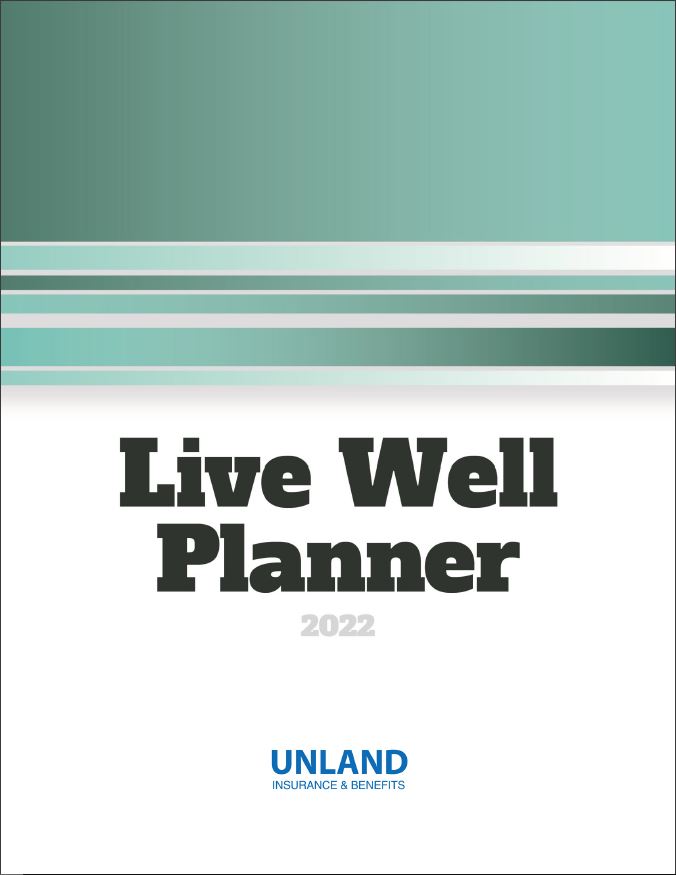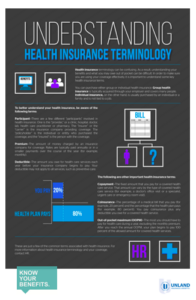Good Advice
- April 15, 2024

How to Prevent Mold in Your Home
Mold can wreak havoc on your home and lead to significant property damage and financial losses. Mold can also cause various health issues for you and other members of your household, potentially leading to medical complications and expenses down the road.
In addition to the various potentially harmful impacts of mold, these issues can arise from many different incidents or conditions.
March is Flood Awareness Month; now is the time to understand that even a tiny amount of water seeping into your home could easily lead to widespread mold growth. Learning various ways to protect your home and family from mold is essential.
When limiting the possibility of having mold issues in your home, consider the following strategies:
- Keep humidity levels in your home as low as possible, such as by using air conditioners and dehumidifiers.
- Emphasize airflow throughout your home by using fans and ensuring ventilation systems function properly.
- Inspect your home’s roof, walls and plumbing, and fix any cracks or leaks as soon as possible.
- Clean up any water damage, spills or other moisture promptly.
- Tear up any carpeting contaminated by floodwater or sewer water, or that cannot be dried out within 48 hours.
- Avoid having carpeted floors in areas prone to excess moisture, such as bathrooms and basements.
For more home maintenance and safety guidance, contact us today.
0 - April 8, 2024

The Importance of Adequate Roof Drainage
Effective roof drainage is vital for maintaining the structural integrity of a commercial building. Drainage systems play a pivotal role in efficiently eliminating water and debris from a roof, as well as directing the water away from the building. Despite their importance, proper upkeep of these systems is often ignored.
Inadequate maintenance of these systems can cause various types of property damage. This article provides insight into the significance of maintaining adequate roof drainage and outlines steps to prevent avoidable damage to these systems.
Why Is Roof Drainage Important?
Effective roof drainage is crucial for redirecting rainwater and melted snow away from a building, which prevents water from accumulating on, in or around the building and causing structural problems
Poor drainage may lead to leaks, foundation damage, roof rot and mold growth, all of which threaten structural integrity. Therefore, implementing efficient roof drainage solutions is essential for ensuring the enduring stability and functionality of any building.
Types of Roof Drainage Systems
The initial step in safeguarding your building against water damage involves understanding its roof drainage system. The following are some roof drainage systems commercial property owners should be aware of:
- Gutters and downspouts—These guide water away from roofs and buildings, shielding the exterior and the foundation from potential harm while preventing water from running directly down the building’s sides to the foundation.
- Internal drains—These drains channel water from the roof into pipes within the building, typically discharging into a storm sewer system. Internal drains are normally used on flat roofs.
- Roof scuppers—These are normally positioned around a building’s perimeter on a flat or low-sloped roof, facilitating water drainage into downspouts. They are usually adjacent to metal boxes that act as flashing, directing water to flow through the wall.
For these drainage systems to work, business owners must make sure they are inspected and well maintained.
Common Roof Drainage Issues
The roof endures more exposure to environmental elements than any other part of a building. Such elements could hinder the effectiveness of roof drainage systems by being clogged by debris, leaves and branches and ice, especially after a severe storm. If downspouts are clogged, both flat and slanted roofs can experience the presence of standing water. An inch of standing water can add 5 pounds of weight per square foot on a roof, adding up to thousands of pounds of extra weight on a roof, potentially compromising structural integrity.
Even on a slanted roof, if drains or gutters are obstructed, standing water can accumulate and may lead to issues in the foundation or basement. In addition, standing water compromises roofing materials like shingles and can penetrate underneath the flashing and sealants, causing leaks. This is especially important in freezing temperatures, as the freeze-thaw cycle can induce cracking, allowing water to enter the interior of the building.
Maintenance Best Practices
To ensure the proper operation of roof drainage systems, business owners should follow these maintenance tips:
- Conduct inspections and clean the roof drainage system during the spring and fall seasons. If trees are overhanging the roof, inspections should be performed more frequently. Additionally, inspect the roof after any roof-related contractor services. Professional gutter maintenance services are available to aid business owners
- Trim trees to prevent branches from rubbing against the roof and gutters. Trimming trees can also help prevent leaves and debris from clogging drains and gutters.
- Run water through the downspouts to ensure there are no clogs.
- Remove shingle granules from the gutters as they can alter the gutter’s slope when accumulated, obstructing the natural flow of water due to gravity.
- Check for persistent standing water in gutters and rectify any blockages causing this condition. If no blockages are present but standing water persists, it indicates that the gutter is not correctly sloped toward the downspout.
- Inspect all drainage systems for leaks and ensure they are fixed.
- Drainage systems should be inspected and deemed operational following severe weather events.
- Check gutters to make sure they are properly sealed; leaks can cause water to drain down the side of the building and potentially enter the building.
- Ensure downspouts are far enough away when discharging water that the water is not pooling near the building. Business owners should make sure the downspouts are being used to prevent water accumulation near the building’s perimeter.
- Consider installing larger gutters when replacing these systems to accommodate greater water flow.
- Use noncombustible metal gutters and downspouts in areas that may be exposed to wildfires. They must always free from debris that could potentially ignite.
- Use gutter straps on drainage systems that are specifically engineered to withstand strong winds if located in an area exposed to hurricanes or high winds.
All buildings need their roof drainage systems inspected regularly and will need to be updated eventually.
By understanding a roof’s drainage exposures, business owners can be proactive in maintaining their roofs and be able to select the system that will work more efficiently for their building when it is time to update. Overall, business owners can maintain the structural integrity of their buildings by following these best practices for drainage systems.
Contact us today for more risk management guidance.
- March 13, 2024

Navigating the Cyber Insurance Claims Process
Cyber incidents—including data breaches, ransomware attacks and social engineering scams—have become increasingly prevalent over the past decade, impacting organizations of all sizes and industries. These incidents are only expected to become more damaging and devastating in the years ahead, making it difficult for organizations to recover. In fact, global cyber economy researcher and publisher Cybersecurity Ventures projected that the cost of cybercrime could surge to $10.5trillion by the end of 2025—more than tripling from $3 trillion in 2015. Considering these findings, it’s vital for employers to secure sufficient cyber insurance. Also known as cyber liability insurance, such coverage can help pay for a range of first- and third-party expenses (e.g., incident response and data recovery services, legal fees, lost income, reputational damage and regulatory defense costs) that may result from cyber incidents, thus mitigating the risk of large-scale financial losses when these events occur.
When a cyber incident strikes, it’s important for employers to know how to navigate the claims process and understand what their insurance may cover. In doing so, organizations can ensure a timely and cost-effective recovery, keeping related damage to a minimum. Although no two claims are the same and specific response measures may vary based on the nature of anincident and its associated losses, this article outlines four general steps for organizations to take amid the cyber insurance claims process.
Step #1: Notify important parties.
As soon as an organization identifies a potential cyber incident, whether it’s via threat detection software or an employee report, it should carefully assess the situation to determine the validity of the incident. Upon validation, the employer should swiftly execute their cyber incident response plan by contacting necessary parties (i.e., the local authorities, the cyber insurer and the broker) to kickstart the investigation and insurance claims process.
Notifying these parties is crucial for several reasons. Not only does it allow the organization to receive prompt assistance when a cyber incident occurs, but it may also be required to ensure coverage for the related losses. In particular, many cyber insurers mandate their policyholders to contact them immediately upon discovering an incident, typically before taking any other steps or incurring any additional costs, to maintain coverage. As such, failure to notify the insurer in a timely manner can expose the organization to possible complications in the claims process or even a denial of coverage. That’s why the employer should carefully review their policy to understand specific provisions regarding the discovery of a cyber incident and the required timeline for notification.
When it comes to notifying necessary parties, the organization should be prepared to provide in-depth information and resources regarding the overall scope and severity of the cyber incident. This will help the local authorities understand how to move forward with their investigation and give the cyber insurer and broker the details needed to streamline the claims process. Key information and resources may include a current narrative of events, documented proof of the incident and a calculation of associated losses. Because such information and resources can change as the incident develops, the organization should continue collecting details in real time and update necessary parties as needed.
Step #2: Coordinate with vendors.
After the employer notifies the necessary parties about the cyber incident, they should coordinate with various vendors to help remediate the situation and minimize related damage. Depending on the organization’s cyber insurance policy and particular preferences, it may select these vendors independently (as outlined in its cyber incident response plan) or obtain referrals from the insurer and broker. Therefore, the employer should be sure to communicate with the insurer and broker before moving forward with any vendors. In some cases, insurers may even require policyholders to receive explicit consent regarding vendor selections to prevent possible coverage exclusions. This is because some insurers have pre-negotiated rates with certain vendors, which can help minimize the costs incurred during claims. There are multiple vendors for the employer to consider, each playing a different role in handling the incident. Key vendors include the following:
- Legal counsel—An attorney who specializes in cybersecurity, also called a breach coach, can assist an organization in determining applicable data compliance standards for recording and reporting the loss or exposure of sensitive information. This attorney may also help the organization coordinate with other vendors and set up any necessary services (e.g., credit monitoring applications and call centers) for stakeholders or other individuals affected by the cyber incident.
- Forensic investigators—In addition to working with the local authorities, the employer can consult forensic investigators to look into the cyber incident further, identify the perpetrators and assist with data recovery. These investigators can also help the employer prepare and uphold the integrity of any digital evidence associated with the incident. Such evidence may be particularly useful amid any legal proceedings involving the incident.
- System recovery professionals—While forensic investigators can help the organization recuperate data impacted by the cyber incident, system recovery professionals can support the organization’s IT department as it works to restore any compromised networks, servers and technology. In turn, these professionals can ensure the organization resumes normal operations as quickly as possible, therefore reducing downtime and limiting lost income.
- Crisis communication experts—The employer can utilize crisis communication experts to adopt a plan for handling any public relations concerns related to the cyber incident. In other words, these experts can work with the organization to deliver appropriate post-incident communications to regulators, affected parties and the general public, thus helping the organization meet applicable breach notification requirements and minimize the risk of widespread reputational damage.
Step #3: Mitigate the incident and document associated expenses.
Upon coordinating with its selected vendors to fully mitigate the cyber incident, the organization should work closely with its broker and the insurer’s key representatives, namely the claims adjuster, to calculate the total expenses incurred amid the event and determine coverage capabilities. This entails keeping detailed records of all associated damage and restoration costs. Here are some important expense-related records for the organization to hold on to:
- Vendor invoices and statements of work (SOWs)—The employer should ask every vendor they coordinate with to provide detailed invoices and SOWs that summarize the work being performed, highlight daily progress on this work and break down each component of the final bill. Further, the employer should clearly distinguish which aspects of every bill pertain to restoration costs versus improvement expenses. This is a crucial step, as most cyber insurers will only offer coverage for restoring systems and operations to the status they were in prior to a cyber incident rather than enhancing these elements beyond their original state. Moreover, neglecting to separate such costs could cause difficulties and delays during the claims process, extending the overall recovery timeline and prolonging the final payout from the insurer.
- IT receipts—In addition to keeping vendor invoices and SOWs, the organization should maintain any documentation of IT purchases made throughout the recovery process. This may include the cost of repairing damaged systems or replacing hardware that couldn’t be recovered with comparable solutions. Receipts should be separated based on the nature of each purchase; those related to system restoration will likely receive coverage, whereas those associated with upgrades to the IT landscape (e.g., enhanced security software) may not. Additionally, the organization may find it useful to distinguish between purchases that provided permanent IT solutions (e.g., the replacement of corrupted devices) versus temporary fixes (e.g., the interim use of alternative technology to reduce operational downtime).
- Business interruption calculations—Depending on the specific details and severity of the cyber incident, the organization may incur minor or major business interruption expenses throughout the recovery process, especially relating to lost income. Because most organizations affected by cyber incidents are usually able to reinstate their key operations within a matter of days, cyber insurers often heavily scrutinize business interruption calculations and related expenses. In some cases, cyber insurers may even leverage forensic accountants to review these expenses further. As a result, it’s critical for the employer to consult their sales and operations teams to ensure accurate calculations and foster open communication with the insurer’s representatives to reach a positive outcome. The most valuable business interruption expenses for the organization to document include diminished production capabilities, operational inefficiencies caused by temporary workarounds, lost or canceled orders, permanent contract losses, and prolonged downtime that allowed customers or clients to purchase products and services from competitors.
- Other recorded expenses—The employer should record all remaining expenses incurred amid the cyber incident, such as temporarily elevated production and labor costs that helped make up for downtime. In the event that the incident prompted a lawsuit or attention from regulators, any additional legal fees (e.g., defense costs) and penalties should also be documented.
Altogether, keeping detailed documentation of all expenses related to the cyber incident can help the organization promote amore seamless claims process and confirm that the insurer’s representatives have the necessary resources to provide an accurate payout.
Step #4: Resolve the claim and determine key takeaways.
Finally, the employer should provide any additional information the insurer requests to help resolve the claim as quickly as possible. Upon receiving the final payout, the employer can review the cyber incident as a whole and identify key takeaways. This typically involves conducting a post-incident analysis. Such an analysis should focus on where the cyber incident originated; how it was detected; how effective the incident response plan was in handling this event; and the different technical, operational and financial impacts of the incident. Depending on the cyber incident’s origin and associated losses, it may also be worthwhile to evaluate whether any organizational failures or shortcomings played a role in the event.
The results of the post-incident analysis will guide the organization’s identification of cybersecurity weaknesses and its effort to fill possible gaps with bolstered defenses. Doing so is critical to help prevent future cyber incidents and minimize related expenses. Necessary adjustments may include modifying the cyber incident response plan, updating or introducing new software, and implementing stricter security policies. Based on the outcome of the claim, the employer may also want to consult their broker to determine whether any coverage adjustments are necessary to ensure ample protection for cyber incidents going forward.
Conclusion
By having a deeper understanding of the cyber insurance claims process, organizations can navigate potential incidents with ease and keep related losses under control. Contact us today for more risk management guidance and insurance solutions.
- March 6, 2024

Tips for Auto Insurance Buyers in 2024
Insurers face challenges in ensuring adequate rates while navigating regulatory restrictions and competition. As a consumer, it’s essential to be knowledgeable about these factors and consider strategies for reducing
expenses without sacrificing coverage quality.Auto insurance is an ongoing and nonnegotiable expense for drivers. The following are proven ways to help reduce these costs without compromising on necessary coverage:

Research discounts. Many insurance companies offer discounts you may not be aware of. Your agent can help identify discounts that may apply to your situation.

Embrace safe driving programs. Numerous insurance companies reward safe driving. By joining these programs, your premium may align more closely with your actual driving habits.

Increase your deductible. Talk with your agent to understand how much a higher deductible may lower your premiums.

Consider usage-based insurance. Usage-based insurance (UBI) tailors your premium based on your driving patterns. UBI could offer substantial savings if you drive infrequently or have safe driving habits.

Take a defensive driving course. Some insurers and states offer discounts for completing a defensive driving course.

Choose a car model that is cheaper to insure. Next time you’re in the market for a new car, talk with your agent to identify vehicles that are likely less expensive to insure.

Change your payment method. Choosing online payments, paperless billing and automatic payments can lead to discounts. Paying your annual premium in full, rather than monthly, can also result in savings.
Our agency is here to help you navigate the changing insurance market. Reach out to us today to learn more about how we can help you find the auto policy that’s right for you.
- February 2, 2024

Fire Prevention Measures for Idle and Vacant Properties
When properties are left idle or vacant, the risk of fire-related incidents increases. Therefore, implementing a comprehensive fire prevention strategy is crucial. This article explores essential fire prevention measures for idle and vacant properties to ensure the safety of the premises and minimize the risk of destructive fires.
Fire Prevention Measures
Businesses should consider the following fire prevention measures for their vacant and idle buildings:
- Keep sprinkler systems operational. It’s imperative to ensure sprinkler systems on the property remain in service. Regular inspections are key, including weekly recorded checks of sprinkler control valves to confirm they are locked in the open position. Additionally, fire extinguishers and other fire-protection equipment should be inspected weekly.
- Perform quarterly sprinkler system testing. Fire-protection system alarms, including sprinkler control valve and water-flow alarms, should be tested quarterly to verify their functionality.
- Conduct heat inspections. If the heating system is still functional in a vacant building, it should be inspected regularly to make sure everything is working properly to avoid a fire hazard.
- Maintain landscaping. Keep the property’s exterior well-maintained. This includes cutting grass to a height of 3 inches or less, clearing brush and weeds from around buildings and service equipment, and promptly removing any waste materials that can fuel fires.
- Secure hazardous operations and remove combustible materials. For operations involving flammable liquids or equipment, take precautions such as turning off electrical equipment and securing utilities that won’t be in use. Additionally, remove flammable chemicals and other combustible materials from the property when possible.
- Coordinate with the fire department. Invite the local fire department for a pre-fire planning session to establish emergency protocols in case of a fire. Ensure they are familiar with all operational sprinklers and alarms and provide them with access keys or designated meeting points for easy response during alarms.
- Contact law enforcement. Notify local police departments if a building is vacant. Doing so can allow law enforcement to monitor the property regularly and help deter arson and other crimes.
- Increase security measures. To deter potential vandals or intruders and prevent arson, make the property appear occupied. Maintain the exterior by mowing lawns, trimming shrubbery and removing snow. Add extra locks, lighting, alarms and fencing where necessary. Regular checks for signs of break-ins are essential.
- Prevent freeze-ups. Provide adequate heat to the vacant or idle building to prevent freezing of fire-protection equipment, such as water supply tanks and sprinklers.
- Inspect the premises. Ensure that regular inspections of the building, as well as the perimeter of the property, are performed to check for break-ins or other hazards. In some cases, hiring security firms to perform inspections may be appropriate.
Conclusion
By diligently following these fire prevention measures, property owners and managers can significantly reduce the fire risks associated with idle and vacant buildings to preserve both the structure and safety of their surrounding communities. Fire prevention remains a shared responsibility that calls for proactive planning and ongoing vigilance to protect properties from potential disasters.
For more risk management guidance, contact us today.
- January 8, 2024

7 Key Employee Benefits Trends in 2024
Attracting and retaining employees has challenged employers since the onset of the COVID-19 pandemic. In 2024, the labor market is expected to cool slightly; however, competition for talent will remain. As such, employers must remain agile and adapt to developing labor and market trends that will shape the market in 2024. In particular, current labor challenges are forcing employers to find ways to balance rising health care costs and inflation while providing employees with benefits they value and need. Understanding this year’s key employee benefits trends can help employers attract and retain talented individuals in an evolving labor market.
This article discusses seven key employee benefits trends in 2024.
1. Managing Health Care Costs
High inflation, provider shortages, an increase in serious chronic conditions and deferred care due to the pandemic continue to drive health care costs. According to several industry surveys and reports, employers anticipate health care costs to grow between 6% and 8.5% in 2024, the largest increase in more than a decade. This year, employers may struggle to mitigate skyrocketing health care costs while keeping benefits affordable for employees. Thus, many employers will plan and implement multiple cost-saving strategies in 2024 to mitigate rising health care costs, such as:
- Modifying health plan designs
- Incorporating health care analytics
- Using artificial intelligence to streamline administrative workflows, help employees make informed benefits decisions and decrease costs
- Implementing pharmacy management strategies
- Maintaining full coverage of recommended prevention and screening services
- Tailoring benefits to meet employees’ specific needs
- Expanding voluntary benefits offerings
- Improving employee health care literacy
- Investing in more virtual health opportunities
- Incentivizing employees to seek cost-effective care options
- Revisiting cost-sharing arrangements
2. Increasing Personalization and Flexibility
The modern workforce is comprised of four or five generations of workers from various backgrounds. In 2023, many employers struggled to find a benefits plan that satisfied their entire workforce. According to the Life Insurance Marketing and Research Association’s 2023 Workforce Benefits Study, nearly a third of all employers said that meeting the needs of their multigenerational workforce was a primary challenge. In 2024, employers will increasingly offer personalized and flexible benefits to address the unique needs and expectations of individual employees. The following are popular options for benefits customization:
- Flexible spending accounts
- Flexible work arrangements
- Customized retirement plans
- Convertible paid time off
- Domestic partner benefits
- Broader medical coverage
- Expanded leave
- Diverse wellness programs
- Personalized learning and development opportunities
3. Prioritizing Employee Mental Health
Employee mental health is a priority for many employers in 2024. Countless employees are experiencing a combination of mental health concerns, including stress, lack of motivation and reduced focus. High inflation and widespread financial stress are exacerbating these issues, impacting workplace productivity, retention and morale. Given the impact employees’ mental health can have on an organization, employers are considering employees’ mental health while making important business decisions in 2024. To this end, savvy employers will continue prioritizing employee mental health in 2024 with the following methods:
- Finding specialized mental health treatment from chosen vendors
- Providing meditation and mindfulness resources
- Expanding employee assistance programs to address burnout and other mental health challenges
- Offering virtual therapy sessions
- Providing managers with training to recognize employee behavioral issues
- Expanding mental health service offerings
- Investing in programs that build resiliency and improve coping strategies
- Conducting anti-stigma behavioral campaigns
4. Focusing on Belonging
While more employers invested in diversity, equity and inclusion (DEI) initiatives in 2023, many employees—especially those from underrepresented and marginalized groups—continue to feel excluded. These emotions can undermine work performance, inhibiting creativity, participation and willingness to collaborate. They can also increase the risk of burnout and stress, leading to increased turnover and higher rates of absenteeism
In 2024, employers are expected to address belonging to bridge the gap between existing DEI initiatives and the impact felt by employees. With that in mind, many employers are more often focusing on the factors that impact workplace belonging, such as organizational culture, leadership behaviors and personal relationships among employees. Others are introducing initiatives to foster belonging, such as:
- Encouraging supervisors to check in with employees
- Promoting social bonds within the organization
- Encouraging open-door policies
- Creating time for employees to connect socially
- Facilitating trusting relationships (e.g., mentorships)
- Celebrating employee achievements
- Involving employees in critical business decisions
- Creating fair and transparent compensation and promotion practices
5. Expanding Family-building and Reproductive Health Benefits
Reproductive health care benefits became a key issue for employers in 2023 after the U.S. Supreme Court’s Dobbs v. Jackson Women’s Health Organization decision ended federal protections for abortion rights and permitted states to implement their own regulations. Numerous employers will continue to expand reproductive health benefits in 2024 to meet employee needs and remain competitive.
Additionally, more employers are offering family-building benefits, as they have proven to be highly valued among employees who are looking to start or build their families. The impact of these benefits also often extends beyond affected individuals to make employees feel welcomed and supported in the workplace, improving engagement, productivity and retention. In the next year, many employers are expanding benefits offerings to include the following:
- Paid parental and adoption leave
- Child care subsidies
- Flexible scheduling and remote and hybrid work options
- Surrogacy benefits
- Family planning assistance
- High-risk pregnancy care
- Pregnancy, lactation, postpartum and menopause support
- Testosterone deficiency treatments
- Employers providing legal reproductive care benefits should assess the implications of these offerings as reproductive healthcare laws continue to evolve.
6. Balancing Flexibility With Return-to-Office Mandates
Many employers responded to 2023’s tight labor market by offering remote and flexible work opportunities. As some employers begin issuing return-to-office mandates in 2024, organizations that are rigid in their policies may risk losing talented individuals and DEI efforts. They may also struggle to attract new employees from a smaller talent pool. As such, in 2024, proactive employers will focus on balancing employee expectations and needs with the benefits of having employees in the office. For instance, they may offer hybrid work options as a compromise for employees who are happier and more productive with flexible work arrangements.
Additionally, employers are increasingly focusing on creating safe, empathetic and transparent workplace environments to promote employee well-being as they return to the office. Some employers are also offering incentives for in-person employees, such as:
- Commuter benefits
- Child care benefits
- Catered meals
7. Prioritizing Preventive Care Services
In 2023, record-high inflation and skyrocketing medical care costs prevented numerous employees from seeking necessary preventive care for fear of incurring medical debt. However, avoiding medical care can worsen long-term health outcomes and increase costs for both employers and employees by preventing the early detection of serious illnesses. As employers struggle to mitigate rising health care costs in 2024, many will focus on keeping employees healthy and providing benefits education to help guide them on their journeys to be educated health care consumers, maximize their benefits and understand the importance of routine care.
Summary
Although every workplace is different, employers who understand current benefits trends will be better equipped to provide employees with the benefits they desire and need. In an evolving labor market, an attractive benefits plan is critical to maintaining a healthy, happy and productive workforce, which can ultimately impact organizational productivity, engagement and revenue.
Contact us today for more benefits resources.
- December 18, 2023

Protecting Your Building and Occupants From Vehicle Crashes
Vehicle crashes into buildings can result in severe property damage, which can lead to expensive repairs and business interruptions. In a worst-case scenario, such accidents can cause injuries or even fatalities. As a business owner, it is crucial to take proactive measures to protect your property from these incidents. This article aims to help you understand how to evaluate the risk of vehicle accidents to your property, implement protective measures, ensure regular maintenance and testing of barriers, and educate and train occupants to safeguard your business.
Assessing the Risk
Assessing the risk associated with your building is a critical first step in developing an effective safety strategy for business owners. This process involves a comprehensive evaluation of various factors that could pose potential risks to your property. Key factors to consider include the following:
- Building design—Identify potential vulnerabilities and areas where vehicles could pose a threat by examining the building’s design and layout. Look for weak and vulnerable building materials such as large windows or glass facades, unreinforced masonry or lightweight construction. Also, check for inadequate visibility caused by landscaping or other obstructions blocking the view of the building from the road as well as inadequate signage indicating the proximity of the building to the road.
- Proximity to roads—To minimize the risk of vehicle crashes, consider the proximity of your building to nearby roads, streets and highways. Evaluate the distance between your building and the road and the type of road. Buildings near busy roads or intersections face a higher risk of accidents. Assess the traffic volume and research historical accident data for your area.
- Proximity to parking lots—Buildings near parking lots or garages where vehicles frequently move in and out are at an increased risk. Drivers are frequently required to maneuver their vehicles in tight spaces, increasing the risk of misjudging distances or making mistakes.
- Traffic patterns—Consider the traffic patterns around your property. Watch out for intersections, sharp curves or turns and nearby school zones or pedestrian areas. These areas tend to have a higher incidence of accidents.
- Building use—The type of business or activity conducted can affect the risk level of your building. Factors to consider include foot traffic, property visibility and proximity to potential hazards (e.g., gas stations and intersections).
Implementing Protective Measures
To safeguard your building against vehicle crashes, you have various options at your disposal. Each choice comes with its own set of benefits, and its appropriateness depends on your specific needs and preferences. Examples of protective measures include the following:
- Bollards—Vertical bollards, which are made of steel, concrete or plastic, can be fixed or removable. They provide a reliable way to redirect or halt vehicles from colliding with buildings and pedestrians.
- Concrete barriers—Concrete barriers are highly effective at preventing vehicles from crashing into your building and can be used for temporary or permanent protection due to their durability and weight.
- Planters and decorative barriers—If aesthetics is a concern, you can select decorative planters or barriers that blend with your property for both beauty and protection.
- Fencing—Heavy-duty fencing can provide a level of protection. Combining heavy-duty fencing with bollards or barriers is even better, as it can provide an extra layer of security.
- Appropriate parking—Parking spaces situated directly in front of buildings can present a substantial risk. One of the most prevalent reasons for storefront crashes is pedal error. Consequently, it is advisable to minimize the presence of parking spaces near your building to reduce the likelihood of these incidents.
Maintenance and Testing
Maintaining and testing your protective barriers is essential to ensure they remain effective. Regular inspections and upkeep may help identify and address any issues. Here are some key considerations regarding maintenance:
- Regular inspections—Schedule routine inspections to check for wear and tear, damage or signs of deterioration.
- Testing procedures—Periodically test your protective barriers to verify their functionality. For example, conduct crash
tests or vehicle impact simulations to ensure they perform as intended. - Immediate repairs—If any damage or issues are identified during inspections, address them promptly to maintain the barrier’s integrity.
Educate and Train Building Occupants
Building protection is not solely the responsibility of the business owner; all occupants must be educated on safety measures and emergency procedures. Consider the following steps:
- Create an evacuation plan. Develop an evacuation plan that includes designated exit routes and assembly points in the event of a vehicle crash.
- Conduct safety drills. Regularly practice vehicle crash scenarios with your employees to ensure they know how to respond effectively.
- Raise awareness. Hold safety training sessions to educate employees on risks and the importance of following safety protocols.
- Provide emergency contact information. Ensure all occupants have access to emergency contact information, including local emergency services and building management.
Conclusion
Protecting your building from vehicle crashes is a crucial aspect of property management for business owners. To minimize the risk of costly accidents and ensure the safety of your employees and customers, it is important to assess the risk, implement effective barriers, maintain protective measures, and educate and train employees and occupants. Not only can you protect your property by investing in these measures, but you can also demonstrate your commitment to safety and responsible business practices.
- November 13, 2023

Know Your Insurance: Home
Are You Properly Protected Against Your Liability Risks?
Hosting events at our homes, such as cookouts and seasonal celebrations, can be enjoyable and rewarding. While these events can be a lot of fun, they can also increase your liability risk, particularly if you have a pool or other attractive nuisances on your property.
Understand Your Homeowners Liability Limits
Homeowners insurance is designed to help provide financial protection from damage to your home and personal property and liability claims arising from accidents or injuries occurring on your property. However, it’s essential to understand that this coverage has dollar limits, and you may need to purchase additional protection if you have higher liability risks.
For example, if you have a pool, fire pit or another attractive nuisance on your property, you may need to increase your liability coverage limits to ensure you are adequately protected.
You should review your homeowners insurance policy carefully and discuss your liability limits with your insurance agent. Your agent can help you understand your coverage options and recommend additional protection if necessary.
What Is an Attractive Nuisance?
Attractive nuisances are items or features on your property that may be attractive to visitors, such as a pool, trampoline, playhouse, fire pit, outdoor grill or swing set. These items can pose a significant liability risk, as children may be tempted to play on them unsupervised, leading to accidents or injuries.
For example, a child may be tempted to climb over a fence to swim in your pool, even if they don’t know how to swim. If the child is injured, you could be held legally liable for their injuries or death. Uninvited guests who are injured on your property may also trigger liability.
It’s important to take steps to secure any attractive nuisances on your property to protect yourself against these types of liability risks. For example, you may need to install a fence or other barrier around your pool to prevent unsupervised children from accessing it. You may also need to post warning signs or take additional precautions to ensure visitors understand the risks.
Your agent can help you understand your insurer’s requirements regarding attractive nuisances and how to best provide appropriate warnings for visitors.
How Can an Umbrella Policy Help?
Even if you have taken steps to secure any attractive nuisances on your property and you have appropriate homeowners liability limits, you may still be at risk of a large liability claim if someone is injured on your property. In these situations, an umbrella policy can help provide additional protection.
An umbrella policy is a type of insurance designed to help cover third-party injury and property damage claims that exceed the limits of your other liability policies. If you are sued for a liability claim that exceeds your homeowners liability limits, your umbrella policy may help cover the additional costs.
For example, if you have a homeowners liability limit of $500,000 and are sued for $1 million in damages, your homeowners insurance may help cover the first $500,000. However, if you have an umbrella policy with a limit of $1 million, it can help provide financial protection by helping to cover the remaining $500,000 in damages.
Umbrella policies are typically sold in increments of $1 million and can be a cost-effective way to increase your liability protection. Your insurance agent can help you determine whether an umbrella policy is right for you and recommend an appropriate coverage limit.
Contact Your Agent Today
If you host events at your home and want to ensure that you’re properly protected against liability risks, it’s important to discuss your homeowners liability limits and the potential for a personal umbrella policy with your insurance agent.
Don’t wait until it’s too late—take action now to protect yourself and your family. Contact The Unland Companies today to ensure you have sufficient liability coverage and explore your options for getting additional liability protection with an umbrella policy.
- October 17, 2023

COBRA Administration Outsourcing
The Consolidated Omnibus Budget Reconciliation Act (COBRA) is a federal law that provides for the temporary extension of employer-sponsored group health coverage for employees and their family members (qualified beneficiaries) in certain situations. COBRA coverage is available when qualifying events occur, such as termination of employment or divorce.
Due to the complexities of the law and potentially serious consequences for mistakes or violations, many employers outsource COBRA administration to a third-party administrator (TPA).
Reasons to Outsource COBRA Administration
COBRA’s complex rules and requirements, mandatory notices and multiple deadlines can be difficult to follow and administer, whether you are a large company and have many qualifying events to keep track of, or you are a small organization that rarely has to deal with COBRA. Here’s why many companies outsource COBRA administration and why you might consider finding a TPA to handle your COBRA obligations:
- It’s complicated. COBRA typically applies to employers with 20 or more employees, although how that number of employees is defined can be complicated if you have fluctuations of employee numbers throughout the year or numerous part-time employees. If your company is subject to COBRA, understanding and keeping track of the various requirements can be difficult. You will need to correctly administer things like required notices, election and payment deadlines, late and partial payments, different coverage periods, changes to plan options, address changes and terminations of coverage.
- It can be costly. Both the Internal Revenue Service (IRS) and U.S. Department of Labor (DOL) oversee COBRA-related laws. Both the IRS and DOL can levy fines and taxes, including fines of $110 per day just for the failure to properly issue COBRA notices and requested documents. The risk of missing a deadline for a notice or disclosure is high, especially if you don’t deal with COBRA frequently. In addition, you run the risk of individuals suing you for COBRA mistakes. Employers who do not administer COBRA coverage correctly can also be held responsible for paying individual health claims for qualified beneficiaries.
- It’s time-consuming. The knowledge and expertise needed to properly administer COBRA requires extensive training. Combined with the time expended by internal HR employees to actually administer COBRA, the amount of training necessary is often disproportionate to the number of qualifying events. COBRA administration can be stressful and time-consuming, and dealing with COBRA in-house is often an inefficient use of HR’s time and resources. On the other hand, if your company experiences high employee turnover or numerous qualifying events, you could be overwhelmed by the amount of work required by COBRA, taking away valuable time from other essential duties. Due to the complexity of COBRA, the high risk of fines, taxes and lawsuits, and the inefficient use of HR’s time and effort, COBRA administration is a prime candidate for outsourcing.
Considerations When Choosing a COBRA Administrator
If you do choose to outsource COBRA administration to a TPA, you will want to consider a few qualities as you choose a TPA:
- Compliance expertise—COBRA compliance depends on the prompt implementation of federal guidelines and regulations that stipulate what needs to be done and when it must be completed. Check that your TPA is well-respected for its expertise, follows written procedures and includes independent monitoring to ensure full compliance with COBRA regulations.
- Technological advancement—Generally, you will want to find an organization that is well-equipped with technology to handle on-time electronic delivery of all the required notices and letters. A good technological system will streamline the COBRA compliance process and provide proof that all deadlines were met. In addition, the system should be secure and encrypted to protect the privacy of information.
- Customer service competence—Assessing the TPA’s level of customer service is also important. Having a good TPA can protect your company from having to deal with disgruntled ex-employees. Also, good customer service from your TPA will reduce the incidence of employee complaints about how COBRA is being handled.
- Legal accountability—Another important consideration is the indemnification protections provided in the contract. Although a TPA will never be able to take on all legal risk of COBRA administration, it should stipulate in the contract that the TPA takes financial responsibility for its own mistakes. Of course, if you fail to notify them when an employee is terminated or reports another qualifying event, you will be responsible for COBRA noncompliance, but a good TPA will relieve you of at least some of the risks associated with COBRA.
Logistics of COBRA Outsourcing
After you have decided to outsource COBRA administration and have chosen a TPA, you will enter into a contract with them. As mentioned above, it is extremely important to review the indemnification process and make sure your company is protected from the TPA’s mistakes. After all, this is probably one of the main reasons you are outsourcing COBRA administration—to cut down on the financial risk resulting from any mistakes.
Although many TPAs are similarly priced, there are often two choices for how you can pay fees. Typically, you will either pay a flat fee per qualifying event or a monthly fee per eligible employee. Companies with low turnover will likely prefer the fee per qualifying event, whereas you might choose the monthly fee per eligible employee if you have high turnover or want to predict your COBRA administration-related spending more closely.
When outsourcing COBRA administration, you will also need to designate someone to serve as a liaison between your company and the TPA. This person will ensure that all qualifying events are communicated to the TPA, field any complaints about the TPA from COBRA-qualified employees, and address any other concerns or communication regarding COBRA administration.
For more information on COBRA administration, contact The Unland Companies today.
- September 15, 2023

Employee Benefits Challenges Faced by HR Professionals
These last few years have been disruptive and caused a lot of strain on HR professionals. As such, HR departments have undergone significant transformations, expanding their scope to encompass key functions like overseeing employee compensation and benefits. As businesses grow and evolve, it becomes crucial to grasp the impact of employee benefits and related challenges on HR teams.
The job of HR professionals is becoming more complex due to shifting employee demands and constant changes. This article explores reasons why HR professionals are struggling with employee benefits.
Employee Attraction and Retention
As talent shortages persist across industries, many employers are grappling with adapting to the “new normal” to address this issue effectively. HR departments are dealing with an inadequate number of candidates or insufficient resources to meet the high demand for candidates. On top of that, more of today’s workers are confidently exploring opportunities at other companies. As a result, many HR professionals realize they need to offer comprehensive and competitive benefits packages and compensation to attract and retain today’s talent.
Keep in mind that even if organizations offer comprehensive benefits, the success of these offerings comes down to how employees perceive their benefits. Some employees may leave a company for “better” benefits, only to find out they already had the ones they were hoping for and may now have less robust benefits. HR professionals can get ahead of this issue by addressing potential benefits education gaps to ensure current employees know about available offerings and how they bring value to their unique lifestyles.
More than ever, HR professionals are working hard to attract and keep more employees. However, creating a benefits strategy that appeals to various ages and demographics is challenging. While health and dental insurance and a 401(k) are table stakes for many organizations, much of the workforce is also looking for options like flexible work schedules and generous paid-time-off policies. The importance of recognizing that different groups of people value varying benefits cannot be understated. It can be difficult to offer benefits that appeal to a multigenerational workforce, but HR professionals can start by surveying current employees to see what they want and need for benefits.
Time-consuming Tasks
Traditional HR departments already handle recruitment, workplace safety, compliance, payroll and employee engagement. Now, many employers are adding time-consuming tasks, such as managing benefit strategies and budgets, to the plates of HR professionals. This can come with more manual tasks, spreadsheets and paperwork. HR professionals face countless benefits challenges, including employee education and enrollment and administration.
To help free up HR employees’ time to focus on more strategic tasks and critical day-to-day work, employers could consider technology, tools or partners for benefits administration. Software platforms, applications or websites can automate otherwise manual processes, saving time and increasing accuracy.
Compliance and Evolving Health Care Regulations
Legislative changes have led to expanded job responsibilities for HR departments. Besides juggling routine tasks such as recruitment and employee relations, HR professionals are now adapting to new roles or learning new skills. For example, these expanded responsibilities could include staying up to date on compliance as it relates to health insurance plans. The influx of rules and regulations, particularly concerning health care, puts employers at higher risk of lawsuits, fines and penalties, making compliance a critical concern.
Inflationary Pressures
Amid high inflation and a potential recession, businesses and workers alike are trying to figure out how to do more with less. Undoubtedly, that includes HR professionals as well. In fact, a 2023 survey by financial wellness benefits provider BrightPlan found that 77% of HR executives report experiencing financial stress. Many are also experiencing unmanageable levels of debt.
HR leaders face the difficult task of supporting employees during tough economic conditions as they deal with the same challenges themselves. HR professionals are often responsible for sharing and communicating about financial wellness benefits to employees but may forget the content and resources also apply to them. While many HR professionals are focused on ensuring employees know about and fully understand the available financial wellness benefits, they may need to remind themselves of these perks and take advantage of available financial resources.
Summary
The benefits landscape is constantly changing, so it’s important for HR departments to stay informed. By fostering collaboration with various departments, staying informed on regulatory changes and employee benefit preferences, and embracing technology-driven solutions, HR professionals can drive their organizations toward success amid a challenging employment landscape.
Contact us for additional workplace resources.
- August 4, 2023

Employee Referral Programs for Small Businesses
As small businesses compete amid ongoing talent shortages, often with fewer resources than large companies, they may need to get creative in their attraction and hiring efforts. As such, employee referral programs are growing as a popular strategy. They are generally successful because employees put their names on the line by endorsing someone else.
This article explores the benefits of employee referral programs for small businesses and strategies for creating and maintaining successful programs.
The Case for Employee Referral Programs
Employee referral programs allow existing employees to recommend candidates for open positions. The idea behind employee referral programs is that candidates brought in this way will be better suited for the organization because the existing employees have already done the pre-screening work. Employees tend to carefully consider possible referrals because they feel accountable to the organization and the person they refer. High performers tend to refer other high performers, which benefits employers.
Current employees can provide information about the company to referred candidates and describe the company culture and employee benefits package, giving candidates a good idea of what working for the organization would be like before being called in for an interview. In this way, referral programs can help save HR, hiring managers and the organization time and money; since the employee knows both the company and the person they refer, this typically leads to a good match for the employer and new employee. In fact, referral programs can reduce hiring time by half compared to traditional hiring methods. LinkedIn reports that while it generally takes a company 55 days to hire a candidate, referred hires only take 29 days. Since referred employees are faster to hire, organizations also save money on internal labor costs or outsourcing.
In addition, employee referral programs also give organizations increased access to passive job seekers. Such candidates may currently be employed and might not have interviewed for a position with the company without a recommendation.
An effective employee referral program can also help support an organization’s reputation as an employer. A strong employer brand enables a company to stand out from others. Employer branding aims to promote an organization as a good place to work, with the target audience being current and prospective employees. Simply put, the employer brand answers, “Do I want to work there?” So, when a current employee is engaged and satisfied at work, they will likely speak positively about the company and encourage their friends and family to apply for open positions.
Strategies for Small Businesses
An effective employee referral program can save small businesses time, money and other resources during hiring. Employers can consider the following strategies for establishing and maintaining such programs:
Make submitting referrals easy.Clear communication is necessary so that employees know how to submit referrals. This process should be simple, allowing employees to send a resume, provide an email and phone number, or submit a standard form to start the referral process.
Incentivize employee referrals. To enhance the appeal of referring friends and family to the company, employers may provide monetary rewards, paid time off or other gifts to current employees who refer quality candidates for open jobs.
Leverage technology. Small businesses may be short on staff, but technology can help manage programs and automate referral processes. Employee referral management systems can help organizations streamline the process. Additionally, artificial intelligence that accesses employee social networks can help suggest suitable matches. HR can then provide these referral recommendations to these employees and ask for a connection to begin recruiting conversations. Employees likely don’t know the skills and qualifications of everyone in their network, but technology can help organizations find ideal candidates quicker.
Keep employees informed. It’s important to keep employees in the loop about the status of their referrals to avoid frustration and increase transparency. For example, let them know when the referral has been received, if interviews are scheduled and where the candidate is in the overall hiring process.
Acknowledge good referrers. Public recognition can go a long way with employees, so small businesses should consider awards or public praise to let employees know they appreciate their effort in sending referrals and being brand ambassadors. As such, public acknowledgment is a cost-effective way to increase referrals.
Think beyond employees. Referral programs don’t need to rely solely on employee referrals. Companies can decide to open the referral opportunity to additional stakeholders, such as retirees and customers. For example, loyal customers may feel like a part of the company and be eager to refer their friends for open roles.
Summary
Because employees know company culture and employee experience firsthand, they are uniquely positioned to understand other workers who would thrive in the environment or perhaps have a similar disposition as themselves. Word of mouth travels fast, so small businesses can use that to their advantage to secure more top talent.
Amid ongoing talent shortages, employee referral programs can be a cost-effective strategy to attract and retain talent, hirefaster and boost employee morale.
Contact us for more information.
- July 11, 2023

Retail Industry Trends to Watch
The retail industry is comprised of businesses that sell goods and services to consumers. Such businesses range in size and may specialize in a variety of product offerings (e.g., groceries, household items, toiletries, clothes, toys and technology). These businesses may conduct their sales within stores, online or through a combination of both methods. In any case, the retail sector plays a critical role in the U.S. economy by employing a substantial proportion of the nation’s workforce and fostering consistent financial growth.
This industry has faced various ups and downs in recent years, largely due to fluctuating consumer habits amid the COVID-19 pandemic, ongoing supply chain complications and rising inflation issues. Yet, the sector has still managed to promote economic growth. In fact, the National Retail Federation (NRF) confirmed that retail sales have risen by more than 7% each year since 2020, significantly surpassing average growth rates over the past two decades. While a slowing economy could limit profit margins going forward, widespread wage increases resulting from a competitive labor market will likely fuel continued consumer spending and boost overall sales.
Nevertheless, several industry trends could pose challenges for retail companies in the coming months and years, including organized retail crime (ORC) concerns, sustainability issues, labor shortages and cyber exposures. As such, it’s important for retail businesses to closely monitor these sector developments and adjust their risk management practices as needed. This article provides more information on retail industry trends to watch.
ORC Concerns
ORC—which refers to large-scale shoplifting incidents or other illegal (and sometimes violent) acts conducted by groups of criminals with the purpose of stealing mass amounts of merchandise—has become a growing concern across the retail sector. According to NRF data, ORC costs retail businesses an average of $700,000 for every $1 billion in sales.
This surge in ORC has predominately been caused by criminals looking to capitalize on the accelerated shift to e-commerce brought on by the pandemic. Specifically, criminals are stealing large amounts of goods off store shelves and reselling them to unsuspecting online shoppers at reduced prices. Additionally, some criminals are infiltrating retail companies’ supply chains and stealing merchandise before it even can reach store shelves to redistribute these items on the black market.
Altogether, the NRF reported that ORC has increased by 26.5% since 2020, serving as a primary driver of retail shrinkage (inventory losses caused by anything other than actual sales) and contributing to nearly $100 billion in annual sector losses. Compounding concerns, ORC will likely become even more prevalent as the economy worsens. After all, financial experts have asserted that retail theft incidents typically jump during periods of economic downturn, as evidenced by an uptick in ORC during the Great Recession from 2007-2009.
In an effort to help minimize ORC concerns, the federal government is in the process of finalizing the Combating Organized Retail Crime Act of 2023. This legislation would provide funding for the creation of a national ORC Coordination Center, as well as allocate resources aimed at establishing theft prevention protocols, technical assistance, employee training and incident response measures at retail companies across the country. In addition to this federal initiative, 34 states have recently passed laws of their own pertaining to ORC prevention and penalties, with more states expected to follow suit.
Apart from this legislation, there are several steps that retail businesses can take to help mitigate ORC concerns, such as conducting preemployment criminal background checks to limit the likelihood of internal theft incidents; enhancing customer service measures (e.g., having employees stationed throughout the store floor and encouraging them to engage with customers) to ensure shoppers are adequately monitored at all times; implementing restricted merchandise return policies to reduce the risk of fraudulent returns; leveraging merchandise sensors, security systems, surveillance cameras and warning signage to deter criminals from stealing items and better identify perpetrators if incidents occur; and training employees on how to detect signs of retail theft and properly respond to these incidents without threatening their personal safety.
Sustainability Issues
Both stakeholders and regulators have placed greater emphasis on environmental, social and governance (ESG) initiatives over the last few years, thus seeking more transparency from businesses regarding their company values and commitments to ethical practices. According to a recent survey conducted by professional services network Deloitte, 6 in 10 retail executives said they believe businesses within the sector will face elevated scrutiny related to their ESG decisions in the year ahead.
Primarily, stakeholders and regulators have begun holding retail businesses to higher standards over the sustainability of their operations. For instance, consumers and investors have grown more conscious of retail companies’ impacts on the environment, including their greenhouse gas emissions and waste management protocols. Additionally, federal regulators have implemented legislation requiring certain businesses to disclose further information on their respective carbon footprints. With this in mind, retail companies that neglect to prioritize sustainable operations could be more susceptible to reputational damage, lost business, litigation issues and compliance concerns.
In order to keep sustainability top of mind and reduce the risk of ESG scrutiny from various parties, retail businesses should consider investing in energy-efficient technology and clean energy sources; implementing green materials and product packaging (e.g., recycled cardboard, corrugated bubble wrap and biodegradable plastics); upholding effective waste management procedures and leveraging recycling, upcycling and composting initiatives to limit total operational waste; evaluating vendors’ ESG practices and adding sustainability requirements to contracts as needed to ensure eco-friendly supply chains; documenting sustainability measures and making this information accessible to other parties; and consulting legal counsel to maintain compliance with applicable ESG legislation.
Above all, retail businesses should prioritize sustainability practices that will help deliver both short- and long-term environmental benefits. Yet, these practices need to be feasible, as setting unrealistic sustainability standards or making unattainable commitments could ultimately pose heightened ESG concerns. In some cases, doing so could even lead to allegations of greenwashing—sharing misleading information regarding the environmental advantages of a product—and subsequent litigation.
Labor Shortages
The past few years have been met with labor shortages across industry lines. Further, the pandemic motivated many employees to reevaluate their job expectations, thus prompting additional workforce adjustments and exacerbating such shortages. The retail sector is no exception to this trend. According to the U.S. Bureau of Labor Statistics, the industry is currently short 870,000 workers. What’s more, the aforementioned Deloitte study revealed that 7 in 10 retail executives believe labor shortages will be their top challenge in the year ahead.
As a result, it’s critical for retail businesses to invest in measures aimed at attracting and retaining employees. These measures may include offering more competitive wages and benefits packages; providing flexible shifts and work arrangements (e.g., hybrid or remote capabilities) when possible; implementing employee assistance programs and other workforce well-being initiatives; and establishing professional development and advancement opportunities (e.g., ongoing skills training, mentorships and promotions) that empower workers to pursue long-term careers in the retail field.
In addition to prioritizing employee attraction and retention strategies, retail companies may also want to utilize technology to increase operational efficiencies and, in turn, mitigate labor concerns. Examples of such technology include self-checkout stations that permit customers to make purchases without employee assistance, mobile applications that allow shoppers to receive automated customer service and digital solutions that permit workers to better track inventory.
Cyber Exposures
As workplace technology continues to advance and e-commerce surges in popularity, cybersecurity has become a rising concern throughout the retail industry. In particular, point-of-sale systems, consumer-facing websites, mobile applications and other software leveraged to conduct retail transactions typically hold a wide range of sensitive customer data (e.g., financial details and contact information), therefore making this technology more likely to be targeted in security breaches, ransomware attacks and other cyber incidents. Additionally, shifting data privacy regulations at both the federal and state levels have begun holding businesses more accountable for their cybersecurity failures.
Amid this evolving risk landscape, retail companies that don’t adopt effective cyber incident prevention and response measures could encounter serious consequences, including lost or damaged technology and data, prolonged business disruptions, reputational issues, stakeholder litigation and large-scale penalties from regulators. To avoid these consequences, retail businesses should consider tactics such as implementing advanced data protection protocols (e.g., access controls, multifactor authentication and encryption); segmenting networks to reduce the likelihood of lateral infiltration; providing routine cybersecurity training to all employees; establishing proper cyber incident response teams and making documented plans for different attack scenarios; partnering with vendors that value cybersecurity; consulting legal counsel to ensure compliance with applicable data privacy laws; and purchasing sufficient coverage to protect against potential cyber losses.
Conclusion
Overall, there are several trends currently impacting the retail sector. By staying on top of these developments and taking steps to mitigate their associated exposures, retail businesses can effectively position themselves to maintain long-term growth and operational success.
For additional, industry-specific risk management guidance, contact us today.
- June 14, 2023

How to Manage Business Risks
A vital aspect of running a small business involves managing its associated risks, as no operations are immune to internal or external threats. A risk management plan involves implementing various techniques that can help mitigate or prevent loss.
There are multiple ways a company can organize its risk management plan, but steps commonly consist of identifying, assessing, and managing risks. Businesses also need to continually monitor and review their policies and procedures to ensure their courses of action remain applicable and relevant.
Types of Risks
There are several types of risks small businesses may encounter, including the following:
- Financial risk involves the possibility that a business may lose money, fail to recoup its initial investment or not maintain the cash flow necessary to continue operations.
- Strategic risk refers to how a business’s decision-making or overall plan may result in loss or a failure to meet objectives.
- Operational risk relates to anything that could impact a business’s day-to-day functions, operations or business activities.
- Reputational risk involves threats to a company’s good name, brand or standing with the public or its clients.
- Hazard risk refers to events that can harm individuals, property or the environment.
- Cybersecurity and fraud risks relate to events that may occur through shortcomings in a small business’s IT or security systems.
- Compliance and legal risk refers to the losses that may arise from a company’s failure to adhere to federal, state or industry regulations.

Risk Management Process
While examples of risks are numerous, a comprehensive risk management plan is key to overcoming them. A plan generally includes the following steps:
- Identify the risk. By carefully examining their operations, businesses can discover several types of exposures that have the potential to create a loss.
- Assess the risk. After identifying threats, businesses can analyze the probability of the risks occurring and their potential severity.
- Manage the risk. Following the risk assessment, a business needs to determine how it will address the risks. Options include:
- Avoidance—Elimination of the risk
- Modify—Mitigating a risk’s impact or lessening the likelihood of it occurring.
- Transfer—Shifting the risk to a third-party (e.g., an insurance company) through a contract.
- Retain—Accepting the risk (or a portion of it) when the risk is
deemed acceptable (e.g., it has a low likelihood of occurring or it would have a minimal impact)
- Monitor and review the plan. A crucial part of the risk management process involves continued monitoring and reviewing of strategies to help prepare for evolving or new hazards.
Risk Management Benefits
Small businesses can receive several benefits from implementing effective risk management protocols. Not only do these protocols mitigate or eliminate potential risks, but they may also lower insurance premiums, as insurers may note how they reduce the business’s likelihood of filing an insurance claim. Insurers may also offer resources to help a business strengthen its risk management practices.
It is never too early to begin risk management planning. Contact us today with any questions or for more information.
- May 4, 2023

The Benefits of Direct Primary Care for Employers
Having a primary care physician is one of the most important things an individual can do for their health, as it helps ensure they receive regular check-ups, aids in preventive care and allows for intervention before more intensive treatment is required. However, according to a recent study by nonprofit organization Kaiser Family Foundation, 17% of women and 28% of men in the United States don’t have a primary care physician. Compounding concerns, there is a scarcity of primary care physicians across many regions of the country, which the Association of American Medical Colleges expects to worsen by 2025.
Many employers recognize the value of primary care for their workers and, therefore, have adopted direct primary care (DPC) arrangements to increase employee access to such care. In addition to improving primary care access, DPC enables employers to manage their rising health care costs without shifting these expenses onto employees, all while ensuring high-quality care.
This article provides a general overview of DPC, including its potential benefits and other considerations for employers to keep in mind.
What Is DPC?
DPC is an alternative health care payment model to traditional fee-for-service insurance that’s intended to improve health care affordability and access to primary care for a flat fee. This is mainly a strategy for self-insured health plans. Under this approach, employers pay fixed monthly membership fees for their employees, which are typically less expensive than most health plans’ monthly premiums. These fees generally cover all primary care costs for employees. As a result, DPC is often more affordable and cost-effective than other forms of health insurance, such as preferred provider organization plans.
Under DPC arrangements, employers typically have no direct relationship with the health care system, meaning there is no third-party billing or fee-for-service payments. Instead, these arrangements center around the relationship between employees and their health care providers, eliminating the need for insurance companies to act as intermediaries to approve procedures and medications. This allows health care providers to have more leeway in determining treatment options for patients, allowing doctors to deliver the attention and care they believe patients need. While DPC arrangements often complement existing group health plans, employers should note that some variations of these arrangements may still require providers to bill through insurance plans and exclude certain primary care services from coverage, including prescription drugs.
What Are the Benefits of DPC?
Employers can consider the following benefits when evaluating whether to adopt DPC arrangements:
Reduced Health Care Costs
DPC arrangements can help employers reduce their health care costs. Instead of paying for each service provided over the course of a year, employers pay a flat fee per employee. Additionally, DPC membership fees are generally much less expensive than typical health insurance premiums. While DPC membership fees can increase over time, they usually increase less frequently than traditional health insurance premiums. Further, because employers do not have a direct relationship with the health care system under DPC arrangements, health care claims are usually easier to manage, which can help minimize administrative costs.
Strengthened Attraction and Retention Efforts
DPC is an attractive benefit for employees because it improves their access to health care and, in many instances, it costs them nothing to visit their primary care doctors. What’s more, the improved access and extra time employees have with their physicians can allow them to build strong, trusting relationships with these doctors, which can ultimately improve their long-term health. As such, by offering DPC arrangements, employers can demonstrate their commitment to employee well-being and bolster attraction and retention efforts. These arrangements are also often more affordable than traditional fee-for-service insurance, therefore allowing smaller employers who otherwise may not be able to afford to offer health insurance to do so.
Improved Employee Productivity and Wellness
Employees typically have improved access to primary care physicians under DPC arrangements, reducing the amount of time they have to spend away from work to receive treatment. In addition to offering virtual or telemedicine services, DPC arrangements generally permit employees to visit their doctors the same or next day when issues arise. DPC physicians also typically offer longer office hours than other physicians, allowing employees to visit doctors after their normal work hours. Additionally, many DPC locations are located near worksites, directly on-site or at shared multi-employer clinics, thus preventing employees from having to miss work or spend excess time traveling to see their doctors.
The average patient spends 121 minutes at each doctor visit, according to research from the American Journal on Managed Care. Of that time, the patient spends 37 minutes traveling and 87 minutes at the clinic. When at the clinic, the patient only spends between 8 and 12 minutes with a doctor. This means that the average patient spends less than 10% of the total time they invest to see their physician receiving care. Fortunately, DPC arrangements provide on-demand services, which means employees spend less time waiting—and, in turn, less time away from work—when they need to see their physicians. By decreasing waiting periods and increasing time spent with physicians, DPC arrangements can encourage employees to see their doctors when needed, addressing health issues and concerns as they arise instead of waiting until they potentially develop into bigger problems. This can help keep employees healthier and more productive.
Further, most DPC providers have significantly fewer patients than other physicians; in many cases, they have less than half the average number of doctors. These smaller patient pools allow physicians to spend more time with their patients, enabling them to unearth possible health issues before they become chronic or catastrophic. Subsequently, patients are less likely to require emergency room or urgent care visits and specialist services. With more time, doctors can better coordinate care and advocate for patients when referring them to outside providers as well.
Employer Considerations
While DPC offers many benefits, there are certain concerns employers should consider when evaluating whether to offer these arrangements. Since DPC only covers primary care services, employers will likely still need to provide employees with additional health insurance to cover specialists, hospitalizations and other health-related emergencies. While DPC arrangements are generally compatible with employers’ group health plans, there are some limitations. For example, DPC plans that cover all primary care costs among employees aren’t compatible with health savings account-eligible high deductible health plans. Further, these plans don’t accept Medicare, Medicaid and other government funds, making them exempt from cost and quality regulations.
DPC is often a location-specific solution. As a result, offering DPC arrangements can be challenging for employers with workforces located in different cities and states. This also makes it more difficult for employees to locate providers. In addition, DPC can hamper an employer’s ability to access medical claims data, potentially limiting their ability to help employees make informed health care decisions.
Summary
Rising health care costs are a major concern for most employers. DPC arrangements permit self-funded employers to reduce their health care costs while improving employee access to treatment. With this in mind, DPC is a cost-mitigation strategy that employers should carefully consider and monitor.
For more health care resources, contact The Unland Companies today.
- April 3, 2023

Assembling an Inflation-proof Benefits Package
Employers are becoming increasingly concerned about inflation’s impact on their employees, especially as the U.S economy faces the very real prospect of an upcoming recession. Many employers are searching for creative solutions to better support employees while navigating a competitive labor market. Many employers are building inflation-proof benefits packages to help employees counter inflation’s impact and address their attraction and retention struggles.
This article outlines employer strategies for assembling inflation-proof benefits packages.
Focusing on Comprehensive Benefits Packages
Many employers’ budgets are shrinking due to the current economic downturn. As a result, employers have fewer resources to allocate to employee compensation and benefits at a time when employee expectations remain high. With limited resources, employers can strategically invest in the benefits employees want and value most, such as cash incentives, flexible stipends, mental health support, enhanced leave options, and financial wellness resources. Shifting to a holistic approach allows employers to provide employees with comprehensive benefits packages that can ease current inflationary pressures.
According to a recent Mercer survey, HR managers reported that they are considering expanding benefits offerings to maximize employee benefit spending in response to inflation. These benefits offerings include:
- Financial wellness programs — Financial wellness programs go beyond retirement preparedness to focusing on all aspects of an employee’s financial well-being. These programs attempt to reduce financial stress as well as repair and increase an employee’s financial health by providing individualized financial guidance. 80% of employers have started addressing employee financial wellness, and 63% expect to increase their financial wellness budget in the next one to two years, according to the Employee Benefit Research Institute’s 2021 Financial Well-being Employer Survey.
- Voluntary benefits — Increasingly, employees expect their employers to provide voluntary benefits as part of a competitive benefits package. Many employers are offering voluntary, group-priced benefits — such as child and eldercare support and student loan repayment assistance — to satisfy employee expectations and remain competitive to attract talent.
- Employee discount programs — Employers are providing employees with one-time or ongoing discounts for services and expenses, such as retailers, restaurants, and professional tax, legal, and financial services. These benefits tend to be popular low-cost recruiting and retention tools for employers.
Establishing Long-Term Strategies
Employers have had to respond quickly to drastic shifts in social and economic conditions over the last few years. However, adjusting to frequent challenges can sometimes lead to organizational shortsightedness or overcorrecting. As most benefits-related decisions typically have lasting impacts, employers need to implement forward-looking strategies to ensure their employee benefits decisions align with their long-term goals. Establishing overarching benefits strategies — such as budgeting for mandatory and optional benefits, forecasting benefits budgets into the future, providing employees access to high-quality providers, focusing on employee well-being, and improving employee engagement — can provide organizations with multiple ways to effectively respond to a wide range of challenges and create inflation-proof benefits packages.
Implementing Innovative Approaches
Employers are currently facing tough decisions related to benefits offerings due to inflation and the current state of the labor market. Some employers are introducing innovative benefits offerings to meet employee needs without increasing costs to employees. These offerings include the following:
- Wellness spending accounts — These after-tax accounts allow employees to allocate money for benefits and expenses they want and need (e.g., gym memberships, student loan repayment programs, ID theft protection, mental and behavioral health support, and supplemental health insurance). These accounts — also known as lifestyle spending accounts — are funded completely by employers.
- Emergency savings accounts — Some employers offer after-tax contributions to employee 401(k) or depository institution accounts. These contributions can be matched or fixed. This benefit offering can incentivize and assist employees to build financial savings and prevent them from dipping into their retirement funds in an emergency.
- Paid time off conversion — Many employers are giving employees more flexibility in how they use their paid time off (PTO), including converting unused PTO into cash. Some employers allow employees to direct converted funds toward student loan payments, 401(k) contributions, or savings plans.
- Special equity grants — A small number of employers are offering one-time or off-cycle equity awards. In some cases, these grants are offered to employees who normally would not receive equity awards. Other employers are expanding their long-term incentive plans to provide all employees with equity awards, not just highly compensated employees.
Consulting With Third Parties
Many organizations, especially smaller ones, may not have a formalized compensation process or full-time compensation manager. This can make adapting their benefit offerings for an economic downturn extremely difficult. These organizations can work with compensation consultants to conduct an objective analysis of their benefits programs, develop long-term strategies, and make tailored adjustments. Skilled compensation consultants have the expertise to help organizations implement benefits changes and avoid costly pitfalls.
Conclusion
There’s a lot at stake for an organization when attempting to alter its benefits offerings to ensure they’re inflation-proof. The decisions employers make now will likely have long-term impacts on their organization’s finances, employee expectations, and ability to attract and retain employees. Inflationary pressures will likely continue to impact employees for the foreseeable future. By acting now to implement benefits solutions to address inflation’s impact on employees, employers can address their attraction and retention challenges and help employees feel confident in their financial well-being.
For more employee benefits resources, contact The Unland Companies today.
- March 1, 2023

Factors Affecting Homeowners Insurance Premiums
A homeowners insurance policy like policies offered by UNLAND INSURANCE & BENEFITS is an essential part of protecting your home, your belongings, and your family. Of course, knowing how much you’ll pay before you buy a policy is important, but how do you determine how much your premium will be?
What Factors Affect Premiums?
There’s no easy answer. Homeowners insurance premiums are affected by several factors, meaning you and your neighbor could pay different prices for the same policy with the same carrier. Identifying those circumstances can help you make an informed decision toward your family’s safety and wellbeing. Check out this video on our webpage on some common factors affecting homeowners insurance premiums and get the inside info before you purchase a policy.
Protecting your home, your property, and your family with a homeowners insurance policy is one of the most crucial aspects of ensuring the safety and wellbeing of your loved ones. Standard homeowners insurance policies cover four key areas:
- Physical structure of home – & other structures like garages or sheds
- Personal belongings – whether in your home or elsewhere
- Temporary living expenses – if home uninhabitable due to covered loss
- Liability protection – if someone gets injured or property is damaged
Options Affecting Premiums
Options are available for additional coverage based on individual needs. For instance, you may add a rider to your policy to cover valuable items such as jewelry, guns, collectibles and more. Damages caused by flood and earthquakes are not covered in a standard policy, but additional coverage can be purchased if you live in an area where you would be at risk.
Other Key Factors Affecting Premiums
In the United States, the average cost of homeowners insurance for $250,000 in dwelling coverage is $1,383 per year*. Your rate could be higher or lower since rates are calculated using a number of different home insurance cost factors. Home characteristics, like the age of your home, structural materials and square footage may all help determine your premium, as well as personal and household factors, like the owner’s credit and claims history. *Source: bankrate.com.
Your state and ZIP code may influence your homeowners insurance premium. If your home is located in an area with a history of perils, such as vandalism, theft or weather-related events, you may see a higher premium. If located near a staffed fire station your premium may be lower. Location may be used to determine replacement cost of your home since construction costs, including labor and materials, varies by region. Other factors that can impact premiums are marital status, deductible choices, and even dog breed.
Dwelling Coverage Options
Dwelling coverage is the portion of a homeowners insurance policy covering your home’s structure. Some policies let you choose coverage at replacement cost value or actual cash value, impacting your premium. Replacement cost value provides coverage to rebuild your home and replace your belongings at today’s costs, while actual cash value factors in depreciation and pays out to rebuild or replace items at current value.
Ready to learn more about homeowners insurance premiums? Talk with UNLAND INSURANCE & BENEFITS. Contact Noele Tatlock today! She is ready to help you get the right coverage. Call (309)642-6855 or email ntatlock@unland.com.
- February 1, 2023

Policyholder Duties Following a Commercial Loss
Should you ever have to file a claim, do you understand what processes to follow? Many insurance policies outline a set of duties insureds must perform in the event of a loss. In other words, should an incident require you to file a claim with your carrier, you must follow certain procedures as agreed upon when you enrolled. Failure to do so could result in denied claims, delayed payments, or even canceled policies.
Don’t be caught off-guard when a loss occurs. Check out this helpful infographic on common duties required by most policies in the event of a loss. Of course, this list is not extensive, nor does it apply to every policy. Contact your Unland agent today to review your policy and prepare for losses before they occur.
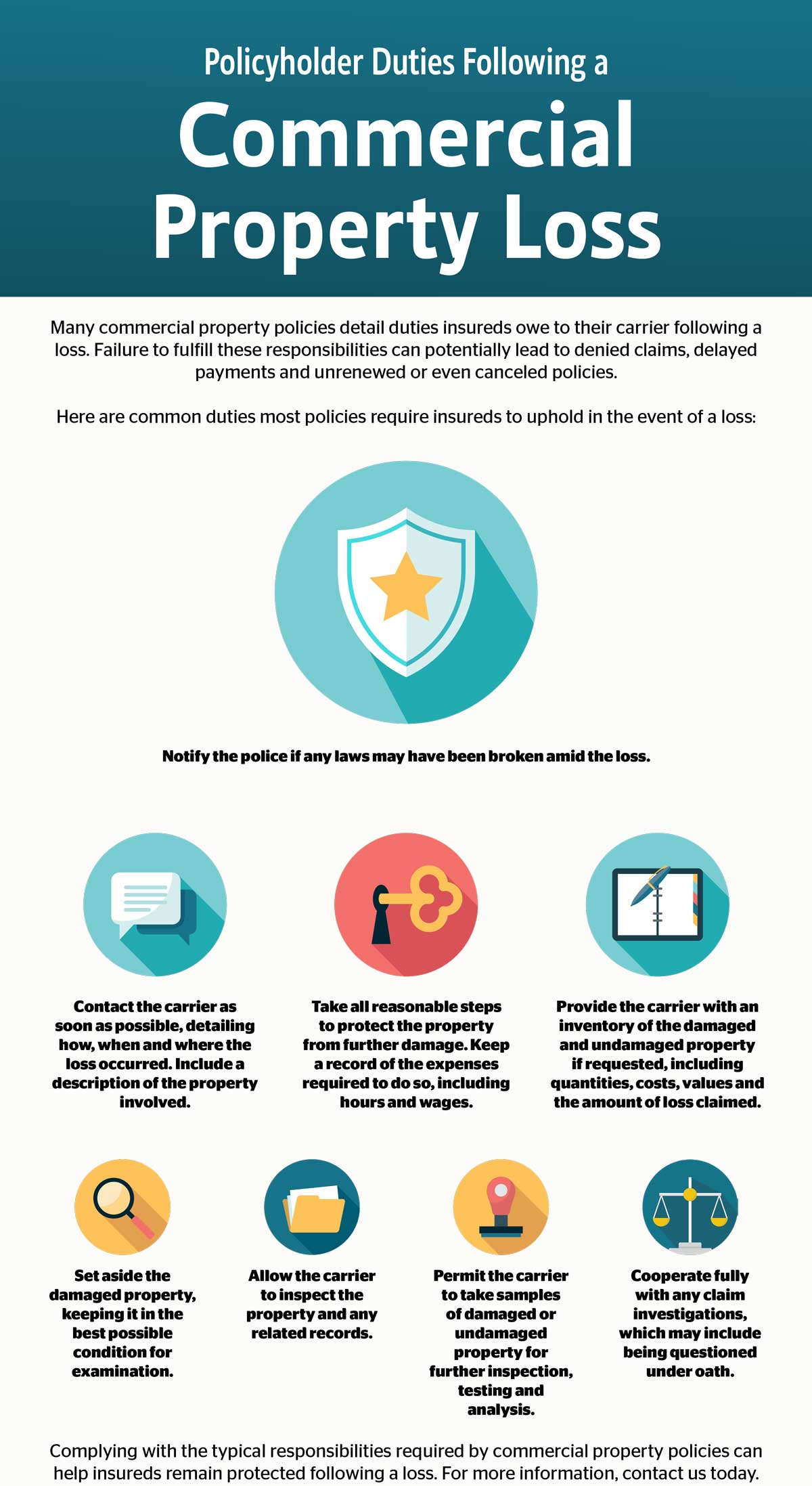
- January 3, 2023

2023 Limits to Know
With the New Year behind us, now is the time to plan for 2023. For business owners, this means familiarizing with updated contribution limits. Open enrollment may be months away for many businesses, but as the saying goes, it’s never too early to prepare.
From 401(k) to flexible spending accounts, many benefit plan limits have seen increases compared to 2022. Learn more about the new contribution limits for 2023 and educate your employees as they review their contributions for the upcoming year.
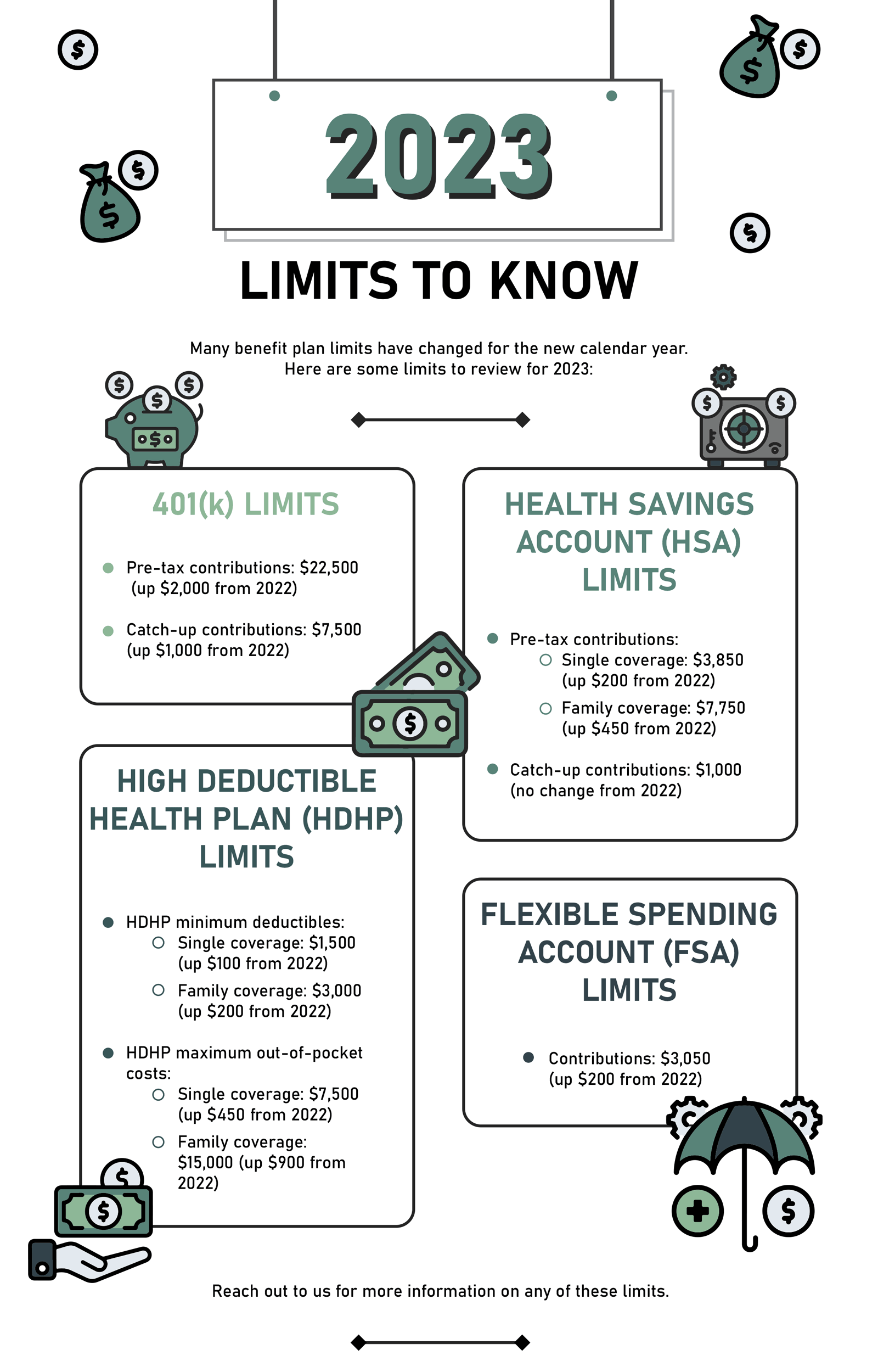
- December 5, 2022

Cyber Hygiene Best Practices
As cyberattacks become more frequent and severe, it’s increasingly important for organizations to practice good cyber hygiene—habitual practices ensuring critical data and connected devices are handled safely — to minimize their exposure to risk. Some consequences of poor cyber hygiene include:


Passwords — Users should create strong and complex passwords, and avoid sharing passwords or using the same password across different accounts.

Security software — A high quality antivirus software can perform automatic device scans to detect and remove malicious software and provide protection from various online threats and security breaches.

Data backups — Essential files should be backed up in a separate location, such as on an external hard drive or in the cloud.

Firewalls—Organizations should have a network firewall to prevent unauthorized users from accessing company websites, email servers and other sources of information.

Multi-factor authentication — Important accounts should require multi-factor authentication to limit the opportunity for cybercriminals to steal data.

Employee education — Workforce cybersecurity education is essential to teach employees to identify phishing attacks, social engineering and other cyberthreats.
Daily routines, good behaviors and occasional checkups can make all the difference in ensuring an organization’s cyber health is in optimal condition. For additional risk management guidance, contact us today.
- November 1, 2022

Combating Rising Benefits Costs During Periods of High Inflation
The U.S. inflation rate has increased by 8.3% over the last year, according to the Bureau of Labor Statistics (BLS). This has led to significant price increases across various consumer goods as well as employee benefits such as health insurance. In fact, one-third of U.S. employees have already seen an increase in their health costs in the last year, a survey conducted by the Employee Benefit Research Institute reported.
This increase in costs presents challenges for employers facing one of the most difficult hiring markets in recent memory. Luckily, there are some strategies employers can utilize to mitigate increasing benefits costs without shifting the burden to employees, thus remaining attractive to current and prospective employees.
Eliminate Underutilized Benefits
One simple strategy is to eliminate underutilized benefits. Resources from unused benefits can then go towards more expensive benefits. An easy way to evaluate which benefits best suit a company’s needs is to regularly send out benefits surveys to the company’s employees. These surveys can help employers know which available benefits may not be providing value to the company.
Wellness Programs
While there are skeptics and believers when it comes to actual cost savings provided by wellness programs, they often play an important role in other positive workplace developments. For instance, promoting and achieving a healthy workforce often improves morale and productivity. These programs are also valuable because they can lead to improved employee attraction and retention as well as increased loyalty to the employer.
There are a variety of wellness benefits employers can offer to suit the needs of their company. Potential options include providing in-office perks for nutrition, fitness and stress management, or gym memberships.
Telemedicine
Taking time off to go to the doctor can often be a time-consuming and expensive undertaking. Telemedicine may help lessen these issues by eliminating associated costs, such as transportation, and providing faster and more affordable care to those seeking medical services. By meeting with health care providers over the internet, employees can get the care they need more quickly and are likely to be more productive as a result. Additionally, telemedicine allows employees to take less paid time off of work and makes it much easier for them to avoid obstacles that could get in the way of seeking health care, such as child care.
Conclusion
As employers adjust to increasing inflation rates and the rising costs that follow, there are several strategies they can use to help offset the severity of these increases. From providing wellness programs to facilitating the use of telemedicine,
- October 27, 2022
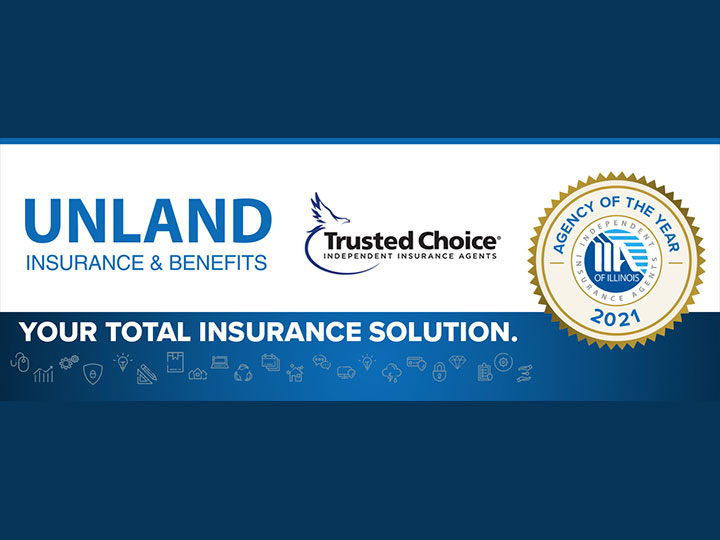
Winter Insurance Agency, A Division of The Unland Companies, Celebrates 25 Years with Auto-Owners
By Unland in Press Releases onAuto-Owners Insurance Company and WINTER INSURANCE AGENCY recently celebrated the 25th anniversary of their partnership. The agency has represented Auto-Owners in East Peoria for a wide range of personal and commercial insurance products as well as life, annuity, and disability income, since 1997.
Auto-Owners Insurance is a Fortune 500 company and is the 14th largest property & casualty insurance company in the nation, based on written premium. Auto-Owners Insurance is one of nine insurance carrier groups in the U.S. to receive the highest rating possible, A++ Superior, by A.M. Best, which is a nationally recognized rating agency for insurance companies.
Auto-Owners is represented by more than 44,000 licensed agents in its 26 operating states. The company provides auto, home, business and life insurance to more than 2.7 million policyholders.
WINTER INSURANCE AGENCY is located at 201 CLOCK TOWER DR, EAST PEORIA, IL 61611-2449 and may be reached at 309-699-3938
- October 3, 2022

AI & ADA Discrimination — What You Need to Know
Employers are increasingly relying on artificial intelligence (AI) and similar tools in numerous administrative functions. Applications can range from hiring candidates to determining pay and promotions. While convenient, such programs can result in ADA violations without the proper precautions.
Learn what you and your organization can do to accommodate those who are disabled by selecting software that accommodates all workers. In our latest blog, we examine new guidance from the Equal Employment Opportunity Commission (EEOC) and Department of Justice on how employers can ensure fair hiring practices and working environments for their employees.
- September 5, 2022

Reducing Costs with Self-Insured Health Plans
Employers are searching for effective mitigation strategies to combat rising healthcare costs with varying success. Shifting costs onto employees — such as offering high-deductible health plans and other cost-sharing methods — has been tried, but can be damaging to businesses amid a competitive labor market.
Self-insuring, on the other hand, could help reduce costs and improve service. While self-insuring may not be suitable for all businesses, it can certainly help control healthcare expenses by allowing employers to set cost-sharing limits, choose healthcare networks, and establish stop-loss limits to ensure they don’t overspend. Before switching to a self-insured plan, employers should first weigh the pros and cons.
- August 3, 2022

Study Finds a 7,000% Increase in Telehealth Utilization During Pandemic
According to a new report, telehealth usage grew more than 7,000% during the first year of the pandemic. FAIR Health’s annual report studies health care indicators, prices and utilization trends. With the latest data, researchers tracked changes from 2015 to 2020 and noticed significant health care shifts.
The biggest changes occurred during the first year of the pandemic. In 2020, the utilization of traditional health care services dropped, while new models (e.g., telehealth) increased dramatically. Telehealth utilization increased 41,919% from 2015 to 2020— and national growth was 7,060% from 2019 to 2020. Use of other places for health care services likely decreased due to pandemic-related restrictions on elective services and many people not seeking inperson care due to the risk of contacting COVID-19.
“This year’s edition … opens a window on the impact of the COVID-19 pandemic on the nation’s health care system. We hope that this new edition … continues to inform decisionmaking throughout the health care sector by payors, providers, government officials, policymakers, academic researchers and others.”
– FAIR Health President Robin Gelburd
In line with other industry research, mental health services were also a driving force for the increased use of telehealth in the United States. Mental health conditions made up 44% of all claims. In 2020, exposure to communicable diseases joined the most common diagnostic categories in retail clinics, urgent care centers and telehealth. That category was primarily associated with testing and/or treatment for COVID-19 after exposure.
The pandemic has undoubtedly changed health care delivery in the United States and is likely to have a long-term effect on how health care services are offered, priced and utilized.
Reach out today for more on the latest health care trends and resources.
For more information on building a solid benefits package, contact Nate Rugaard at (309) 642-6840 or nrugaard@unland.com.
- July 5, 2022

Three Steps to Preventing Falls
What steps have you taken to mitigating the risk of injury to your employees? Identifying areas of risk around your workplace can keep your workers healthy and save you thousands in worker’s compensation claims. Check out this infographic and learn how to protect your workers.
Identify Potential Fall Risks
Work environment considerations to think about:
- Scaffolding
- Height
- Ladders
- Walking-working surfaces
- Equipment (lifts)
Use the Proper Equipment for the Job
- Personal fall arrest system
- Equipment (aerial lifts, ladders and box trucks)
- Guard rails, perimeter warning systems, safety netting
Train Employees on Using the Right Equipment, Tools and Work Practices for the Job
- Inspection and use of personal fall arrest systems and equipment
- Emergency response if someone falls
- Who is in charge of worksite
- Fall hazards of worksite and how to prevent them

- July 4, 2022

Remembering Afton Booth
By Unland in Press Releases onRemembering a great leader in Afton Booth today! He had a tremendous impact on many of us and was instrumental in growing our agency into a very successful one before he passed. We are still enjoying the fruits of his labor and continue to carry out his mission of helping and serving others in this great business. He loved the game of golf and had a Bucket List experience back in 2001 at the famous Old Course of St. Andrews in Scotland. The attached pic is from the Swilcan Bridge on #18. I thought of him today as the first day of The Open at this same course is taking place and the best players in the world are walking across this same bridge.
— Pat Taphorn
- June 29, 2022

ISAHU Distinguished Service Award
By Unland in Press Releases onOur team is making big news! Unland Benefits Account Manager Tammy Riddle was awarded the Greg Smith ISAHU Distinguished Service Award by the Illinois State Association of Health Underwriters on June 16th.
The award, named in honor of the late Greg Smith (a friend and carrier representative for Unland), recognizes Tammy’s outstanding leadership and value to the association. We’re beyond proud of Tammy’s hard work and dedication, and we’re thrilled to have someone from the Central Illinois Chapter win this prestigious award.
Congratulations, Tammy! Keep up the great work!
- June 1, 2022

Strategies for Enduring Periods of High Inflation
Inflation has reached its highest point in several decades — how are you and your organization coping? Check out this infographic for tips and strategies on how to cope during periods of high inflation and how to maximize the value of your dollar.
As inflation has reached its highest rate in several decades, costs have soared across the country. In turn, you’ve likely noticed that prices have risen for necessities such as gasoline and groceries.
While it’s uncertain how long heightened levels of inflation will last, it’s best to focus on what you can control.
Consider these tips to help endure high periods of inflation:
Create a Budget
Knowing where your money is going can help ensure that you’re aware of where your dollars are spent and allow you to make spending decisions accordingly. A budget can help you to focus on priorities, such as housing, food and utilities—and to avoid over-spending on non-essential expenses.
Cut Back On Spending
Monitoring your spending habits can help ensure that your purchases are justified and worth your hard-earned money. This could mean cutting down on expenses such as dining, coffee or entertainment. Or, it could
mean focusing on spending money where you get the most value. For example, you may find that some of your subscriptions or memberships are rarely used, and pausing or canceling these recurring charges could help you cut costs.Take Advantage of Rewards Programs
Many goods and services you already pay for offer loyalty or membership rewards programs. These programs offer discounts, reward you with free items or give you credit in exchange for your repeated business. Take a look at common places where you spend, such as grocery stores or gas stations, to see if they offer reward programs; otherwise, you may be able to find alternative businesses that do.
Shop for Sales
It may take some extra effort, but shopping for sales can be a crafty way to reduce your expenses. This could mean looking for new stores to build into your shopping routine, taking advantage of price matching policies, or finding online or print coupons to save money on everyday purchases, such as groceries.
Invest Appropriately
Inflation is a key reason why many choose to invest a proportion of their money instead of keeping it as cash. During times of heightened inflation, it’s important to understand that the right investments can be a great way to come out ahead when the dollar loses its value. Regardless of your situation—it’s best to discuss your financial and investment goals with a financial advisor.
Find Free Activities
It doesn’t always need to be expensive to find entertainment— or something new to do. When looking for activities, consider free or low-cost alternatives. These could include visiting museums, traveling to parks, attending community events, or even getting together with friends or family. Similarly, you may be able to find free tickets or promotions for events that typically require paid admission.
If you have additional questions or need resources for financial assistance, speak to your employer.
- May 4, 2022

Attraction and Retention Tips for Small Businesses
By Unland in Uncategorized onBusinesses of all sizes are currently facing attraction and retention challenges. Successful efforts to win over employees can require an investment of time and carry high costs. Unfortunately, small businesses often don’t have an excess of resources to invest in attraction and retention efforts in today’s worker-friendly labor market.
In what’s been labeled as the “great resignation,” an increasing number of employees are leaving jobs not only for better compensation and benefits but also to prioritize desires such as flexible work arrangements or career development opportunities. Losing an employee is particularly costly for small businesses, impacting both attraction and retention. Along with costs associated with recruiting, hiring and training a replacement, the employee that left was likely a key contributor in the smaller environment, potentially leading to a significant impact on the operations and culture of a workplace.
Amid these labor obstacles, smaller employers should focus on what’s feasible. Often, small employers have the agility to respond to the employment market with new strategies. This article highlights some attraction and retention tips for small businesses.
Select the Right Benefits
According to a study from the Kaiser Family Foundation, small firms are less likely to offer health insurance versus businesses with more employees. Health insurance is valued highly by workers who often don’t have access to this coverage, which often includes part-time employees, those in the service sector—and workers employed by small businesses. Thus, for small businesses, even simply offering packages that include health care can offer a competitive edge against those that don’t.
Health insurance is just one component to consider as part of a benefits package, and small businesses should tailor their offerings to meet the specific demands of current and prospective employees. One way to start this process is by surveying employees on what types of benefits would interest them the most and then using that data to inform benefits decisions. The best benefits to offer will vary in each small business depending on the needs of the workforce—but they can be leveraged to attract and attain the right employees.
Revamp Recruiting, Hiring and Onboarding Practices
Small businesses often have limited resources when it comes to recruiting, hiring and onboarding, so it’s important to be as efficient as possible. These restraints may include insufficient financial resources to put into these practices—but also a lack of time. Often, it’s an owner, manager or lone HR professional who also takes on recruiting duties. However, a thorough review of the current status of these practices may uncover ways to create improvements.
Leveraging technology is one way to improve these practices. The good news for smaller employers is that many tools available today are relatively feasible to set up—even for a team of one— and often cost-effective.
Employers can consider using tools such as an applicant tracking system that collects and stores candidate resumes and helps automate common recruiting and onboarding tasks. To further ease the onboarding process, employers could consider leveraging cloud-based and digital tools designed to help manage the process for completing Form I-9 or direct deposit, which can be tedious for both the new hire and the employer.
By improving these processes, employers can reduce costs, and recruiting efforts can focus on finding new employees rather than dealing with tedious tasks. Every employer will be at a different place in terms of their existing processes and their current operational challenges, but a best practice to get started is to focus on what the current pain points are and how they can be improved.
Expand Recruiting Reaches
If an employer isn’t receiving the number of quality job candidates they desire, it’s worth strategizing to grow this pool. A good starting point for small businesses looking to grow their recruiting reach is to expand their online presence. This may include creating and maintaining multiple online profiles, posting content regularly and educating prospective workers about job opportunities. If limited by time, it’s OK to focus on managing one or two key profiles. It’s best to pick a platform where potential employees may likely be and focus on developing an active presence—even if it just means putting in a few minutes per day.
Employers can also focus on managing how potential candidates view their employer brand—or reputation as an employer. While small businesses may not have as developed an employer brand as their larger competitors, they may have more agility to establish—or revamp—their branding. An example of this could be to focus on highlighting the core values and impact of their organization. Surveys find that a majority of employees are more likely to work for an organization with values that align with their own.
These illustrate a few ways small employers today are expanding their reach into the employment market. Ideally, the right strategies can lead to more passive recruiting leads and improved efforts to attract employees.
Focus on Developing Employees
Attraction and retention challenges aren’t always about bringing enough employees through the doors—today, many small businesses face skills gaps. In fact, a survey in 2020 from GetApp found that one in five small businesses cited a lack of employee skills as the single biggest challenge they faced in response to COVID-19. For example, an employer’s workforce might lack the skills to use technology effectively. These gaps could also exist with soft skills, such as communication abilities or emotional intelligence. While a solution to this may be to recruit for specific skills to close these gaps, existing employees are often overlooked. While recruiting for talent with desirable skills may require significant resources, small businesses should also consider how they can bridge these gaps in-house.
Small businesses generally won’t need to develop skills for large groups, so it’s a good idea to focus on individualized learning. Some ideas or opportunities include providing career pathing plans, creating mentorship programs, offering microlearning workshops to focus on a specific skill, or paying for employees to attain certifications or further their education outside of the workplace.
Learning and development efforts can not only help employers address skills gaps; they can help employers retain existing employees and even attract new ones. Surveys find that employees are more likely to stay with an employer if they feel the organization is investing in their careers. Putting a plan to action can not only help win over employees but help prepare an employer for its future talent needs.
Offer a Flexible Work Environment
Throughout the COVID-19 pandemic, many employees have been afforded the opportunity to work remotely or have flexibility with their schedules. Surveys overwhelmingly indicate that many employees prefer to retain flexible work options. These offerings include work-from-home arrangements, hybrid work schedules (working part of the week in the office and part of it remotely) or flexible work schedules. If a business has primarily administrative employees, remote or hybrid work could continue to be an option even as COVID-19-related precautions loosen. For small businesses, offering these types of arrangements can help maintain a competitive edge over competitors that don’t offer such flexibility.
However, not all organizations allow for remote or hybrid work. If a small business is in the service industry, for example, remote work may not be an option. Yet, even working with employees to create flexible scheduling options can go a long way. The feasibility of a small business being able to offer these types of flexible arrangements will vary, but these offerings remain a priority for many workers today.
Create a Strong Workplace Culture
While topics such as compensation and benefits matter for attracting and retaining employees, so does the culture of a workplace. Even if they have limited resources, small employers should focus on fostering a desirable workplace. A healthy company culture can help retain employees—and, in turn, create an environment that is attractive to prospective job seekers. In fact, company culture is important enough that it often drives employment decisions.
As such, many small businesses are focusing on creating a strong workplace culture. Leaders are pursuing initiatives such as training managers on how to identify employee burnout, designate fair workloads and support the needs of their individual team members. In addition, many small businesses are developing programs to help create an inclusive work environment.
These types of efforts can help foster a healthy workplace culture. Each small business will be at a different place concerning the current and desired state of their work environment—and leaders can consider what types of efforts can help bridge this gap.
Employer Takeaway
Like most organizations, small businesses face a set of challenges with attracting and retaining the employees they need. Fortunately, smaller businesses have the ability to stay agile and should consider what strategies they can leverage to compete in today’s labor market.
Contact us today to learn more about attraction and retention or for additional resources on any of the topics discussed in this article.
Businesses of all sizes are currently facing attraction and retention challenges. Successful efforts to win over employees can require an investment of time and carry high costs. Unfortunately, small businesses often don’t have an excess of resources to invest in attraction and retention efforts in today’s worker-friendly labor market.
In what’s been labeled as the “great resignation,” an increasing number of employees are leaving jobs not only for better compensation and benefits but also to prioritize desires such as flexible work arrangements or career development opportunities. Losing an employee is particularly costly for small businesses, impacting both attraction and retention. Along with costs associated with recruiting, hiring and training a replacement, the employee that left was likely a key contributor in the smaller environment, potentially leading to a significant impact on the operations and culture of a workplace.
Amid these labor obstacles, smaller employers should focus on what’s feasible. Often, small employers have the agility to respond to the employment market with new strategies. This article highlights some attraction and retention tips for small businesses.
Select the Right Benefits
According to a study from the Kaiser Family Foundation, small firms are less likely to offer health insurance versus businesses with more employees. Health insurance is valued highly by workers who often don’t have access to this coverage, which often includes part-time employees, those in the service sector—and workers employed by small businesses. Thus, for small businesses, even simply offering packages that include health care can offer a competitive edge against those that don’t.
Health insurance is just one component to consider as part of a benefits package, and small businesses should tailor their offerings to meet the specific demands of current and prospective employees. One way to start this process is by surveying employees on what types of benefits would interest them the most and then using that data to inform benefits decisions. The best benefits to offer will vary in each small business depending on the needs of the workforce—but they can be leveraged to attract and attain the right employees.
Revamp Recruiting, Hiring and Onboarding Practices
Small businesses often have limited resources when it comes to recruiting, hiring and onboarding, so it’s important to be as efficient as possible. These restraints may include insufficient financial resources to put into these practices—but also a lack of time. Often, it’s an owner, manager or lone HR professional who also takes on recruiting duties. However, a thorough review of the current status of these practices may uncover ways to create improvements.
Leveraging technology is one way to improve these practices. The good news for smaller employers is that many tools available today are relatively feasible to set up—even for a team of one— and often cost-effective.
Employers can consider using tools such as an applicant tracking system that collects and stores candidate resumes and helps automate common recruiting and onboarding tasks. To further ease the onboarding process, employers could consider leveraging cloud-based and digital tools designed to help manage the process for completing Form I-9 or direct deposit, which can be tedious for both the new hire and the employer.
By improving these processes, employers can reduce costs, and recruiting efforts can focus on finding new employees rather than dealing with tedious tasks. Every employer will be at a different place in terms of their existing processes and their current operational challenges, but a best practice to get started is to focus on what the current pain points are and how they can be improved.
Expand Recruiting Reaches
If an employer isn’t receiving the number of quality job candidates they desire, it’s worth strategizing to grow this pool. A good starting point for small businesses looking to grow their recruiting reach is to expand their online presence. This may include creating and maintaining multiple online profiles, posting content regularly and educating prospective workers about job opportunities. If limited by time, it’s OK to focus on managing one or two key profiles. It’s best to pick a platform where potential employees may likely be and focus on developing an active presence—even if it just means putting in a few minutes per day.
Employers can also focus on managing how potential candidates view their employer brand—or reputation as an employer. While small businesses may not have as developed an employer brand as their larger competitors, they may have more agility to establish—or revamp—their branding. An example of this could be to focus on highlighting the core values and impact of their organization. Surveys find that a majority of employees are more likely to work for an organization with values that align with their own.
These illustrate a few ways small employers today are expanding their reach into the employment market. Ideally, the right strategies can lead to more passive recruiting leads and improved efforts to attract employees.
Focus on Developing Employees
Attraction and retention challenges aren’t always about bringing enough employees through the doors—today, many small businesses face skills gaps. In fact, a survey in 2020 from GetApp found that one in five small businesses cited a lack of employee skills as the single biggest challenge they faced in response to COVID-19. For example, an employer’s workforce might lack the skills to use technology effectively. These gaps could also exist with soft skills, such as communication abilities or emotional intelligence. While a solution to this may be to recruit for specific skills to close these gaps, existing employees are often overlooked. While recruiting for talent with desirable skills may require significant resources, small businesses should also consider how they can bridge these gaps in-house.
Small businesses generally won’t need to develop skills for large groups, so it’s a good idea to focus on individualized learning. Some ideas or opportunities include providing career pathing plans, creating mentorship programs, offering microlearning workshops to focus on a specific skill, or paying for employees to attain certifications or further their education outside of the workplace.
Learning and development efforts can not only help employers address skills gaps; they can help employers retain existing employees and even attract new ones. Surveys find that employees are more likely to stay with an employer if they feel the organization is investing in their careers. Putting a plan to action can not only help win over employees but help prepare an employer for its future talent needs.
Offer a Flexible Work Environment
Throughout the COVID-19 pandemic, many employees have been afforded the opportunity to work remotely or have flexibility with their schedules. Surveys overwhelmingly indicate that many employees prefer to retain flexible work options. These offerings include work-from-home arrangements, hybrid work schedules (working part of the week in the office and part of it remotely) or flexible work schedules. If a business has primarily administrative employees, remote or hybrid work could continue to be an option even as COVID-19-related precautions loosen. For small businesses, offering these types of arrangements can help maintain a competitive edge over competitors that don’t offer such flexibility.
However, not all organizations allow for remote or hybrid work. If a small business is in the service industry, for example, remote work may not be an option. Yet, even working with employees to create flexible scheduling options can go a long way. The feasibility of a small business being able to offer these types of flexible arrangements will vary, but these offerings remain a priority for many workers today.
Create a Strong Workplace Culture
While topics such as compensation and benefits matter for attracting and retaining employees, so does the culture of a workplace. Even if they have limited resources, small employers should focus on fostering a desirable workplace. A healthy company culture can help retain employees—and, in turn, create an environment that is attractive to prospective job seekers. In fact, company culture is important enough that it often drives employment decisions.
As such, many small businesses are focusing on creating a strong workplace culture. Leaders are pursuing initiatives such as training managers on how to identify employee burnout, designate fair workloads and support the needs of their individual team members. In addition, many small businesses are developing programs to help create an inclusive work environment.
These types of efforts can help foster a healthy workplace culture. Each small business will be at a different place concerning the current and desired state of their work environment—and leaders can consider what types of efforts can help bridge this gap.
Employer Takeaway
Like most organizations, small businesses face a set of challenges with attracting and retaining the employees they need. Fortunately, smaller businesses have the ability to stay agile and should consider what strategies they can leverage to compete in today’s labor market.
Contact us today to learn more about attraction and retention or for additional resources on any of the topics discussed in this article.
- April 10, 2022

The Best Benefits Offerings to Avoid the Great Resignation
Employees are walking away from their employers in record numbers. A Prudential survey conducted toward the end of 2021 found that 46% of workers were actively seeking or considering finding a new job, and labor statistics backed those findings. According to the U.S. Labor Department, approximately 4.5 million workers quit their jobs in November 2021, setting a new record.
This might appear like welcome news for employers looking to hire—greater unemployment means more potential job candidates. However, confoundingly, there were still around 1.5 available jobs for each unemployed person near the end of 2021, according to USA Today. And, for the last six months of the year, job openings posted by employers topped 10 million, according to the U.S. Labor Department.
This information helps illustrate the key problem employers face right now: Workers are willing to quit jobs—and turn down open positions—that don’t satisfy their needs. During this period of mass resignation (sometimes referred to as “the great resignation”), employers need to demonstrate their value to employees or risk losing them. In other words, employers must show that they can provide workers with more than just a paycheck. One of the best ways to do this is by expanding employee benefits offerings.
This article outlines some of the most attractive perks some employers are using to strengthen their attraction and retention efforts.
Affordable Benefits, Generally
Many workers who quit their jobs at the end of 2021 were front-line, low-wage or low-level employees, according to a Mercer survey. Few of these workers—often from the service sector—had access to meaningful employee benefits, if any at all. After enduring the worst of the COVID-19 pandemic, these employees concluded that their labor wasn’t worth their compensation.
Savvy employers have picked up on this and are now beginning to offer more attractive offerings to low-level employees. Beyond increased compensation, some employers are starting to offer affordable health plans and financial wellness resources. Since these workers have historically been unable to access such offerings, even modest benefits can make a huge difference when courting these employees.
Retirement Plans
Retirement uncertainty remains a top concern for employees. Only 62% of workers feel secure about their ability to save enough to retire, according to the Employee Benefits Research Institute.
Providing employees with retirement plan options, such as a 401(k), can be a great way to add value and financial security to a position. Some employers have been going further with their offerings and have started increasing their retirement plan matching. Such efforts help prove an employer’s investment in employees and their futures, which, in turn, fosters greater workplace loyalty.
Flexible Work
Workplace flexibility is another critical issue for employees. A Gallup survey found that 91% of workers who worked from home at least some of the time during the pandemic want to retain that perk indefinitely. Separately, according to a Randstad survey, nearly a quarter of employees (24%) said flexible working hours are the most important employee benefit. These figures indicate that if employers want to stay competitive, they will need to allow for some workplace flexibility—whether through flexible work hours, work-from-home arrangements or hybrid work scheduling.
Moreover, by 2025, almost a quarter (22%) of the U.S. workforce is expected to be fully remote, according to an Upwork study. That’s why some employers are expanding their flexible work policies now as a way to recruit talent. According to a Robert Half survey of senior managers, 41% said they were now allowing employees to choose where they work. Employers can expect to see similar policies crop up in the near future as workplaces compete for employees in this evolving market space.
Personalized Well-being Resources
Personal well-being has never been more important to employees than during the COVID-19 pandemic. This makes sense given that the pandemic exposed and worsened issues, including financial insecurity and mental health problems.
Some employers are expanding their voluntary benefits to help workers deal with these types of issues. After all, helping employees navigate personal problems at home can lead to better focus and productivity in the workplace. That’s why employers are tacking on benefits such as mental health counseling, financial planning assistance and student loan repayment plans.
Conclusion
Choosing the right employee benefits for a workplace can be a tricky decision. Employers must weigh employee desires against benefits budgets and operational objectives. Yet, despite potential challenges, providing meaningful benefits is certainly worth the effort. In this unprecedented labor market, an employer’s benefits offerings can be the difference between a satisfied workforce and a great resignation.
Reach out to The Unland Companies to discuss benefits options that are right for your unique workforce.
- March 16, 2022

Adjusting to a Changing Cyber Insurance Model
Are you prepared for these big changes?
We’re all familiar with the havoc cyberattacks have wrought on businesses around the world in the last several years. According to the Ponemon Institute State of Cybersecurity Report, 66 percent of small- and medium-size businesses have reported a cyberattack in the past 12 months, while 69% say these attacks are becoming more targeted. This in turn leads to massive financial losses — in fact, in 2020 Cybersecurity Ventures estimated cybercrime would continue to grow by 15% annually until 2025, accounting for $10.5 trillion.
This, in turn, has affected the insurance industry. According to Insurance Business magazine, carriers are now adjusting cyber liability policies to account for massive losses that have been incurred from these attacks. The loss ratio associated with cyber policies has grown from 43% in 2016 to 73% in 2020, leading many carriers to either exit the market or require more strict prevention protocols and increase premiums.
“Cyber insurance was only ever meant to be for a novel, an unforeseen catastrophic event,” Jess Burn, an analyst at the advisory firm Forrester, said in an interview with SC Magazine. “When things like ransomware were limited to someone’s grandmother on their old PC, that was a license to print money. But now that music has absolutely stopped and they’re reeling from those losses.”
What can my business do?
No organization is completely safe from cyber criminals. When the worst comes to pass, having some sort of safety net in place can make a huge difference in the long run. Though incidences of cybercrime have put a strain on both businesses and insurance carriers, the Unland team can help you find Cyber Liability coverage solutions that align with your potential risks and budget.
For more risk management guidance and Cyber Liability insurance solutions, contact the Unland team today.
- February 18, 2022

Multi-factor Authentication
The Importance of Multi-factor Authentication
As cyber attacks become more and more common, protecting your data is increasingly difficult. In fact, a study from Juniper Research found that by 2023, cyber criminals are expected to steal an estimated 33 billion records. In light of the growing number of cyber attacks, many companies are turning to multi-factor authentication (also commonly called MFA or multifactor authentication) to enhance their cyber security.
While no cyber security method is foolproof, using multi-factor authentication can add an extra layer of security to your online accounts. So how exactly does multi-factor authentication work?
What Is Multi-factor Authentication?
While complex passwords can help deter cyber criminals, they can still be cracked. To further prevent cyber criminals from gaining access to employee accounts, multi-factor authentication is key. Multi-factor authentication adds a layer of security that allows companies to protect against compromised credentials. Through this method, users must confirm their identity by providing extra information (e.g., a phone number or unique security code) when attempting to access corporate applications, networks and servers.
With multi-factor authentication, it’s not enough to just have your username and password. In order to log in to an online account, you’ll need another “factor” to verify your identity. This additional login hurdle means that would-be cyber criminals won’t easily unlock an account, even if they have the password in hand. A more secure way to complete multi-factor authentication is to use a time-based one-time password (TOTP). A TOTP is a temporary passcode that is generated by an algorithm (meaning it’ll expire if you don’t use it after a certain period of time). With this method, users download an authenticator app, such as those available through Google or Microsoft, onto a trusted device. Those apps will then generate a TOTP, which users will manually enter to complete login.
Why Multi-factor Authentication and Password Management Is Important
As multi-factor authentication becomes more popular, some states are considering requiring it for certain industries. It’s possible that as cyber security concerns continue to grow and cyber attacks become more common, other states will follow suit. Even if it’s not legally required, ongoing password management can help prevent unauthorized attackers from compromising your organization’s password-protected information. Effective password management protects the integrity, availability and confidentiality of an organization’s passwords.
Above all, you’ll want to create a password policy that specifies all of the organization’s requirements related to password management. This policy should require employees to change their password on a regular basis, avoid using the same password for multiple accounts and use special characters in their password.
This Cyber Risks & Liabilities document is not intended to be exhaustive nor should any discussion or opinions be construed as legal advice. Readers should contact legal counsel or an insurance professional for appropriate advice.
- January 21, 2022

Commit to Health with the Live Well Planner
Plan for a healthy 2022
The New Year is a perfect opportunity to commit to taking better care of yourself. With a fresh, new year comes a clean slate and a chance to better yourself physically, mentally, and emotionally.
Unfortunately, those commitments are sometimes easier said than done. After all, we’re all humans — sometimes life just gets in the way and despite our best intentions, those activities we planned on doing are pushed to the backburner. It’s an understandable part of life, but for many, the lack of progress on those commitments can be frustrating.
Enter the Live Well Planner.
This packet of articles, recipes, exercises, and calendars will not only help you plan your healthy activities for 2022 but remind you to stick with them. Create reasonable goals for yourself and stick with them.
Click here to download and print the Live Well Planner.
- December 10, 2021

Market Snapshot: Why Is It So Hard to Find Workers Right Now?
By Unland in Uncategorized onEmployers across the country are facing a pronounced issue right now: too many open positions and not enough workers.
On its face, it might seem like there are not enough workers available for jobs—hence all the openings. But, confoundingly, that’s not the case. The unemployment rate is still hovering just below 5%, translating to around 7.5 million unemployed Americans, according to the Bureau of Labor Statistics.
Additionally, several key COVID-19 initiatives ended at the end of summer—expanded unemployment benefits ceased, and children returned to in-person classes. As such, many economists expected workers to be spurred back into the workforce this fall. That’s decidedly not been the case; while some individuals are returning to work, others are quitting in record numbers.
This article explores the current labor market, offering potential reasons why individuals have been slow to return to work despite available positions and suggesting ways for employers to attract some of these workers.
Factors Impacting Labor Shortage
The current labor shortage is an interesting situation. On the one hand, there technically isn’t a shortage of labor, given the nearly 8 million currently unemployed workers. On the other hand, there are countless workplace openings that haven’t been filled. In that sense, there is certainly a labor shortage. This section hones in on potential contributing factors, many of which stem from the COVID-19 pandemic.

Fear of Contracting COVID-19
One obvious reason for the labor situation may be COVID-19-related fears. Some workers are simply afraid of contracting a serious case of COVID-19 at work. To some, remaining unemployed longer outweighs the risks of taking an in-person job. However, as more Americans get vaccinated, this may become less of a concern.
Comfortable Savings
During the pandemic, much of the country was in some sort of lockdown, with restrictions put on travel, gatherings and business operations. In effect, many activities people enjoyed were suspended for nearly a year. That meant all the money that someone might spend on eating out, going to the movies or attending concerts all went into personal savings. Plus, individuals received generous stimulus checks and had access to enhanced unemployment benefits during this time, which also contributed to savings.
Now, some workers are relying on those accrued savings to remain out of the workforce. Essentially, they are using their assets to hold out for a desirable job. Under normal circumstances, these people may have taken the first available position. But, with a savings safety net, they are able to wait longer.
Reprioritized Worker Desires
The COVID-19 pandemic caused workers to reevaluate their priorities, contributing to the labor shortage. Suddenly, workers began to rethink their priorities and the value of their labor. As the pandemic endured, a common thought was, “Is this job worth my mental and physical health?” Now, even as employees who were laid off are offered their previous positions, the answer among many has been a resounding, “No.”
Paired with accrued savings, workers are now able to be more discerning with the jobs they accept. As such, a significant number have chosen to quit their current jobs while they search for more fulfilling options.
According to several surveys, employees are looking for the following advantages when job hunting:
• Scheduling flexibility and/or telework options
• Access to employee benefits
• Greater compensation
• Job fulfillmentContinued Caregiving Duties
Finally, the COVID-19 pandemic has also affected the labor market through child care issues. While many schools have returned to in-person learning, some have not. On top of that, some day care facility rates have shot up due to staffing shortages and an influx of parents seeking child care.
For some parents, the costs of day care or the risks of in-person learning are too great. It may be more cost-effective to remain an at-home caregiver a bit longer instead of returning to the workforce right now.
Potential Employer Solutions
Cumulatively, the factors contributing to the current labor shortage amount to more leverage for workers. Some workers realize that employers are desperately trying to fill positions. In turn, those workers are leveraging their labor to obtain positions they value more—holding out for the right offer.
So, employers need to do what they can to make their open positions and workplaces ones that employees desire. Doing any less may severely impact both employee attraction and retention. That means implementing some of the aspects employees say they want, including the following:
Scheduling and Work Location Flexibility
During the height of the COVID-19 pandemic, many workplaces that were able to stay operational went remote. This meant sending most employees to work from home. Now that workplaces are reopening, many of those employees do not wish to return to in-person work.
Instead, formerly remote employees want to retain their status. This leaves employers with a couple of options: allow telework for some positions or introduce a hybrid schedule (i.e., require some in-person days, allowing telework the rest of the week).
In addition to helping cater to employee desires, telework also expands candidate pools, adding another incentive for employers. When a position can be done from anywhere, an employer doesn’t need to restrict hiring to a specific geographical region. It also enables employers to retain workers who may be interested in moving outside of a workplace’s region.
Benefits Access
Employee benefits are coveted assets in any workplace. Even narrow packages that just include health care can be supremely valuable among employees. They are valued even more by workers without access to them, such as part-time or service sector employees.
In fact, access to employee benefits, or a lack thereof, is one of the reasons some workers have held off on returning to former positions. After living through a pandemic, it’s not hard to imagine why individuals aren’t eager to seek in-person jobs that don’t offer health care.
Employers can consider how employee benefits packages might appeal to the kinds of workers they need. This could mean potentially expanding benefits options to some employees, such as part-time workers. Or, if an employer doesn’t offer any benefits, it might be worthwhile to consider adding some. Doing so could make a difference when trying to fill open positions or retain top talent.
Greater Compensation
Compensation is often brought up when asking employees what motivates them for obvious reasons. Simply put, individuals will likely respond to pay increases. If an employer has the budget for it, they can consider upping pay rates to attract workers or retain top performers.
Alternatively, employers can think about other means of compensation—basically, perks or value-adds that increase the worth of a position. Examples of such perks include:
• Generous time off
• Bonuses for meeting productivity goals
• Periodic catered lunches
• Company-sponsored team outings
• Free beverages or snacks in the workplaceUltimately, employers should look for opportunities to demonstrate that they value their workers. Increasing compensation through the above means or otherwise can go a long way to showing that appreciation.
Job Fulfillment
Another attraction and retention strategy is improving worker perceptions about job fulfillment. Essentially, employers need to help employees answer the question, “Why is this job important?”
The answer to that question will depend on the workplace and position, but there are some general ways employers can help in this regard. Namely, employers can directly address the matter in job descriptions by explaining how the position helps customers or a larger goal.
Employers can also consider launching a branding campaign to help tell an important story. This could mean updating brand messaging, promoting certain initiatives or taking action on social issues. Summarily, such efforts help illustrate the values of a workplace. And when presented with a number of similar employers, workers are likely to decide where they want to work based on which company shares their values.
Employer Takeaways
The current labor shortage is due to several overlapping factors, many stemming from the COVID-19 pandemic. However, it’s not a traditional labor shortage in that there are still many unemployed individuals. The real crux seems to be that workers are leveraging the moment to obtain better jobs.
It’s unclear how long workers will remain selective with their labor. Realistically, savings only last so long and, with ample vaccine availability, the pandemic may be under control soon. Workers may be compelled back into the workforce sooner rather than later.

Yet, this may not be the case—the labor shortage might last months longer than anticipated. Therefore, it’s in employers’ best interest to listen to the desires of unemployed workers, such as flexibility and benefits. Understanding these drivers will be critical to attraction and retention efforts.
At the end of they day, if an employer turns a deaf ear on what employees are looking for, they may be limiting the applicants they receive—both in terms of quality and quantity. In turn, this can severely impact an organization’s ability to grow and succeed.
This HR Insights is not intended to be exhaustive nor should any discussion or opinions be construed as professional advice. © 2021 Zywave, Inc. All rights reserved.

Ready to talk with our Benefit Specialists?
Contact Nate Rugaard at (309) 642-6840 or nrugaard@unland.com. Our team is standing by to help you with all of your benefit questions.
- October 25, 2021

COVID-19 Medical Bills Expected to Rise
COVID-19 medical bills are expected to increase next year. During the height of the pandemic, insurers waived the costs of certain COVID-19-related services, such as emergency room (ER) copayments, hospital stay deductibles and testing charges.
As the pandemic eases, those previously waived costs are returning. Many insurers are now treating COVID-19 much like other diseases, meaning they no longer provide special exceptions for COVID-19-related services.
This article briefly explains why this pricing change matters to you and what you can do to protect your health budget.
Where Might Expenses Increase?
You can expect to pay more next year for any COVID-19-related medical procedure, including testing and hospital visits for treatment. Testing is particularly important to note, as it was free in almost all cases during the height of the pandemic. Now, it could cost upwards of $200 for some screening procedures—depending on the circumstances and your plan details.
Plans and insurers will still cover testing when medically necessary. However, routine workplace and school testing may no longer be considered “medically necessary” and therefore might not be covered by insurance in certain cases.
Keep this in mind when considering routine COVID-19 screening measures. You should check your plan details or speak with human resources (HR) to see how much your insurance covers in such situations. For instance, it may cover testing prescribed by your doctor.
How Might Rising Costs Be Controlled?
One obvious way to avoid COVID-19 medical bills is to reduce your chances of catching the disease in the first place. This means getting vaccinated if you can, wearing a mask and observing other official health guidance.
Another way to control expenses is by reviewing your health plan details to see your cost-sharing responsibilities. For instance, it’s often much cheaper to visit an urgent care than an ER. HR can help you better understand your plan and its limitations.
Additionally, when visiting a medical facility, make sure you ask for an itemized bill. This will show you everything you were charged for. Bills sometimes contain duplicate or incorrect charges. Having an itemized bill can help you dispute these costs and reduce your bill size.
Where Can I Learn More?
HR is your best resource for understanding how to maximize your health care plan. They can help explain cost-sharing scenarios and offer tips for lowering your medical costs.
- September 30, 2021

Unique Insurance Challenges for Schools — and How Unland Can Help
School districts face many challenges that are common to most other businesses and organizations. However, some challenges present themselves exclusively to schools, requiring a more specialized approach from the district’s insurance provider.
Thankfully, the Unland Companies does just that for educational institutions, insuring those finer, more unique needs typical policies may not cover. Check out some challenges faced by school districts and how the Unland Companies can support them.
Challenge: How can the school district protect all its expensive equipment?
Schools are full of expensive equipment most businesses don’t have – that is no secret. Sure, you have computers, but you also have art materials, band instruments, and sports equipment, to name just a few items. How can a school district adequately cover all these materials should the unfortunate occur?

Simple — Inland Marine Insurance can cover any property, materials, and equipment as they are being transported by land. For example, if the school marching band is in route to a competition, Inland Marine Insurance can provide coverage in the event the band’s instruments are stolen at the event or on the way there.

Challenge: What if a student is injured by a school resource officer?
These days, school resource officers — i.e., uniformed law enforcement officials assigned to ensure the safety and wellbeing of students — are a common sight in schools around America. However, school resource officers are human and are consequently subject to the same liabilities while keeping the peace — and if a student is injured in the line of an officer’s work, that liability could also fall on the school district.
Thankfully, Law Enforcement Liability Insurance provides protection for school districts in the event of a student injury. This policy offers coverage for bodily harm, personal injury, or property damage caused by the wrongful act of a law enforcement official or any other public entity in the line of duty. For example, if a school resource officer wrongfully detains a student and injures the student in the process, Law Enforcement Liability Insurance would provide coverage for the school district in the event of a liability claim.
Challenge: How can the district ensure the safety of students studying abroad?
Studying in another country can be an exciting and formative experience for any student. Unfortunately, being alone in an unfamiliar country can come with its own inherent risks. If a student is studying abroad through a school-sanctioned program, the district must ensure the safety of its students no matter what corner of the globe they’re studying in.

With Kidnap & Ransom Insurance, it can do just that. Kidnap & Ransom Insurance protects against threats and extortions against people, property, and proprietary information. This coverage is exactly what it sounds like — if a student is kidnapped or held for ransom, the insurance company will reimburse the policyholder for the ransom as well as any expenses incurred in the aftermath.

Challenge: How can the school attract the best teachers and support staff?
Of course, a school’s obstacles aren’t just limited to insurance — they must also find ways to attract and retain talented educators. This means providing a competitive benefits package designed to keep your teaching and support staff healthy and safe throughout the school year — and well after.
By partnering with GIS Benefits, Unland can build a robust benefits package that includes Health, Dental, and Vision plans as well as electives such as Life and Cyber Liability Insurance. Unland can also incorporate a wellness plan that includes Worker’s Compensation and Disability Insurance. When you partner with Unland, you get more than just basic benefits — you get your very own benefits tutor!
Let Unland meet your challenges head on.
The hurdles faced by school districts are unparalleled, but not impossible to cover. Contact the Unland Companies today and find out how we can help protect your school district and your students.For more information, contact Nate Rugaard, nrugaard@unland.com, or call (309) 642-8504.
- July 20, 2021

Steps to Implement a Financial Wellness Program
Reported by Peg Knox, Defined Contribution Institutional Investment Association (DCIIA)
Financial wellness programs are increasingly embracing a broader definition of the term to include the full range of employer benefits, such as health and retirement benefits, emergency savings, work/life balance programs, etc. This more holistic view has been driven in part by the COVID-19 pandemic, which has magnified issues in emergency savings, income inequality, work-life balance, and other relevant topics, and accelerated change in this area.
The Defined Contribution Institutional Investment Association (DCIIA) provided a starting framework for financial wellness discussions in our 2017 white paper, “A Financial Wellness Primer.” This paper may help to address the “why” of implementing a financial wellness program, noting, “Whether motivated by altruism and paternalism, ROI [return on investment], lower costs or a dynamic workforce environment, the employer’s goals and employee’s desires are well aligned when it comes to retirement readiness and financial wellness in the workplace.”
In previous articles, we have covered participant communications and creating inclusive financial wellness programs and touched on some of their typical elements and implementation considerations. As wellness programs evolve, they are going beyond retirement topics to include education and assistance with:
- Budgeting and personal finance;
- Student loans;
- Emergency savings; and
- Financial considerations in health insurance and health care.

When announcing a new financial wellness program or offering, consider the following:
Remind employees of what’s in it for them: To those creating a wellness program, it might seem obvious why it’s important and how it benefits employees, but those features need to be clearly spelled out—don’t assume inferences will be made. Theoretical discussions on the benefits of saving or jargon-filled updates are likely to alienate rather than engage your employees. The more customized you can make your messaging based on employee demographics, the better.
Provide engaging tools: Attention spans are short, and time is tight. Give employees actionable, useful resources such as checklists, timelines, FAQs, and tip sheets. Bundle information into annual enrollment, but also send reminders throughout the year. Consider contests, quizzes and fun live or virtual events to bring financial wellness topics and resources to life. Leverage internal resources such as marketing, social media and communications teams and employee resource groups.
Set specific goals and measure progress: Share your goals with your employees and how you came up with them. Tell them you’ll be checking in to measure progress and get feedback. If people feel that they are part of something bigger than themselves, they might be more incentivized to be engaged. Note that their individual work on financial wellness helps your organization thrive and grow stronger, as employees feel more empowered and in control of their financial life.
Offer multiple engagement points: Providing a phone number and email address for employee questions is just a starting point. What about offering texting, a chat feature on your intranet or even a benefits app? Can you create a dedicated channel on internal communications platforms such as Salesforce, Slack or similar tools that will help to meet employees where they are? As offices open back up, consider having an information table at employee happy hours or meetings — real-life interaction doesn’t need to be limited to an annual benefits fair.

As plan sponsors look to assess their programs’ impact, measurement tools might include:
- Employee surveys: Brief “spot surveys” as employees engage with financial wellness programs can create a feedback loop for continual improvement. The key is to not only create the survey mechanism, but to implement a robust follow-through process that ensures that survey feedback is regularly reviewed and acted upon.
- Digital metrics: Having staff or a consultant or service provider capable of monitoring, analyzing and reporting on web- and email-based metrics is almost table stakes in today’s digital environment, at least for larger organizations. These metrics can help you assess which communication programs and tools are getting attention and which ones are lagging. Again, a feedback loop is crucial, so the data is not reported in a silo or seen as an isolated function. Ideally, all key stakeholders should be aware of topline metrics and be empowered to take action to improve them.
- Service provider reporting: What can your wellness providers offer to you and your participants in terms of a feedback mechanism? How can needed improvements or enhancements be communicated to them and what will the process be for ongoing monitoring and action? Having numerous participants ask the same question, run into the same problem or point of confusion, or otherwise hit roadblocks in program offerings, without being addressed, will continue to negatively impact engagement and outcomes.
Recent ongoing research from DCIIA’s Retirement Research Center and Commonwealth highlights issues specific to low- and moderate-income employees in light of COVID-19. Many of them are struggling with health issues, income losses and increased debt, and have tapped into (or tapped out) their emergency savings. Some are borrowing from friends and family, racking up expensive credit card debit or selling possessions to get by. Recordkeepers and plan sponsors can help these plan participants move in the right direction by:
- Providing employee hardship funds;
- Connecting employees with guidance on repaying debt;
- Encouraging intermittent saving where their budget allows; and
- Setting up emergency savings products through their platforms so that participants can begin saving for emergencies when they are able to do so.
Be sure that you are considering the full spectrum of your employee population as you assess and implement financial wellness offerings — often the decisionmakers are far removed from many of their employees when it comes to salary, benefits, education, and day-to-day work experience. An effective and inclusive program will speak to — and benefit — everyone.
Peg Knox is the chief operating officer (COO) of the Defined Contribution Institutional Investment Association (DCIIA) and is a former plan sponsor. Additional resources on this topic are available in DCIIA’s Resource Library.
For more information on building a solid employer benefits package that includes financial wellness options, contact Nate Rugaard, nrugaard@unland.com., or Chad Arseneau, carseneau@unland.com, or call (309) 347-2177.
This feature is to provide general information only, does not constitute legal or tax advice and cannot be used or substituted for legal or tax advice. Any opinions of the author do not necessarily reflect the stance of Institutional Shareholder Services Inc. (ISS) or its affiliates.
- July 12, 2021

Cyberattacks – Penetration Testing Explained
Keeping workplace technology up and running is vital to any organization’s success. While this task seems feasible, it’s growing harder and harder each year as cybercriminals expand their reach. It’s not enough to simply protect workplace technology with software and security protocols. It’s also critical for your organization to test the overall effectiveness of these protocols on a regular basis. That’s where penetration testing can help.
Essentially, penetration testing consists of an IT professional mimicking the actions of a malicious cybercriminal to determine whether an organization’s workplace technology possesses any vulnerabilities and can withstand their attack efforts. Conducting a penetration test can help your organization review the effectiveness of workplace cybersecurity measures, identify the most likely avenues for a cyberattack and better understand potential weaknesses.
Review this guidance to learn more about what penetration testing is, the benefits of such testing and best practices for carrying out a successful test within your organization.
What Is Penetration Testing?
Put simply, penetration testing refers to the simulation of an actual cyberattack to analyze an organization’s cybersecurity strengths and weaknesses. This testing usually targets a specific type of workplace technology, such as the organization’s network(s), website, applications, software, security systems or physical assets (e.g., computers and smart devices). Penetration testing can leverage various attack methods, including malware, social engineering, password cracking and network hacking, among others.
Generally speaking, penetration testing is often performed by a professional from a contracted IT firm who is not associated with the organization being assessed in any way. This helps the cyberattack simulation seem as authentic as possible. Penetration testing is typically either external or internal in nature. The primary differences between these forms of testing are as follows:
- External penetration testing requires the IT expert to attack an organization’s external-facing workplace technology from an outside perspective. In most cases, the IT professional won’t even be permitted to enter the organization’s physical establishment during external penetration testing. Rather, they must execute the cyberattack remotely—often from a vehicle or building nearby—to imitate the methods of an actual cybercriminal.
- Internal penetration testing allows the IT expert to attack an organization’s internal-facing workplace technology from an inside perspective. This form of testing can help the organization understand the amount of damage that an aggrieved employee could potentially inflict through a cyberattack.
In addition to these testing formats, there are also two distinct types of penetration tests. How much information an organization provides the IT professional prior to the cyberattack simulation will determine the penetration test type. Specifically:
- An open-box test occurs when the IT expert is given some details regarding the organization’s workplace technology or cybersecurity protocols before launching the attack.
- A closed-box test occurs when the IT expert is provided with no details other than the organization’s name before conducting the attack.
Ultimately, the penetration testing format and type should be selected based on the particular workplace technology elements or cybersecurity measures that an organization is looking to evaluate.

Benefits of Penetration Testing
Penetration testing can offer numerous advantages to your organization, including:
- Improved cybersecurity evaluations—By simulating realistic cyberattack situations, penetration testing can help your organization more accurately evaluate its varying security strengths and weaknesses—as well as reveal the true costs and of any security concerns.
- Greater detection of potential vulnerabilities—If any of your workplace technology or other cybersecurity protocols fail during a penetration test, you will have a clearer picture of where your organization is most vulnerable. You can then use this information to rectify any security gaps or invest further in certain cyber initiatives.
- Increased compliance capabilities—In some sectors, organizations are legally required to engage in penetration testing. For example, the Payment Card Industry Data Security Standard calls for organizations that accept or process payment transactions to execute routine penetration tests. As such, conducting these tests may help your organization remain compliant and uphold sector-specific expectations.
- Bolstered cybersecurity awareness—Mimicking real-life cyberattack circumstances will highlight the value of having effective prevention measures in place for your employees, thus encouraging them to prioritize workplace cybersecurity protocols.
Penetration Testing Best Practices
Consider these top tips for executing a successful penetration test within your organization:
- Establish goals. It’s crucial for you to decide what your organization’s goals are regarding the penetration test. In particular, be sure to ask:
- What is my organization looking to gain or better understand from penetration testing?
- Which cybersecurity threats and trends are currently most prevalent within my organization or industry? How can these threats and trends be applied to the penetration test?
- What specific workplace technology elements or cybersecurity protocols will the penetration test target?
- Select a trusted IT professional. Consult an experienced IT expert to assist your organization with the penetration test. Make sure to share your organization’s goals with the IT professional to help them understand how to best execute the test.
- Have a plan. Before beginning the penetration test, work with the IT expert to create an appropriate plan. This plan should outline:
- The general testing timeframe
- Who will be made aware of the test
- The test type and format
- Which regulatory requirements (if any) must be satisfied through the test
- The boundaries of the test (e.g., which cyberattack simulations can be utilized and what workplace technology can be targeted)
- Document and review the results. Take detailed notes as the penetration test occurs and review test results with the IT expert. Look closely at which cybersecurity tactics were successful during the attack simulation and which measures fell short, as well as the consequences of these shortcomings. Ask the IT professional for suggestions on how to rectify security gaps properly.
- Make changes as needed. Based on penetration test results, make any necessary adjustments to workplace technology or cybersecurity protocols. This may entail updating security software or revising workplace policies.
- Follow a schedule. Conduct penetration testing at least once every year, as well as after implementing any new workplace technology.
For more risk management guidance and Cyber Liability insurance solutions, contact the Unland team today.
- June 9, 2021

Attraction and Retention Challenges Amid COVID-19
Attracting and retaining talent is often a top priority for HR departments. Given the effect the COVID-19 pandemic has had on the job market, one might imagine this task is easier than ever. Unfortunately, that’s far from the truth.
While there may be more candidates than usual, attracting quality talent and retaining top performers still remains a struggle, worsened by COVID-19 and its effects on the workplace.
This article shares some tips for attracting and retaining workers amid the COVID-19 pandemic.
Expand Hiring Pools
The COVID-19 pandemic has demonstrated how quickly teams can adapt, with some workplaces shifting entirely to telework. After months of remote-working success, many workplaces have said they will allow telework permanently even after the pandemic subsides. That’s because of the numerous advantages of remote work.
For one, these individuals won’t take up office space, saving room for others who need it. Additionally, this flexibility allows recruiters to expand hiring pools to anywhere with an internet connection. This can be a great benefit for employers that haven’t had luck finding quality talent near them.
Adapt the Workplace Layout
Amid the COVID-19 pandemic, many workers are concerned about their health and well-being while at work. By addressing these concerns, employers can bring peace of mind to employees and, in turn, attract workers who may have held reservations about their safety.
Employers can do this by adapting their workplaces to focus on worker health. This includes mandating social distancing, moving desks around, holding virtual meetings exclusively, allowing flex scheduling and offering telecommuting. At the end of the day, workplaces that demonstrate concern for employees will be the ones where individuals actually want to work. Conversely, if employees are forced to choose between their safety and their jobs, employers shouldn’t expect good retention.
Provide Meaningful Benefits
The pandemic has affected everyone in significant, yet unique, ways. While all employees may be struggling in some way, their situations aren’t the same. Employers can help lift up their workers by offering meaningful employee benefits.
Robust health care offerings may seem like an obvious one-size-fits-all solution, but sometimes voluntary benefits are actually what employees need. These include caregiving assistance, financial counseling, increased paid time off and other nontraditional perks. There are many low-cost options available and, better yet, employees can choose their benefits a la carte to meet their individual needs.
Support Well-being
Employees are going through a lot right now, and many are suffering from poor mental health. This includes feeling depressed, lonely, anxious or any other negative emotion—feelings that may be compounded if employees are working in isolation. And the fact that employees are holding onto negative feelings isn’t terribly surprising, given the devastating impacts of COVID-19.
Now is the time for employers to show employees and potential recruits that they’re willing to invest in their well-being. Potential options include comprehensive employee assistance programs, one-on-one counseling, therapy sessions and stress-reducing activities. Solutions don’t need to break the bank, either. Something as small as a weekly outdoor activity, virtual chitchat meeting or group excursion could be enough to lift employees out of their funk.
Look Internally for Talent
If an employer is struggling to fill an important role with an outside candidate, it could be that they’re looking in the wrong place. Many organizations are now focusing on upskilling current employees and retraining them for more important positions. This can be significant for a few reasons.
Firstly, outside candidates would need to be trained anyway, so upskilling a current employee wouldn’t be any more burdensome. Since they’re already familiar with the workplace and its operations, it may even be easier.
Secondly, many recruiting teams are expecting big slashes to their budgets in the wake of the COVID-19 pandemic. As such, shuffling around current employees could help save the bottom line.
Thirdly, promoting employees from within the organization shows that an employer is willing to invest in their career growth. This sentiment can go a long way in retaining top talent.
Conclusion
There are many creative ways employers can attract and retain quality workers. Amid the COVID-19 pandemic, even small gestures can go a long way to distinguish an organization from others in its industry.
Reach out today to learn more about these and other workplace strategies.
- May 7, 2021

Employer Guide to the Current State of Consumer Driven Health Plans
Health care consumerism has always been about empowering health care consumers to select more cost-effective, appropriate care. This thesis is the backbone of consumer driven health plans (CDHPs), which aim to make employees active participants in their health care.
Specifically, CDHPs aim to achieve the following goals:
- Help employees become more involved in their health care decision-making rather than remaining passive.
- Encourage employees to spend their health care dollars wisely by seeking care from providers who are cost-efficient and provide quality care.
- Help employees take charge of their health by helping them understand their conditions and treatment options, and change their behaviors to eliminate unnecessary health risks.
This guide provides an overview of CDHPs and offers considerations for employers looking to reduce benefits expenses and boost employee health literacy.
What Are CDHPs?
Employers may be familiar with high deductible health plans (HDHPs) and health care accounts, such as health savings accounts (HSAs). A CDHP is simply the combination of those benefits—an HDHP paired with a health care account.
Since HDHPs have low premiums but high deductibles (i.e., employees must cover a significant portion of incurred health costs), health care accounts are often used to offset these expenses.
That’s the great thing about CDHPs—they offer affordable plans, paired with accounts that can be used as needed by employees. Not only does this help lower employees’ monthly premiums, but it also empowers them to be wiser health care consumers.
Health Care Accounts
Most employers offer CDHPs in conjunction with a health care account. There are three types of accounts typically available for CDHPs:
- HSAs—Opened by an employee and can be funded by both the employer and the employee, with funds rolling over each year.
- Health reimbursement arrangements (HRAs)—Owned and funded only by the employer, with limited rollover.
- Flexible spending accounts (FSAs)—Opened by an employee and can be funded by both the employer and employee, but only some funds can be rolled over each year.
All these health accounts are tax-advantaged. For example, with HRAs, employer contributions do not have to be included in the employee’s gross salary, so contributions are not taxed. For HSAs, the amount the employee contributes is tax-deductible and not included in the employee’s gross wages. With FSAs, pre-taxed income can be set aside for the year’s medical payments.
Each health care account comes with certain differences and unique advantages. For instance, some accrue tax-free interest when funds are rolled over and can move with employees even if they change workplaces. Some are entirely controlled by employers, while others are shared between employees and employers.
Choosing which health care account to offer with a CDHP will depend on a variety of factors, namely how much control employers want. Regardless, any health care account encourages improved health literacy by requiring employees to proactively consider how their health care dollars are spent. Reach out to learn more about the advantages of each type of health care account.
Contribution Levels
In an effort to encourage employee participation and engagement, some employers contribute to their employees’ health care accounts, although the amounts they contribute can vary widely. With some accounts, employers price match employee contributions. With others, employers contribute a specific amount. Deciding on a health care budget early can help employers decide which health care account is right for their bottom line.
CDHP Employee Advantages

One of the greatest advantages of a CDHP is its ability to empower employee health care decision-making. Chronic health problems are among the leading causes of death in the United States, and they create significant financial burdens for those affected. This is, in part, due to individuals putting off routine health checkups as an attempt to save money, thus allowing chronic conditions to potentially worsen. This situation can lead to seemingly healthy individuals ignoring their health completely, even forgoing an annual physical exam. In turn, conditions that may have been caught and treated early have the potential to develop into chronic issues.
CDHPs put employees in control of their health decisions, requiring them to think carefully about their health instead of allowing them to slump into a passive role. The plans offer employees an affordable lifeline to health services, with tax-advantaged ways of paying for that care when needed. CDHPs are especially attractive to younger employees who may visit the doctor infrequently. Having an affordable CDHP helps encourage good health practices among employees and helps position them for a healthier future without chronic issues.
CDHP Employer Advantages
CDHPs can be an excellent way for employers to control health care spending. In fact, CDHPs are often more effective at reducing total medical costs compared to traditional health plans. For example, short-term cost savings increased over 20% for employers during their first year of switching to a CDHP, according to a Cigna report. That’s because CDHPs share much of their costs with employees, rather than relying primarily on the employer. Even employers who contribute to employee health accounts can choose how much to do so, providing even more spending control.
Beyond monetary advantages, CDHPs also help improve employee satisfaction with their health coverage. By enabling employees to choose when and how their health dollars are spent, they can decide what’s best for their unique situations. Under a traditional plan, employees are relegated to a more passive role and do not have access to a tax-advantaged account that can be used for qualified health expenses.
Utilization and Value Trends
The numerous advantages of CDHPs are encouraging more employers to adopt them. In fact, CDHP enrollment has increased significantly in recent years, with over 30% of workers covered under these plans, according to the Kaiser Family Foundation (KFF). What’s more, this shift may account for significant savings for both employers and employees. CDHP annual costs per individual are $776 less than other traditional health plans on average, according to KFF.
Here are some other noteworthy statistics, based on a 2020 America’s Health Insurance Plans (AHIP) report:
- CDHPs had over 30 million enrollees in 2019, following a long-term upward trend since the early 2000s.
- Of those enrollees, 35% have at least one chronic condition, illustrating that CDHPs still provide access to necessary, ongoing care.
- CDHP enrollees have almost the same rate of cancer screenings and immunizations, compared to traditional health plan participants.
These statistics help demonstrate the impact CDHPs are having on the insurance marketplace. By giving employees more power over their health care, employers are reducing costs and improving health literacy.
Increasing the Success of a CDHP
The success of a CDHP is largely dependent on clear, consistent communication. Employees are often skeptical about enrolling in a CDHP for a variety of reasons, including concerns about higher out-of- pocket costs, misinformation, lack of understanding or reluctance to switch from a traditional plan that is comfortable and familiar. To minimize these concerns, employers should communicate early and often and explain that CDHPs are meant to help employees take control of their health. Also, they should be sure to focus on the lower monthly premiums associated with CDHPs, the tax benefits of health care accounts and employer monetary contributions.
To achieve buy-in, communication regarding health care consumerism should resemble a marketing campaign more than a typical HR information campaign. Employers should incorporate sufficient lead time into communication efforts to ensure maximum traction. Using a variety of communication methods, such as handouts, emails, videos, face-to-face meetings and presentations, can provide the most impact. Repeated messages in different formats can ensure sufficient employee exposure and understanding.
In addition, employees need education on how to use a CDHP, as these plans differ significantly from traditional health plans that employees may be more familiar with. For example, employers should teach employees when it’s appropriate to go to the doctor’s office, urgent care or the emergency room, so they can reduce their out-of-pocket expenses. Other beneficial topics may include highlighting the benefits of generic medications and the higher costs and restrictions associated with out-of- network care. This education should begin during open enrollment and continue throughout the year so employees can become wiser health care consumers.
Having the right information regarding CDHPs will give employers valuable assistance in designing a plan and effectively communicating it. Employers should consider surveying employees before implementing a CDHP to discover what current perceptions and knowledge are, so they can target the areas that need clarification. Additionally, resurveying employees after implementation will provide an assessment of where gaps in understanding remain, how effective the initial communication efforts were and how plan designs and communications can be modified for the future.
Summary
CDHPs offer an intriguing option for long-term improvement and cost savings—so much so that many employers across the nation either have already implemented CDHPs or are considering doing so. To learn more about setting up a CDHP, contact us today.
- April 21, 2021

Celebrating 80 Years of Service
By Unland in Press Releases onEighty years is a long time to be in business. If you ask Unland Companies President Patrick Taphorn, eight decades of community support has been a tremendous asset to the company’s success.
“We’ve been extremely blessed to be in communities that really value supporting local businesses,” Taphorn said. “We’ve been the recipient of that, and in turn, we’ve provided a very good, value-added service to our customers. To all those communities, thank you very much for your support and for trusting us to provide insurance coverage for you all these years.”
This year, Unland Companies celebrates 80 years of service to Central Illinois. Founded by J. Logan Unland in 1941, the company has grown from a single location with three employees to five locations with nearly 40 employees.
The more things change…
Of course, the insurance industry has changed a lot since 1941 when Mr. Unland himself was selling Aetna life insurance door-to-door. One of the biggest changes has been the evolution of technology in the industry. Although technology has normalized digital communication in the office, Taphorn said the Unland Team still prioritizes knowing individual customers personally and understanding their specific concerns.
“Technology has been a big change,” Taphorn said. “It’s a huge part of what we do and how we continue to be efficient and timely in service to our customers, but we still have that personal touch. Insurance is a relationship business, and we need to do everything we can to maintain and grow our relationships.”
Even though we started in the days of pen and paper, we have adopted a wide variety of tools to support our customers. Platforms such as Ease, for example, provide an interface that makes benefits enrollment easier for employees, employers, and agents.
“We invested in that platform a number of years ago and it’s really benefitted us as a company,” Taphorn said. “Business owners wear many hats and taking employees through the enrollment process for health insurance, dental, life, and other benefits programs can be a challenge many are not prepared for – they don’t want to mess with stacks of paperwork, sending it out to employees, waiting on them to send it back, and often chasing people down. That platform has really helped our customers. We’re growing rapidly in that area because of Ease.”
Although technology has made enrolling easier for both Unland and its customers, the increasing reliance on consumer tech solutions isn’t without its drawbacks.
“You would have never thought 15 or 20 years ago that you’d sell a cyber liability policy and that people would be asking for it,” Taphorn said. “That’s been a big change in the recent past.”
“Property & Casualty policies used to just include basic coverage such as fire, lightning, wind, hail, etc. The contracts now can integrate electronic data processing equipment, business interruption, mine subsidence, water backup of sewers and drains, identity theft, cyber liability, protection for mobile devices and even coverage for your pets,” Taphorn said. “Auto coverage has evolved from its initial intent of including physical damage and liability to now incorporating towing, roadside assistance, rental reimbursement, loss of use and many other options.”
The more they stay the same
One thing that’s remained the same, however, is the Unland Team’s commitment to putting its customers first. Taphorn said fostering a culture that stresses the importance of serving the customer has allowed Unland to provide the best top-notch coverage for eight decades.
“We’ve got really, really good people working here and have an expectation of how we service our customers,” Taphorn said. “People who work here know that serving our customers is a part of our culture. We’re selling a service and we can shine at a time when they need it the most.”
At the same time, Taphorn said Unland also works hard to be an employer of choice, ensuring the company hires charismatic, amiable employees.
“We try to make our offices a good place to interact. We do different activities throughout the week or month to break it up a little bit and we’ll have outings here and there,” Taphorn said. “We keep in mind while we’re trying to generate growth, efficiencies and best practices, we still have to remember that these people need to have a good time with it as well.”

J. Logan Unland

James Unland Sr.

Jeff Peterson, Bill Shock, and Afton Booth

Giving back
While the company continues to expand — Unland added its fifth location in January 2020 in Metamora — Taphorn said the Unland Team recognizes this growth couldn’t be possible without the support of the community. So, Unland stresses the importance of giving back by supporting area organizations such as EP!C, the American Cancer Society, St. Jude Children’s Research Hospital, Goodwill, Children’s Hospital of Illinois, TAPS, Union Mission, Boys & Girls Club, UnityPoint Pekin Hospital Foundation, and various chambers of commerce throughout Central Illinois.
Looking ahead, Taphorn said the future for Unland Companies is bright. Two new acquisitions in recent months have served to grow the company’s footprint in the area. In 2020, the company came off its best year ever, ending with $46 million in premiums. That recent growth, Taphorn said, is an indicator of Unland’s promising future and many more celebrations.

- March 12, 2021

Overview of the American Rescue Plan
The $1.9 trillion relief bill, known as the American Rescue Plan, has been signed into law by President Joe Biden. Highlights of the bill include extended unemployment benefits, direct checks to individuals and more.
While some of the bill was changed during its time with Congress, it’s largely similar to the initial version passed by the House. However, some key provisions, such as a higher minimum wage, were scrapped amid efforts to pass the bill swiftly.
This article outlines the most relevant provisions included in the bill.
SMALL BUSINESS ASSISTANCE
The bill invests billions toward small business assistance. Here is the current funding breakdown:
-
- Economic Injury Disaster Loan program: $15 billion
- New grant program for bars and restaurants, specifically: $28 billion
- Paycheck Protection Program: $7.25 billion
DIRECT PAYMENTS
Just like the two other COVID-19 relief bills passed during the pandemic, this version also features direct payments to Americans. This time around, eligible recipients can expect $1,400 per person ($2,800 for couples), including adult dependents—a family of four could receive up to $5,600.
However, payment parameters are stricter this time around than with the previous direct payment. The full amount will go to individuals earning under $75,000 (or $150,000 for couples), with payments cut off entirely for individuals earning over $80,000 (or $160,000 for couples). Individuals earning an amount between those figures will receive a reduced sum.
UNEMPLOYMENT AID
The bill extends two previously established pandemic unemployment assistance efforts: The Pandemic Unemployment Assistance Program and the Pandemic Emergency Unemployment Compensation program. Unemployed gig workers, freelancers, contractors, and others who previously qualified for aid will continue to be eligible under these programs. The financial assistance provided by these two programs is currently set to expire in mid-March, which pressured legislators to act quickly.
The bill also provides for enhanced unemployment assistance payments of $300 per week. Under the bill, these programs and their financial aid are extended through Sept. 6.
HOUSING ASSISTANCE
The bill sets aside billions in financial aid to homeowners and renters. Here is the funding breakdown:
- Aid for emergency rental assistance: $22 billion
- Aid for mortgages, utilities and property taxes: $10 billion
- Aid to states and localities to help individuals at risk of becoming homeless: $5 billion
EMERGENCY PAID LEAVE
The Families First Coronavirus Response Act (FFCRA), signed into law on March 18, 2020, required certain employers to provide employees with paid sick leave or expanded family and medical leave for specified reasons related to COVID-19. That requirement expired Dec. 31, 2020.
The American Rescue Plan maintains the status quo, in that it does not require employers to offer leave under the FFCRA framework. However, the bill does provide tax credits for employers that voluntarily provide leave under the FFCRA framework through the end of September 2021.
AID TO SCHOOLS AND CHILD CARE
A significant portion of the relief bill involves aid to states, including schools and childcare facilities:
- Aid for getting K-12 schools ready for in-person learning: $125 billion
- Money may be used for purchasing protective equipment, improving ventilation systems, and hiring support staff, among other things. However, 20% of the money schools receive must be used to address pandemic learning loss—for example, extending learning time into the summer.
- Aid carved out specifically for private schools: $2.75 billion
- Aid for colleges: $40 billion
- Institutions will be required to spend at least 50% of their allocated funds on emergency financial aid grants to students.
- Childcare provider assistance: $39 billion
- Funds may be used for payroll, rent, protective equipment and other expenses.
TAX CREDITS
The relief bill provides an overhaul of the child tax credit for the 2021 tax year. The bill increases the amount of the credit to $3,000 for each child under the age of 18 and $3,600 for children under the age of 6. The credit will also become fully refundable, meaning low-income individuals would receive the benefit.
The bill also expands the earned income tax credit for individuals without children. The maximum credit will be nearly tripled, and eligibility will be expanded as well.
HEALTH INSURANCE
The bill subsidizes private health insurance premiums for unemployed workers through the Consolidated Omnibus Budget Reconciliation Act (COBRA). The provision allows individuals eligible for COBRA insurance coverage to maintain their employer-sponsored coverage after losing employment without having to pay any portion of the premiums through the end of September 2021.
Additionally, the bill invests nearly $35 billion in premium subsidy increases for those who buy coverage on the ACA Marketplace. The bill increases the subsidies provided to currently eligible individuals, and removes the 400% federal poverty level cap (equal to approximately $51,000 for an individual) on subsidy eligibility.
AID TO STATES, LOCAL GOVERNMENTS, TRIBES AND TERRITORIES
The bill provides billions in financial assistance to states, local governments, tribes and territories. Here is the current funding breakdown:
- Aid to state and local governments: $325.5 billion
- Aid to tribes and territories: $24.5 billion
- Creation of the Coronavirus Capital Projects Fund, to carry out capital projects directly enabling work, education and health monitoring: $10 billion
WHAT’S NOT IN THE BILL
A minimum wage hike to $15 per hour—one of the most discussed provisions from the initial bill—has been removed from the final version due to strict rules governing budget bills in the Senate. Some Democrats have suggested this provision may be considered as a standalone bill, but any movement on that front remains to be seen.
Additionally, the bill does not include an extension of the eviction moratorium, which is set to expire on March 31, or an expansion of mandated paid sick and family and medical leave. While neither were included in the original House bill, these were popular provisions contained within one of the previous bills.
SUMMARY
While there are many complex provisions in this nearly $2 trillion relief bill, The Unland Companies is here to help employers make sense of everything. Reach out with questions about how this new bill may affect your organization.
-
- March 10, 2021
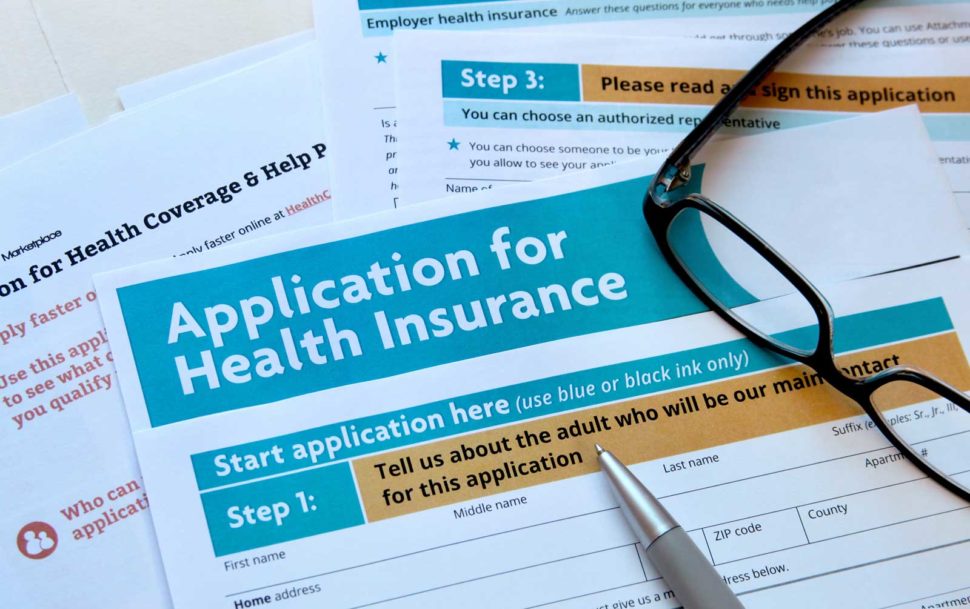
COVID-19 Relief Extends COBRA, HIPAA and Other Plan Deadlines
On April 28, 2020, the Departments of Labor (DOL) and the Treasury (Departments) issued deadline relief to help employee benefit plans, plan participants and plan service providers impacted by the COVID-19 outbreak. Thereafter, on Feb. 26, 2021, DOL Disaster Relief Notice 2021-01 clarified the duration of this relief.
The deadlines were initially extended by disregarding an Outbreak Period from March 1, 2020, until 60 days after the announced end of the National Emergency (or such other date announced by the Departments). Under federal law, this period could not exceed one year, meaning that the relief was expected to expire on Feb. 28, 2021. However, the Notice allows the relief to extend beyond this date in some situations, while emphasizing that plan administrators should continue to make reasonable accommodations to prevent the loss of or delay in payment of benefits.
This Compliance Overview summarizes the continuation of relief guidance, including illustrative examples.
Extended Participant Deadlines
The initial relief provided participants in ERISA-covered plans with additional time to comply with certain deadlines affecting COBRA continuation coverage, special enrollment periods, claims for benefits, appeals of denied claims and external review of certain claims. Specifically, the relief extended:
- HIPAA time frames: The 30-day period (or 60-day period, if applicable) to request special enrollment.
- COBRA time frames: The 60-day period for qualified beneficiaries to elect COBRA coverage; the date for making COBRA premium payments (which is generally at least 45 days after the day of the initial COBRA election, and a grace period of at least 30 days for subsequent premium payments); and the date for individuals to notify the plan of a qualifying event or disability determination (in general, at least 60 days from the date of the event, loss of coverage, or disability determination).
- Claims procedures time frames: The date within which individuals may file a benefit claim under the plan’s claims procedure, and the date within which claimants may file an appeal of an adverse benefit determination under the plan’s claims procedure.
- External review process time frames: The date within which claimants may file a request for an external review after receipt of an adverse benefit determination or final internal adverse benefit determination, and the date within which a claimant may file information to perfect a request for external review upon a finding that the request was not complete.
In addition to the participant deadline relief above, extended time frames were provided for plan officials to furnish benefit statements and other notices and disclosures required under ERISA, so that plan sponsors have additional time to meet their obligations during the COVID-19 outbreak.
Under the initial relief, an employee benefit plan will not be in violation of ERISA for a failure to timely furnish a notice, disclosure or document that must be furnished during the Outbreak Period, if they act in good faith. This means the plan must furnish the documents as soon as administratively practicable under the circumstances. Good faith acts include use of electronic means of communicating with plan participants who the plan sponsor reasonably believes have effective access to electronic means of communication, including email, text messages and continuous access websites.
The DOL acknowledged in Notice 2021-01 that many plans have already returned to normal compliance procedures for furnishing notices and disclosures, and that notices and disclosures properly furnished without relying on the initial relief do not need to be refurnished. Similarly, to the extent the plan can demonstrate that a notice or disclosure was actually received, it would not need to be refurnished even if it was initially furnished in reliance on the prior relief.
Application of the One-year Limit
Notice 2021-01 clarifies that individuals and plans subject to the initial relief can extend the applicable deadlines until the earlier of:
- One year from the date they were first eligible for relief; or
- 60 days after the announced end of the National Emergency (the end of the Outbreak Period).
On the applicable date, the time frames for individuals and plans with periods that were previously disregarded will resume. In no case will a disregarded period exceed one year.
Examples
The Notice provides the following examples to illustrate the duration of the relief:
- Example 1: If a qualified beneficiary would have been required to make a COBRA election by March 1, 2020, that requirement is delayed until Feb. 28, 2021. This date is the earlier of one year from March 1, 2020, or the end of the Outbreak Period (which remains ongoing).
- Example 2: If a qualified beneficiary would have been required to make a COBRA election by March 1, 2021, that election requirement is delayed until the earlier of one year from that date (that is, March 1, 2022) or the end of the Outbreak Period.
- Example 3: If a plan would have been required to furnish a notice or disclosure by March 1, 2020, the relief would end with respect to that notice or disclosure on Feb. 28, 2021. The responsible plan fiduciary would be required to ensure that the notice or disclosure was furnished on or before March 1, 2021.
In all of these examples, the delay for actions required or permitted that is provided by the Notices does not exceed one year.
Reasonable Accommodations
The DOL recognizes that plan participants and beneficiaries may continue to encounter problems when the relief is no longer available, due to the one-year limit. Accordingly, plan fiduciaries should make reasonable accommodations to prevent the loss of or undue delay in payment of benefits in these cases and should take steps to minimize the possibility of individuals losing benefits because of a failure to comply with pre-established time frames.
- The administrator or other fiduciary should consider affirmatively sending a notice regarding the end of the relief period when individuals are at risk of losing coverage.
- Plan disclosures issued prior to or during the pandemic may need to be reissued or amended if those disclosures failed to provide accurate information regarding the time in which participants and beneficiaries were required to take action (for example, COBRA election notices and claims procedure notices).
- In the case of ERISA group health plans, plans should consider ways to ensure that participants and beneficiaries who are losing coverage under their group health plans are made aware of other coverage options that may be available to them, including the opportunity to obtain coverage through the Exchange in their state.
The DOL also acknowledges that full and timely compliance with ERISA’s disclosure and claims processing requirements by plans and service providers may not always be possible. In the case of fiduciaries that have acted in good faith and with reasonable diligence under the circumstances, the DOL’s approach to enforcement will be marked by an emphasis on compliance assistance, and includes grace periods and other relief.
Application to Non-federal Governmental Plans
While the extension of time frames included in the guidance is not mandatory for non-federal governmental plans, plan sponsors of non-federal governmental plans are encouraged by the applicable federal agencies to provide similar relief to participants and beneficiaries. The Notice states that the Department of the Treasury, IRS, and Health and Human Services have advised the DOL that they concur with the guidance regarding the continuation of relief, citing to a prior bulletin issued by the Centers for Medicare & Medicaid Services (CMS). In the bulletin, which was issued in response to the initial relief, CMS stated its plans to adopt a temporary policy of relaxed enforcement to extend similar time frames otherwise applicable to non-federal governmental group health plans, and their participants and beneficiaries, under applicable provisions of the Public Health Service Act (PHS Act).
- February 8, 2021

Commercial Auto Trends to Watch in 2021
Whether they’re transporting materials and tools to worksites, hauling goods for deliveries or driving to meet clients—organizations of all sizes and industries rely on safe, functioning vehicles to serve their customers and generate profit. But, while utilizing a commercial fleet can offer numerous benefits, it can also create additional risks. As such, commercial auto insurance has become invaluable for any organization that operates vehicles as part of their operations.
Apart from securing commercial auto insurance, it’s important to stay up to date on the latest market trends. Doing so will allow your organization to take a proactive approach to both driver safety and fleet management. Don’t let your organization fall behind in this evolving risk landscape. Review this guidance to learn more about commercial auto trends to watch in 2021.
Market Challenges
For the past decade, the commercial auto space has been challenging and largely unprofitable for insurance carriers. In fact, according to a recent report from AM Best, the commercial auto insurance segment’s underwriting losses reached $4 billion in 2019—the worst loss the industry has seen in 10 years.
Various factors have contributed to this poor underwriting performance, including litigation trends, a wide range of driver safety failures, medical inflation, surging accident expenses and a deteriorating public road infrastructure.
In this environment, many commercial auto insurance carriers have elevated policyholders’ premium costs—with some policyholders even experiencing double-digit rate increases. Nevertheless, despite rising premiums, insurance carriers have not returned an underwriting profit for commercial auto lines in over a decade.
Unfortunately, industry experts predict that this hard market will continue to be a concern throughout 2021. In a hard market, employers like you may experience a more difficult renewal process by way of increased commercial auto insurance premiums, lowered capacity and more stringent policy requirements or restrictions.
However, these market conditions should not discourage you from securing adequate insurance for your organization. After all, keeping your organization and commercial fleet properly protected from potential losses is well worth the cost.
Driver Shortages
According to the American Trucking Associations, approximately 160,000 commercial driver positions will go unfilled in the next decade. This shortage is largely due to increasing freight demands and a rapidly aging workforce.
There are several concerning implications associated with driver shortages. First, many organizations have had to lower their commercial driver applicant standards in order to fill open positions. Consequently, these drivers often have fewer years of experience behind the wheel, less training and shorter driving records. Such factors can make these newly hired employees significantly more likely to be involved in an accident on the road, which can lead to a rise in commercial auto claims and elevated premium costs.
Second, driver shortages have forced some organizations to require their more experienced staff to take on longer shifts and drive additional hours. While this may initially seem like an effective measure, such a practice can greatly increase the risk of employees experiencing driver fatigue, which can contribute to accidents and subsequent claims.
With these implications in mind, it’s crucial for your organization to mitigate the risks connected to driver shortages by developing an effective driver training program and implementing incentives that reward employees for demonstrating safe driving behaviors.
Further, establish adequate driving schedules to reduce driver fatigue. In addition, educate employees on driver fatigue and encourage them to take a break if they start experiencing symptoms (e.g., headache, dizziness, sore muscles, irritability and slowed responses) behind the wheel. After all, taking a break is well worth it to minimize road safety concerns and prevent costly claims.
Distracted Driving Concerns
While many factors can lead to a crash, distracted driving is one of the most common causes of accidents, and—consequently—commercial auto claims. Examples of distracted driving include eating, drinking, applying makeup, texting or talking on the phone behind the wheel. Distracted driving reduces awareness, decision-making and performance—increasing the likelihood of driver error, near-crashes or crashes.
In fact, data from the National Highway Traffic Safety Administration indicates that, every year, up to 391,000 people are injured and 3,450 people are killed in crashes involving distracted drivers. As these incidents have become more prevalent, commercial auto insurance costs have climbed in tandem.
That being said, it’s important for your organization to enforce various workplace policies aimed at minimizing the likelihood of distracted driving (e.g., a policy on cellphone and portable electronics usage behind the wheel or a policy requiring employees to pull over at a rest stop in order to eat during their shift).
Additional Vehicles on the Road
According to industry experts, there are more drivers on the road than ever before. The Department of Transportation (DOT) reports that 286.9 vehicles were registered in the United States in 2020, up from 284.5 million in 2019. Looking ahead, the DOT estimates that an additional 2.6 million vehicles will be registered in 2021.
Additionally, industry demand is on the rise, and drivers are logging added miles in order to make deliveries and meet employer demands. Together, this means a higher number of drivers will be on the road for longer periods of time, increasing the likelihood of accidents and subsequent commercial auto claims.
This rise in vehicles makes it all the more vital for your organization to encourage safe driving habits behind the wheel, especially in high-traffic situations. Be sure to remind employees that engaging in unsafe driving practices—such as speeding, tailgating or taking alternate/unapproved routes—to boost efficiency or complete trips faster is not worth the risk of being involved in an accident.
The COVID-19 Pandemic
At the beginning of the COVID-19 pandemic, many states enacted shelter-in-place orders. These orders temporarily reduced vehicle traffic, and, in turn, accident frequency. However, with fewer vehicles on the road, accident severity increased. Experts attribute this surge in severity to drivers engaging in risker behaviors behind the wheel (e.g., speeding or multitasking), motivated by the false security of less traffic.
What’s more, due to the ongoing pandemic, many organizations have adjusted their typical operations to remain open—including extending delivery capabilities or hiring delivery drivers for the first time. For many organizations, these new services represent additional commercial auto exposures for their operations, thus increasing the likelihood of claims.
As such, make sure your organization reprimands employees who engage in risky behaviors on the road. If your organization has just begun implementing delivery services or recently hired new delivery drivers due to the pandemic, remember to fully assess the potential risks associated with these changes and implement measures to minimize potential damages (e.g., driver training programs and safe delivery protocols).
New Vehicle Technology
In response to the rise in accidents on the road, many employers are resorting to new vehicle technology as a way to promote safe driving habits within their workforce. Specifically, some organizations have begun equipping their vehicles with telematics.
Telematics is a form of vehicle software that combines the features of telecommunications and informatics to help employers effectively manage their fleet. This software operates by connecting to various devices installed in a vehicle, including GPS technology, sensors, mobile applications, dashcams and vehicle engine diagnostics solutions. Common data collected by vehicle telematics software includes vehicle speeds, vehicle locations and driving behaviors (e.g., braking intensity or acceleration frequency).
Telematics can be used in a variety of different commercial vehicles. Many employers use this technology to monitor vehicle deliveries, determine routes, communicate with drivers, review employee driving practices and detect vehicle maintenance concerns.
Utilizing telematics can benefit your organization in many ways—namely, reducing operational expenses, bolstering fleet security, encouraging safe driving habits and maintaining effective vehicle maintenance practices. What’s more, these benefits can collectively help prevent accidents and any resulting claims, which can also lead to lowered premium costs.
Elevated Accident Costs
As accidents steadily increase, their associated costs have unfortunately followed suit. In the scope of commercial vehicle accidents, the following factors have contributed to a rise in accident expenses:
- Vehicle repair costs—Although technological advancements (e.g., blind-spot cameras, backup alarms, GPS devices and telematics software) have made commercial vehicles safer and more efficient, the steep monetary value of these advancements can lead to higher repair costs in the event of an accident. According to a report from AAA, vehicles equipped with driver assistance systems often cost twice as much to repair as those that aren’t.
- Medical costs—In general, medical costs have been rising over the past number of years. After an accident, injuries for all of those involved can vary in severity. It’s not uncommon for the injuries from an accident to require multiple doctor visits or even surgery, which can extend recovery time and influence overall medical expenses.
Due to the surge in both vehicle repair costs and medical costs, the losses associated with an accident have become significantly more substantial—leading to increasingly expensive claims.
This surge emphasizes how critical it is for your organization to prioritize accident prevention initiatives and establish effective post-accident investigation protocols to prevent future collisions on the road.
Litigation Funding and Nuclear Verdicts
Lastly, commercial auto claims as a whole have significantly increased in severity in recent years. Some key factors contributing to this issue include:
- The rise in litigation funding—Litigation funding is when a third party provides resources to attorneys to finance a lawsuit. In exchange, the third party receives a portion of the settlement. This is becoming more common in commercial auto claims and often increases the cost of litigation overall, sometimes to as much as seven figures.
- The number of nuclear verdicts—Settlement verdicts for bodily injury claims have been rising steadily. Specifically, nuclear verdicts—which refer to jury awards in which the penalties exceed $10 million—have become increasingly prevalent. As a result, attorneys are more inclined to go to trial. This extends litigation and significantly raises the cost to defend a claim.
To minimize your organization’s risk of experiencing such severe claims, be sure to regularly review all driver safety and fleet management practices for effectiveness. Make updates as needed.
We’re Here to Help
You don’t have to respond to this changing risk landscape alone. We’re here to help you navigate these commercial auto market trends with ease. For additional coverage guidance and solutions, contact us today.
- December 21, 2020

Benefits Insights
Benefits Education for Young Employees
Employee benefits aren’t always simple. In fact, for many young employees, they’re downright confusing. Look at basic health insurance term knowledge, for example. Only 7% of individuals can define terms like premium, deductible and coinsurance, according to UnitedHealthcare. And that limited understanding can result in significant—and often unnecessary—expenses for both employees and employers. To put it monetarily, low health literacy is estimated to cost between $106 billion and $238 billion annually, according to the National Library of Medicine.
The good news is that employees can be taught how to be wiser benefits consumers, but the earlier their training starts, the better. Properly educating employees can help keep costs down for everyone and improve overall well-being. This article outlines five ways employers can start informing young employees about their benefits right away.
1. Start With Benefits 101
If employees aren’t working in the insurance industry, chances are they don’t know basic terminology—especially if they’re just entering the workforce. That’s why employers should start educating with benefits 101 initiatives, assuming employees have no base knowledge. Resources in this area cover insurance basics, such as common terms, group health coverage ins and outs, vesting schedules and enrollment period restrictions. Establishing these concepts early with new employees will allow them to maximize their benefits.
2. Explain What’s In It for Them
At the core of any transactional conversation is the question of “what’s in it for me?” Employees, especially younger ones, will undoubtedly want to understand why it’s worth it to learn insurance basics. In addition to teaching employees the basics, employers should also provide education on more advanced insurance aspects like provider networks and how a little research can save employees thousands on medical procedures. Employers should be sure to explain that understanding health benefits can help employees save money, make smarter health care choices and present opportunities for greater investment potential.
3. Vary the Messaging
White papers and handouts from insurance providers are good places to start, but young employees typically respond better to more engaging messaging. A better strategy is to vary educational messaging with a variety of formats—there’s no reason why benefits education can’t be informative and engaging. Examples include email announcements, PowerPoints, videos, mail-home flyers, posters and comprehensive packets. Employers should use several formats to help reinforce benefits literacy among employees and capture more attention.
4. Don’t Stop Educating
Benefits literacy isn’t something achieved overnight. Rather, it should begin immediately and continue year-round. There are always new topics to explain to employees—especially younger ones—including when to request a life event, how to use telemedicine, how to fill a prescription, when to visit urgent care over the emergency room and who qualifies as a dependent. Employers should consider implementing a communication schedule each year, touching on different benefits topics each month. Doing so can help tremendously by the time open enrollment comes.
5. Be There for Questions
No education campaign will turn every employee into a benefits guru—some employees will still have questions no matter how thorough their educational resources are. Employers should have a dedicated person on their HR team to help answer benefits-related questions. This individual should be available to respond to emails as well as attend in-person or virtual meetings. Additionally, employers should consider requiring all employees to meet with HR at least once before open enrollment. Consider holding one-on-one meetings to help encourage employees to ask questions that they may not feel comfortable asking in larger groups.
Summary
Employers have a responsibility to educate their workforce about their benefits. Young employees can’t be expected to understand their benefits nor make wise health care choices if they don’t understand benefits basics.
Speak with The Unland Companies for a sample of our employee education materials or to discuss an education campaign that’s right for your employees.
- November 25, 2020

HR Toolkit – Remote Employee Well-being
Remote work has become commonplace in many businesses across the country. While this solution accommodates for the health and safety of your workforce, it is not without its challenges. Remote employees need your support to maintain their physical, social, mental, and financial well-being when working from home. As the COVID-19 pandemic wages on and the release of a vaccine becomes closer to reality, hope for the future consumes us all. But even after the pandemics impacts reduce, more employers are considering remote working environments a new reality for their organizations.
With an increasing number of employees working remote indefinitely, it will be important for businesses to take actions to support the well-being of their teams. There are many programs and initiatives you can implement to provide needed support, and the HR Toolkit – Remote Employee Well-being has detailed information on what you can do. From establishing a supportive remote work environment to well-being benefits that meet the needs of your employees, this resource has what you need.
Creating an environment that effectively addresses and supports employee well-being is a challenge that requires many considerations, to empower employees to succeed in this environment. Not all employees will face the same challenges, and your leadership should be prepared to review the unique needs of the individuals on your team. As your organization strives to improve employee well-being, resources in this toolkit can help.
Click Here to Download the HR Toolkit! - October 20, 2020

Methods for Supporting Working Parents
In the wake of the COVID-19 pandemic, working parents are now being forced to contend with their children’s new school routines. Unfortunately, these routines will be varied by school, with little universal guidance. The uncertainty surrounding these routines and their impact on working parents will undoubtedly have ripple effects in the workplace.
Accommodation Methods
Unfortunately, there is no universal answer for how to accommodate all working parents. The solutions will be unique to the circumstances, influenced by the schools that employees’ children attend.
However, although the specifics will vary, there are a number of solutions that can help in a variety of circumstances. This article includes methods for accommodating working parents and pitfalls to avoid when doing so.
Telework Arrangements
Working remotely (telework) has boomed in popularity recently—obviously influenced by the coronavirus—but the trend began well in advance of the pandemic. This arrangement allows employees to work entirely remote. It can be a way for working parents to get kids to school without having to worry about an additional commute. It also allows parents more time to spend with their young children or kids who must be at home due to virtual learning. Granted, the latter scenario may be more distracting than beneficial, so additional guidelines should be put in place alongside the telework arrangement to ensure the employee remains productive.
Flexible Scheduling
Flexible scheduling is a step back from telework, focusing instead on when an employee works rather than where they do so. With this arrangement, employers set designated “core” hours that an employee must be working (location irrelevant) and otherwise let employees work whenever they like. For instance, an employer may set core hours from 10 a.m. to 2 p.m., then allow employees to work their own schedule, so long as they total 40 hours at the end of the workweek. Alternatively, an employer may not have core hours and instead allow employees to work any combination of 40-hour workweeks. This can be a great way to accommodate working parents who must also act as stay-at-home teachers or day care instructors. It can also free up time for parents so they can work earlier and see their families more in the evening.
Generous Time Off Policies
Some employers have generous policies related to paid time off (PTO), which is different than extended leave. Expanding PTO can be an excellent way to attract and retain working parents. The easiest method for implementing this would be to adopt a PTO bank policy where employees can use their time off for any reason (as opposed to having set categories, such as sick days and vacation days). Going further, employers could allow employees to take as much PTO as they need for their unique circumstances. This would allow working parents more time to make appointments, run errands, see family and accomplish other family-related tasks as they come. Keep in mind, many parents may have already exhausted their time off due to COVID-19, so additional PTO would be welcomed. However, unlimited PTO banks require a high level of trust, so employers should consider setting a PTO limit first, then potentially expanding the policy later. Moreover, unlimited PTO may be a more tenable option after the COVID-19 pandemic, when production output isn’t as critical.
Robust EAP Offerings
The COVID-19 pandemic has taken a toll on everyone. For employees fortunate enough to retain their jobs, the stress of the coronavirus can be compounded by the stress of daily work duties. In fact, 82% of employees said they feel overworked, according to an Asana study—and that was before the pandemic. Add parenting and household responsibilities on top of those stressors, and it’s obvious that some employees may be spread too thin. That’s where an employee assistance program (EAP) comes in. These programs can be tailored to a workforce to provide critical employee resources. Some EAP offerings may include mental health resources, therapist appointments, financial counseling and other well-being programs. Essentially, EAPs can help connect employees with the resources they need to improve a given situation, even if it’s their overall well-being. For working parents, this could be the lifeline they’ve been searching for.
Transparent and Frequent Communication
Sometimes the easiest accommodation for working parents is open communication. Depending on the team size, managers could have open discussions with working parents about needing to take time off or flexing their schedules. This wouldn’t necessarily require amendments to existing policies, provided the existing policies aren’t too restrictive. Open communication between managers and working parents would enable both parties to plan for upcoming changes to daily routines. Having an ongoing, transparent dialogue can help identify and address issues before they turn into real problems. Specifically, some parents are concerned about their co-workers’ perceptions during the school year—hypothesizing that they appear more focused on duties outside of work. While these perceptions may be unwarranted, it’s important for employees to feel comfortable bringing them up with managers. Such conversations also show employees that their well-being is just as important as their performance.
Social Hangouts
Working parents tend to burn the candle at both ends. Many parents work during the day, then run their households at night. Some parents are around their families 24/7, juggling all their responsibilities simultaneously. As anyone who spends the majority of their time around kids will tell you, sometimes a parent needs time alone with other adults. This is where social hangouts come in. Employers can help reduce the stress of working parents (and all employees) by hosting social events. These events might be in-person with social distancing measures in place or entirely virtual, using digital platforms such as Zoom or Microsoft Teams. Whatever the logistics, social hangouts provide employees much-needed time to unwind and socialize about topics unrelated to the workplace. Some organizations use this time to play games or toast cocktails. Regardless of the setup, employers should consider scheduling periodic events to encourage a break from work. It’s important to note that these hangouts will likely be more successful if conducted during or toward the end of the workday.
Accommodation Pitfalls to Avoid
Employers should be careful when drafting and implementing new policies. Below are some pitfalls to watch out for.
Targeted Policies
Targeting specific groups of individuals when creating workplace policies is generally not a good decision. While it might seem obvious that a policy intended to accommodate working parents should only apply to them, that may not be beneficial to the organization on the whole. Not only is targeting specific employees illegal in many cases, but it can sow resentment among workers who do not qualify. Instead, employers should devise policies that help all employees. This might involve offering a flexible schedule to everyone, as opposed to just parents.
Lax Enforcement
Regardless of how employers choose to accommodate working parents, enforcement of those accommodations must be clear and consistent. This means holding individuals accountable for the arrangements they agree to. For instance, a manager may allow an employee to work remotely each Friday to accommodate their child’s class schedule. The manager should then ensure the employee is actually being productive on those days (using whatever method or standard the employer chooses). If employers start easing work responsibilities without following up on performance, it can quickly lead to apathetic attitudes toward the job itself. In other words, an employer should clearly set expectations for any ad hoc arrangement, then follow up regularly with the individual.
Ill-conceived Policies
As the old adage goes, “If you don’t know, ask.” Workplace policies are no exception. Before employers start drafting policies or begin devising worker accommodations, they should reach out to employees. Since the goal is to make life easier for working parents (and the rest of the workforce, to a lesser extent), employers should ensure the decisions are welcomed by employees. This can be done through surveys, one-on-one meetings or a variety of other methods. Spending the extra time soliciting employee opinions now can save countless hours in the future.
Conclusion
Schools are, inarguably, among the most critical organizations that must reopen amid the COVID-19 pandemic. However, the lack of consistent, practical reopening and ongoing operational guidance makes every case unique. This makes it difficult for working parents to coordinate their schedules, especially when their own routines are up in the air.
If employers can anticipate and prepare for some of these problems, their employees can have some peace of mind. Scrambling to draft policies later in the school year will only make them more challenging to implement. In fact, the absence of workplace guidance related to working parents’ circumstances may force some employees to resign or take extended leaves to accommodate their families. Plan for these situations now, and prevent turmoil later.
Speak with The Unland Companies for more workplace guidance.
- September 21, 2020

Post-coronavirus Return-to-Work Plans and EAPs
The coronavirus (COVID-19) pandemic has changed employees’ daily lives and routines, and even as businesses reopen, many employees are feeling the effects of the pandemic. As businesses reopen, employers must consider how the COVID-19 pandemic has affected employees, which in turn will affect their post-coronavirus return to work.
As employees return to work, many are experiencing financial hardship, balancing new caregiving responsibilities, managing concerns over their physical well-being, and maintaining their mental well-being and health. During these uncertain times, employees are understandably experiencing significant stress, which can lead to lower productivity and morale, and increase their risk for health conditions, absenteeism and higher health care costs.
To help employees navigate these times and ease their return to work, employers should consider offering or revamping an existing employee assistance program (EAP) to address post-coronavirus return-to-work concerns. EAPs can help employees tend to their personal needs, leaving you with healthier, happier and more productive employees.
What Is an EAP?
An EAP is an employer-sponsored program that offers services or referrals to help employees deal with personal problems. In this case, an EAP should be focused on addressing employees’ concerns surrounding the pandemic, including, but not limited to, financial resources, mental health issues, alcohol or substance abuse, stress management, and child care or eldercare.
Why Offer an EAP?
When employees are distracted by stressful personal or life situations, they are unfocused at work and tend to be absent more often. Their health may suffer as a result, leading to higher medical costs. Obviously, these circumstances are undesirable for an employer, but it is costly to recruit and train a replacement for the struggling employee, especially if that individual was formerly, and has the potential to once again be, a valuable asset to the company.
A better solution for many employers is to offer their employees assistance in handling their personal issues in order to improve their situations and regain their former productivity levels and value to the company. EAPs can provide that assistance. Once an EAP is implemented, it can help the employer attract and retain employees, lower health care and disability claims costs, increase productivity and morale, and lower absenteeism.
Designing an EAP
Employers should focus their post-coronavirus return-to-work EAPs on providing employees with the support they need to navigate these times. Employees will be going through vastly different experiences, so EAPs should be designed to address a wide variety of feelings and concerns, and also be flexible enough to be accessible to all employees. For example, some employees may be primarily focused on receiving financial resources or counsel while others may be concerned with receiving assistance with caregiving responsibilities. The most effective EAPs during these times will cover a wide variety of issues and be widely accessible in a myriad of formats.
Additionally, EAPs should be designed to help assist HR and managers with providing any necessary reasonable accommodations under the Americans with Disabilities Act, or leave under the Family and Medical Leave Act or the Families First Coronavirus Response Act.
While every organization’s EAP will vary in design and structure, each EAP should include the following elements:
- Counseling—An effective EAP will offer counseling sessions with trained professionals to help employees address various issues. Given the times, an EAP should offer counseling sessions in a variety of formats, including text, phone, web and in-person (when appropriate and safe to do so). Counseling may be particularly effective to help employees cope with financial and mental health struggles.
- Education—Employees are more likely to use an EAP if they know it exists and what it entails. To increase engagement and utilization, employers should promote the EAP and provide detailed information about each offering under the EAP to educate employees on its existence.
- Practicality—It’s one thing to design an EAP that could be helpful, but it’s another to ensure that it will be useful and applicable to employees’ post-pandemic daily lives. To find out what employees really need help with, consider conducting an anonymous survey to crowdsource what elements should be covered in an EAP.
- Resources—Employees may not want to reach out to counselors for help right off the bat. Consider offering educational resources from which employees can learn. Sometimes, employees may self-educate and realize they’d benefit from seeking additional help through an EAP.
Additionally, an EAP should include a policy statement, which communicates to employees the services offered, how to obtain those services, an assurance that the program won’t jeopardize their jobs or reputations, a promise of confidentiality and any exceptions to the confidentiality agreement.
Cost Vs. Return on Investment (ROI)
The cost of an EAP can vary depending on which services are offered, whether it is administered in-house or outsourced, and the number of counselors employed. Also included in the cost is the time employees spend away from work while receiving EAP services. Start-up costs for an EAP program can be high because many employees might be referred for counseling or treatment all at once; however, the ROI can be well worth the initial costs.
ERISA and COBRA Considerations
If an EAP is considered a welfare benefit plan, it must comply with ERISA’s reporting and disclosure requirements. The key distinction, typically, is whether the EAP offers direct counseling or simply referrals. Because employee welfare plans are defined as providing medical benefits or benefits in the event of sickness, an EAP that provides counseling would generally fit that description and would be subject to ERISA standards (there is some uncertainty about these distinctions, however).
Similarly, the COBRA implications are a bit unclear regarding EAPs. Generally, if an EAP is a welfare benefit plan and provides medical care, it is subject to COBRA. Medical care can include the diagnosis, cure, mitigation, treatment or prevention of disease; EAPs that offer those services in some form (even through counseling) are likely considered health care plans subject to COBRA. COBRA regulations do not address EAPs that offer both medical and nonmedical benefits. It would seem, though, that an employer is at least obligated to offer eligible beneficiaries the option to elect to continue the portion of their EAP that provides medical benefits.
Legal Considerations and Confidentiality
Offering an EAP could expose an employer to certain legal liability situations due to actions taken by EAP counselors or outside vendors. Employers should ensure that their liability insurance covers all aspects of the EAP program.
In addition, confidentiality is essential for an EAP. Employees need to be certain that participating will not damage their career or reputation. EAP records and counseling sessions should be strictly confidential, including the fact that the employee contacted the EAP in the first place. Employers are entitled to employee surveys evaluating the EAP or statistical information as a whole, but employee names should not be revealed. If the release of information or records is necessary or advantageous in a certain situation, the employee must sign a written consent form. Exceptions include situations where disclosure is legally required, such as cases involving child abuse, or homicidal or suicidal intentions.
More Information
Offering an EAP is just one way employers can help employees adjust to their new normal of post-pandemic life. In addition to providing support for employees, employers can implement workplace policies and procedures designed to make the post-coronavirus return to work as seamless as possible. For additional resources, contact The Unland Companies.
- August 21, 2020

Benefits Planning and COVID-19
By Unland in Uncategorized onAs the COVID-19 pandemic continues to wage on, its effects on benefits planning for next year are being felt—especially as open enrollment season approaches. According to Mercer’s Global Survey #5, 20% of employers surveyed said updating benefits programs to better meet employee needs was an HR area in which companies are seeing an increased need for support.
In addition to considering plan design changes, employers are having to evaluate and adjust their benefits packages for 2021. Some of the most common changes being made for the 2021 enrollment season are outlined in this article.
Potential Cost Increases and Plan Designs
Employers and benefits experts are bracing for cost increases headed into 2021. Health care premium costs have increased at a steady rate over the past few years, with the most recent average increase being around 6%. Actuaries at Willis Towers Watson predict up to a 7% increase in health care premiums in 2021 for both self-funded and fully insured employers.
Despite many health care providers waiving fees associated with COVID-19 testing right now, those costs will likely trickle down in the long run. While fully insured employers may not experience cost increases until the new plan year, self-insured employers may have already felt cost increases due to COVID-19. In addition, many patients are postponing elective surgeries and procedures this year due to COVID-19, but may opt to receive care in 2021, which would result in increased claims and costs.
As such, organizations may need to evaluate plan design changes heading into the 2021 enrollment season. No plan design is guaranteed to shelter employers during the coronavirus pandemic—it comes down to unique circumstances.
For instance, some self-funded employers may be covering significantly more costs now than what they’re used to. These organizations may consider going fully insured to make more predictable payments.
On the other hand, some fully insured groups may feel restricted by their locked-in premiums or may predict much higher costs in 2021, so self-funding could appeal to them.Some organizations may wish to restructure even further, using reference-based pricing or other plan designs aimed at shifting costs away from the employer.
There is no one-size-fits-all plan design when it comes to mitigating COVID-19-related costs. Employers will need to evaluate their unique circumstances and consider whether they need to shift some of their cost-sharing burden with a new plan design.
Telehealth Benefits
Telehealth is the practice of communicating electronically with a physician, typically via telephone or video chat. The medium has risen in popularity over the past few years, but the coronavirus pandemic has proven just how viable it can be. Many insurers are already covering telehealth under their plans, and it’s a safe bet that others will do the same.
During the pandemic, telehealth services have seen a significant increase in utilization. According to a survey from FAIR Health, there was a 4,347% increase nationally in telehealth utilization from March 2019 to March 2020. As the pandemic has progressed, many providers and hospitals are encouraging patients to utilize telehealth services instead of coming to the office or hospital for non-life-threatening care.
Heading into 2021, expanded access to and coverage for telehealth services will be a priority for employees. Employers should evaluate their current offerings and consider adding or expanding this benefit.
Mental Health Benefits
According to a survey from mental health provider Ginger, nearly 7 in 10 employees cited the COVID-19 pandemic as the most stressful time in their careers.
As employees return to work, many are experiencing financial hardship, balancing new caregiving responsibilities, managing concerns over their physical well-being, and maintaining their mental well-being and health. During these uncertain times, employees are understandably experiencing significant stress, which can lead to lower productivity and morale, and increase their risk for health conditions, absenteeism and higher health care costs.
To help employees navigate these times and ease their return to work, employers should consider offering or revamping an existing employee assistance program (EAP) and expanding mental health resources for the next benefits plan year.
In addition to expanding EAPs, some other mental health resources to offer may include covering telemental health services and providing access to mental health professionals or apps.
Flexible Workplace Benefits
Even before the COVID-19 pandemic, employers were feeling the pressure to provide flexible workplace benefits. Employees are looking for flexible work hours, paid time off and the ability to telecommute.
Since the onset of the coronavirus, the desire for these workplace benefits has only increased—in some cases, out of necessity. Balancing work and caregiving responsibilities can be difficult and can contribute to decreased productivity, poor mental health and increased stress among employees. As a potential second wave of COVID-19 cases looms in the future, schools and day cares may remain closed in the fall and beyond. Parents are faced with the decision about in-person education, virtual learning or home schooling. While much attention is given to parents trying to balance their professional responsibilities—likely at home—with home schooling and taking care of their children, there are also millions of people who are juggling remote work and elder care.
In addition, some employees may not be caregivers but may have a condition that puts them at a higher risk of severe COVID-19 illness. Or, they may not be comfortable returning to the office full time.
As such, employees are likely looking for expanded flexible work benefits, including:
- Work-from-home arrangements—While this may not be feasible in every circumstance, employees who may already be working from home due to the pandemic or are equally as productive from home may expect to continue to receive such benefits in 2021.
- Flexible work hours—Offering flexible work hours or alternative schedules during these uncertain times and moving forward may help employees balance their personal and caregiving responsibilities, and prioritize their health.
These two benefits are examples of how other employers are addressing workplace flexibility in their benefits packages for 2021. Employees highly value flexibility, which means employers should evaluate how they can meet this demand.
Virtual Open Enrollment
Open enrollment is traditionally done in the office during a specific time frame. Many organizations hold town hall meetings and pepper employees with near-daily communications—mixing necessary administration with personal touches.
However, with the uncertainty surrounding the COVID-19 pandemic, employers should prepare to hold open enrollment virtually in some capacity. Instead of meetings, employees can receive video messages and instructions. For personal touches, HR may even send out individual reminder texts or emails about the enrollment period.
For More Information
For more information surrounding the employee benefits landscape post-coronavirus or how to prepare for the 2021 open enrollment season, contact The Unland Companies today.
- July 14, 2020

OSHA Guidance for Reopening Nonessential Businesses
On June 18, 2020, the Occupational Safety and Health Administration (OSHA) released guidance to help employers plan how to reopen nonessential businesses. The guidance also addresses issues employers should consider as they ask their employees return to work during the COVID-19 pandemic.
OSHA’s guidelines for reopening nonessential businesses provide general principles for updating restrictions that were originally put in place to slow the spread of the coronavirus.
OSHA’s publication includes charts, examples and illustrations of how safety principles can be implemented for reopening. Specifically, this new guidance covers:
- How to plan a reopening
- OSHA standards and required protections in the workplace
- Available OSHA assistance programs
- Answers to employer frequently asked questions.
OSHA has stated that this new guidance is meant to supplement the White House’s Guidelines for Opening Up America Again and the Guidance on Preparing Workplaces for COVID-19 developed by the U.S. Departments of Labor and Health and Human Services. A as a result, businesses should follow local timelines and phased reopening plans as they implement OSHA’s guidance.
Employers should also continue to monitor federal, state and local updates about community disinfection, best practices and transmission mitigation measures. For example, employers can visit OSHA’s coronavirus webpage and the Centers for Disease Control and Prevention website for updates.
- June 10, 2020

Work Comp Insights – Why an Established Clinic Relationship is Essential
Chances are your organization has a process for making significant purchases. But does that process include medical care for injured employees? Probably not. Without any guidance, your injured employees may seek care from their family doctors or other general practitioners in your health care network. However, these care providers may not be optimally qualified to treat occupational injuries.
By partnering with an appropriate medical provider you can improve injured employees’ access to occupational health care and enhance the effectiveness of their treatments. You can also reduce your workers’ compensation costs by returning employees to productive work as soon as possible.
Choosing the Right Provider
Relying on the credentialing process of your group health network may not be enough to assure your employees are receiving the best occupational medical care. Just because a provider is credentialed through a network doesn’t mean that they are best qualified to treat workplace injuries.
Without a pre-arranged plan, your employee may end up with a medical provider who does not give adequate consideration to a work-
focused physical examination. You want a provider who will establish causation for the injury and develop a treatment plan to achieve maximum medical improvement in the shortest period of time.
The key is to recognize the important differences between the occupational health delivery system and the general medical community. Your company needs to find and partner with medical providers that share the following characteristics:
- Occupational health delivery and injury management are among their core practice areas.
- Their mission and vision support your goals of keeping your employees safe, healthy and on the job.
- They use evidence-based protocols, such as those established by the American College of Occupational and Environmental Medicine (ACOEM), to find the optimal treatments and outcomes for your employees, and to benchmark and monitor treatment outcomes and utilization.

Early Return to Work
In recent years, the frequency of workers’ compensation claims has declined, yet workers’ compensation costs continue to climb. Medical, lost time and other claim costs continue to trend higher despite employer safety initiatives and persistent government efforts at policy reform.
Partnering with the right medical provider is one way to combat this trend. Study after study has shown that workers who return to work within three or four days are much less likely to file lost time claims than those with longer absences. Providers who understand this important dynamic—and who make prompt recommendations for returning employees to work with any appropriate restrictions—are your primary allies in keeping claim costs down.
Your relationship with medical providers will help you control costs in several specific ways—some of which may not be obvious:
- Employees will return to work sooner, thus keeping the claim “medical-only” in many cases. Medical-only classification rules vary by state, but this has a significant impact on the workers’ compensation modification factor.
- The medical-related costs of the claim will be reduced because the treatment plan is more effective.
- The indemnity-related costs of the claim (the payments associated with lost time) will be reduced because the treatment plan results in the employee returning to work sooner, or on modified duty.
- Your employees will be more likely to approach an approved occupational medical provider with a positive attitude and expectations. This decreases the potential for a “malingering” claim and potential litigation.

Implementation
Developing a relationship with the proper provider may seem daunting, but with a little forethought you will be able to build a successful relationship that will offer continued benefits:
Develop a contact list of medical providers: Once you have your list, contact the providers by phone. Get the names of the medical director, clinic director, business manager or clinic marketing staff. Don’t be intimidated by communicating with medical professionals. Most clinics are eager for new business and will be more than willing to discuss options with you.
Qualify Providers: The purpose of your visit to the provider is twofold: you want to share more information about your company, its operations and its Return to Work program goals, and you want to learn if this provider will meet those goals. It is a good business practice to qualify medical services vendors the same way you would qualify the vendors of any other important products or services your business needs. In your discussions with a clinic, be clear that your focus is not to negotiate a deeply discounted fee schedule. Instead, communicate that you are offering to provide regular business to the clinic in exchange for their commitment to certain requirements.
Execute Performance Agreements Between Selected Providers and Your Organization: Once you have conducted your evaluation of the clinics and selected the one(s) that best suit your needs, it’s time to execute clinic and employer performance agreements to define your mutual expectations. These non-binding agreements are simply a reminder to all parties of the objectives of the relationship. You may need to negotiate the finer details, but the general purpose of the agreement should be acceptable to the majority of practices.
Execute Return to Work Agreements with Employees: After clinic and employer performance agreements have been completed, you should execute a return to work agreement with your employees. State law will determine the level of autonomy your employees have when choosing a provider. However, this agreement helps ensure that your employees are informed of the relationship your company has in place with medical providers. It is important for employees to understand that these providers were selected because they are well qualified to serve injured workers and the return to work process. Even if you are in a state where employees can select any physician, this agreement will still alert them to the distinction between occupational health medicine and general internal medicine.
Monitor Performance: With a strong clinic relationship, you can expect improvements in several measurable aspects of the return to work process. Look for the following:
- A decrease in the various parameters measuring average time between events
- A decrease in the percentage of off-duty workers
- A decrease in the number of lost workdays
- A decrease in the indemnity portion of losses
- A decrease in the number of injuries exceeding expected disability duration
If you are not observing improvements, discuss the data with the clinic to determine whether process changes can improve the analytical measures.
- May 4, 2020

Cyber Liability – Coronavirus and Remote Work
Given the implications of the coronavirus (COVID-19) outbreak, countless employees across a variety of industries are working remotely. While this allows businesses to remain operational, it can create a number of risks, particularly for those who fail to take the proper precautions.
Above all, information security is one the greatest challenges for companies allowing remote work during the COVID-19 outbreak. When an employee is at the office, their work is protected by safety standards that keep your company’s network and data secure. However, an employee working from home may not have the same safety measures in place to protect your organization’s devices and information.
In order to safeguard your business and employees from data breaches, cyber scams and viruses, consider the following strategies:
Train employees on how to detect and respond to phishing attacks.
Criminals prey on unfortunate circumstances, seeking to capitalize on victims during times of panic and hardship. Unfortunately, the COVID-19 pandemic is no exception. Cyber criminals have been known to pose as charities and legitimate websites to lure victims into sending money and revealing personal information. Individuals should scrutinize any emails, texts and social media posts related to COVID-19 and be cautious when clicking any links and attachments. Specifically, employees should be instructed to:
- Avoid clicking links from unsolicited emails, and be wary of email attachments.
- Use trusted sources when looking for factual information on COVID-19, such as CDC.gov.
- Never give out personal or financial information via email, even if the sender seems legitimate.
- Never respond to emails soliciting personal or financial information.
- Verify a charity’s authenticity before making any donations.
Have a virtual private network (VPN) in place,
and ensure employees are using it to access company systems and data when working remotely. VPNs encrypt internet traffic, which can be particularly useful when your employees are connected to a home or public network. Furthermore, it could be beneficial for your company to prohibit employees from accessing company information from public networks altogether.
Mandate the use of security and anti-virus software.
This software should be up to date and include the latest patches.
Educate your employees on the kinds of sensitive data they are obligated to protect.
This could include confidential business information, trade secrets, intellectual property and personal information. When working with sensitive data, employees should take to the same precautions
they would if they were at the office. They should avoid using their personal email for company business and think critically about the documents they are printing at home. If they must print sensitive information, they should shred the document when it is no longer needed. Encrypting sensitive information can also help you protect any data that is stored or sent to remote devices.Prohibit employees from sharing their work devices with friends and family members.
Doing so reduces risks associated with unauthorized or inadvertent access of company information.
Have employees update their contact information.
That way, if your systems are compromised, you can easily contact your staff and provide the appropriate updates and instructions.
Create and communicate a system that employees can use to report lost or stolen equipment.
This will help your IT department respond quickly and mitigate potential data loss threats.
Require two-factor authentication for all company passwords.
Two-factor authentication adds a layer of security that allows companies to protect against compromised credentials. Through this method, users must confirm their identity by providing extra information (e.g., a phone number or unique security code) when attempting to access corporate applications, networks and servers. This additional login hurdle means that would-be cyber criminals won’t easily unlock an account, even if they have the password in hand.
Consider security precautions for mobile devices.
Proper phone security is just as important as a well-protected computer network. A smartphone could grant access to any number of applications, emails and stored passwords. Depending on how your organization uses such devices, unauthorized access to the information on a smartphone or tablet could be just as damaging as a data breach involving more traditional computer systems.
For additional protection, employers should consider backing up data and bolstering network protections as best as they can. For more cyber security guidance, contact The Unland Companies today.
- March 19, 2020

Coronavirus and the Workplace – Compliance Issues for Employers
As the number of reported cases of the novel coronavirus (COVID-19) continues to rise, employers are increasingly confronted with the possibility of an outbreak in the workplace.
Employers are obligated to maintain a safe and healthy work environment for their employees, but are also subject to a number of legal requirements protecting workers. For example, employers must comply with the Occupational Safety and Health Act (OSH Act), Americans with Disabilities Act (ADA) and Family and Medical Leave Act (FMLA) in their approach to dealing with COVID-19.
This Compliance Bulletin provides a summary of the compliance issues facing employers in this type of situation.
Highlights
COVID-19
The illness caused by the coronavirus can cause symptoms ranging from mild to severe. Cases are expected to spread throughout the United States.
Disease Prevention
Employers must maintain a safe work environment for employees. They may require employees to stay home from work if they are at risk of spreading the disease.
Legal Obligations
Employers must also consider their obligations under workplace laws.
Action Steps
There are a number of steps that employers can take to address the impact of COVID-19 in the workplace. In addition to reviewing the compliance concerns outlined in this Compliance Bulletin, employers should:
- Closely monitor the CDC, WHO and state and local public health department websites for information on the status of the coronavirus.
- Proactively educate their employees on what is known about the virus, including its transmission and prevention.
- Establish a written communicable illness policy and response plan that covers communicable diseases readily transmitted in the workplace.
- Consider measures that can help prevent the spread of illness, such as allowing employees flexible work options like working from home.
What is the Coronavirus?
The 2019 novel coronavirus (“COVID-19” or “coronavirus”) is caused by a member of the coronavirus family that is a close cousin to the SARS and MERS viruses that have caused outbreaks in the past. Symptoms of COVID-19 include fever, runny nose, cough and trouble breathing. Most people develop only mild symptoms. But some, usually people with other medical complications, develop more severe symptoms, including pneumonia, which can be fatal. The incubation period for COVID-19 is from two to 14 days.
Initially detected in Wuhan, China in late 2019, the first case of COVID-19 in the United States was reported on January 21, 2020. Since then, the disease has spread to more than 50 people within the continental United States, with CDC officials warning of further outbreaks.
How is Coronavirus Spread?
The available information about how the virus that causes COVID-19 spreads is largely based on what is known about similar coronaviruses. COVID-19 is a new disease and there is more to learn about its transmission, the severity of illness it causes, and to what extent it may spread in the United States.
According to the CDC, the virus is thought to spread mainly from person to person, between people who are in close contact with one another (within about six feet) or through respiratory droplets produced when an infected person coughs or sneezes. These droplets can land in the mouths or noses of people who are nearby, or possibly be inhaled into the lungs.
It may also be possible for a person to contract COVID-19 by touching a surface or object that has been contaminated with the virus and then touching his or her own mouth, nose, or eyes, but this is not thought to be the main way the virus spreads.
People are thought to be most contagious when they are most symptomatic. Some spread might be possible before people show symptoms, and there have been reports of this occurring, but this is not thought to be the main way the virus spreads.
Disease Prevention in the Workplace
Whenever a communicable disease outbreak is possible, employers may need to take precautions to keep the disease from spreading through the workplace. It is recommended that employers establish a written policy and response plan that covers communicable diseases readily transmitted in the workplace.
Employers can require employees to stay home from work if they have signs or symptoms of a communicable disease that poses a credible threat of transmission in the workplace, or if they have traveled to high-risk geographic areas, such as those with widespread or sustained community transmission of the illness. When possible, employers can consider allowing employees to work remotely. Employers may require employees to provide medical documentation that they can return to work.
Employers can consider canceling business travel to affected geographic areas and may request that employees notify them if they are traveling to these areas for personal reasons. Employees who travel to China should be informed that they may be quarantined or otherwise required to stay away from work until they can provide medical documentation that they are free of symptoms.
There are several legal considerations that employers should keep in mind when implementing and administering a communicable illness policy. These considerations are addressed in the following sections.
Occupational Safety and Health Act of 1970
Under the federal Occupational Safety and Health Act of 1970 (the OSH Act), employers have a general duty to provide employees with safe workplace conditions that are “free from recognized hazards that are causing or are likely to cause death or serious physical harm.” Workers also have the right to receive information and training about workplace hazards, and to exercise their rights as employees without retaliation.
There is no specific Occupational Safety and Health Administration (OSHA) standard covering COVID-19. However, some OSHA requirements may apply to preventing occupational exposure to COVID-19. In addition to the General Duty clause, OSHA’s Personal Protective Equipment (PPE) standards and Bloodborne Pathogens standard may apply to certain workplaces, such as those in the healthcare industry.
Employers should continue to monitor the development of COVID-19 and analyze whether employees could be at risk of exposure. It is also important for employers to consider what preventative measures they can take to maintain safety and protect their employees from potentially contracting COVID-19.
Also, OSHA requires many employers to record certain work-related injuries and illnesses on their OSHA Form 300 (OSHA Log of Work-Related Injuries and Illnesses). OSHA has determined that COVID-19 is a recordable illness when a worker is infected on the job. Establishments that are required to complete an OSHA 300 log should be sure to include all COVID-19 infections that are work related.
The Americans with Disabilities Act
The Americans with Disabilities Act (“ADA”) protects applicants and employees from disability discrimination. It is relevant to COVID-19 because it prohibits employee disability-related inquiries or medical examinations unless:
- They are job related and consistent with business necessity; or
- The employer has a reasonable belief that the employee poses a direct threat to the health or safety of him-or herself or others (i.e., a significant risk of substantial harm even with reasonable accommodation).
According to the Equal Employment Opportunity Commission (EEOC), whether a particular outbreak rises to the level of a “direct threat” depends on the severity of the illness. Employers are expected to make their best efforts to obtain public health advice that is contemporaneous and appropriate for their location, and to make reasonable assessments of conditions in their workplace based on this information.
The EEOC has said that sending an employee home who displays symptoms of contagious illness would not violate the ADA’s restrictions on disability-related actions because advising such workers to go home is not a disability-related action if the illness ends up being mild, such as a seasonal influenza. On the other hand, if the illness were serious enough, the action would be permitted under the ADA as the illness would pose a “direct threat.” In either case, an employer may send employees home, or allow employees to work from home, if they are displaying symptoms of contagious illness.
The ADA requires that information about the medical condition or history of an employee, obtained through disability-related inquiries or medical examination, be collected and maintained on separate forms and in separate medical files and treated as a confidential medical record. Employers should refrain from announcing to employees that a coworker is at risk of or actually has a disease. Instead, employers should focus on educating employees on best practices for illness prevention.
Employee Leave Requirements
If an employee, or an employee’s family member, contracts COVID-19, the employee may be entitled to time off from work under federal or state leave laws. For example, an employee who is experiencing a serious health condition or who requires time to care for a family member with such a condition may be entitled to take leave under the Family and Medical Leave Act (FMLA). An illness like COVID-19 may qualify as a serious health condition under the FMLA if it involves inpatient care or continuing treatment by a health care provider. Employees may also be entitled to FMLA leave when taking time off for medical examinations to determine whether a serious health condition exists.
Many states and localities also have employee leave laws that could apply in a situation where the employee or family member contracts COVID-19. Some of these laws require employees to be given paid time off, while other laws require unpaid leave. Employers should become familiar with the laws in their jurisdiction to ensure that they are compliant.
Some employees may wish to stay home from work out of fear of becoming ill. Whether employers must accommodate these requests will depend on whether there is evidence that the employee may be at risk of contracting the disease. A refusal to work may violate an employer’s attendance policy, but employers should consult with legal counsel prior to disciplining such an employee. However, if there is no reasonable basis to believe that the employee will be exposed to the illness at work, the employee may not have to be paid for any time that is missed.
Compensation and Benefits
If employees miss work due to COVID-19, whether they are compensated for their time off will depend on the circumstances. As noted above, employees may be entitled to paid time off under certain state laws if they (or a family member) contract the illness. In other cases, non-exempt employees generally do not have to be paid for time they are not working. Exempt employees must be paid if they work for part of a workweek, but do not have to be paid if they are off work for the entire week. Note that special rules may apply to union employees, depending on the terms of their collective bargaining agreement.
Employees may be entitled to workers’ compensation benefits if they contract the disease during the course of their employment. For example, employees in the healthcare industry may contract the disease from a patient who is ill. Whether an employee is eligible for other benefits, such as short-term disability benefits, will depend on the terms of the policy and the severity of the employee’s illness.
Communicating with Employees
As part of their efforts to prevent the spread of COVID-19 in the workplace, employers should consider communicating information about the illness to employees. The CDC, WHO and OSHA have all created informational material on the virus and its symptoms, prevention and treatment that can be helpful for employees.
Information Resources
CDC: Coronavirus Disease 2019 (COVID-19) Situation Summary
World Health Organization: Coronavirus disease (COVID-19) advice for the public
- February 28, 2020

Zobrist-Scheirer Insurance in Metamora Now a Part of The Unland Companies
By Unland in Press Releases on(Metamora, IL) – The Unland Companies has recently partnered with Zobrist-Scheirer Insurance in Metamora, IL. Unland is pleased to add the talent and knowledge of the Zobrist team as they expand their relationships with personal and business insurance customers in the Metamora and Central IL region.
Dean Zobrist, a lifelong resident of Metamora, began his insurance career working at Prudential Insurance in Peoria, IL. In 1978, he purchased the John Reeb agency in Metamora, which then eventually formed Zobrist-Scheirer Insurance in 1993.
“Through the years, serving the customer with a detailed approach on every person and every policy has always been my priority,” said Dean Zobrist. “Our partnership with The Unland Companies is an exciting new chapter giving our team the opportunity to join a larger, highly skilled team that offers insurance, employee benefits and HR solutions,” added Zobrist.
“The Zobrist-Scheirer Agency has built a culture that is a great fit with Unland, including their community outreach in the Metamora area and professional dedication to their customers for many years. Unland has a reputation for always putting the customer at the center of decisions, as well as giving back to the communities we serve,” said Pat Taphorn, President of The Unland Companies.
- January 20, 2020

President signs the “Further Consolidated Appropriations Act, 2020”
On December 20, 2019, President Trump signed H.R. 1865, the “Further Consolidated Appropriations Act of 2020” or the “Act”). The Act also includes a number of retirement and health and welfare provisions of interest to employers and service providers.The Act would permanently repeal three taxes imposed under the Affordable Care Act:
-
- Cadillac Tax: The Cadillac tax on high-cost employer health plans, which is scheduled to take effect in 2022. The tax was originally set to take effect in 2018 and apply to employer-sponsored health plans that in that year cost more than $10,200 for individuals and $27,500 for families. The rate is set at 40% of coverage costs that exceed those thresholds, which will be adjusted annually for inflation.
- Medical Device Tax: A 2.3% tax on medical devices, which is currently suspended through Dec. 31, 2019. The tax applies to devices such as hip implants and pacemakers sold by a manufacturer, producer, or importer.
- Insurance Provider Fee: An annual fee imposed on health insurance providers.
The Act contains other health and welfare provisions:
-
- Smoking: The measure would increase the minimum age to purchase tobacco products to 21 years of age, from 18.
- Reduction in Medical Expense Deduction Floor: The Act extends until December 31, 2020, the lower threshold of 7.5 percent of adjusted gross income for medical expense deductions. The Act keeps the lower (7.5 percent) threshold in place for 2019 and 2020.
- Above the Line Deduction for Qualified Tuition and Related Expenses: Individuals are allowed a deduction equal to their qualified tuition and related expenses, including amounts paid for tuition, fees and other related expense for an eligible student that are required for enrollment or attendance at an eligible educational institution. The deduction was scheduled to sunset at the end of 2017, but the Act retroactively extends the deduction until the end of 2020.
- Employer Credit for Paid Family and Medical Leave: The 2017 Tax Cuts and Jobs Act established new Section 45S of the Code, which provides a business tax credit for certain employer-paid family and medical leave. The paid family and medical leave credit ranges from 12.5 percent to 25 percent of the amount of wages paid to qualifying employees for 2 to 12 weeks of family and medical leave annually, where such wage payments are at least 50 percent of the wages normally paid to an employee. The paid family and medical leave credit was originally available for wages paid in 2018 and 2019. The Act extends the credit through 2020.
- PCORI: The Patient-Centered Outcomes Research Institute would be extended through fiscal 2029. The measure would provide $275.5 million for it in fiscal 2020, increasing to $399 million for fiscal 2029. It also receives revenue from fees on health insurance and self-insured plans.
-
- January 8, 2020

Private Insurance Costs Are Skyrocketing
Reprinted with permission from Drew Altman
The cost of private health insurance is out of control, compared to Medicare and Medicaid. You see that clearly if you take a long-term view of recently released federal data on health spending.
Why it matters: This is why the health care industry — not just insurers, but also hospitals and drug companies — is so opposed to proposals that would expand the government’s purchasing power. And it’s why some progressives are so determined to curb, or even eliminate, private coverage.
By the numbers: Per capita spending for private insurance has grown by 52.6% over the last 10 years.
- Per-capita spending for Medicare grew by 21.5% over the same period, and Medicaid 12.5%.
Private insurance generally pays higher prices for care than Medicare, which generally pays more than Medicaid.
- There’s a long-running debate about whether public programs deliver efficiency because of their purchasing power, or simply underpay.
- Democrats have proposed a variety of steps to curb health care costs, including cutting payments for out-of-network care, competition from a public insurance plan, and steep payment cuts through Medicare for All.
- Industry opposes most of them.
The bottom line: The industry knows cutting government spending can only go so far. Any effort to rein in health care costs will have to confront the growth in the cost of private insurance.
- December 2, 2019

Pet Friendly Employee Benefits Can Help with Recruitment and Retention
Dogs aren’t just photogenic fluffballs good for getting likes on social media. They are irreplaceable and important family members to many. Since pets are becoming more intertwined in the lives of people, employees have placed value on workplaces that accommodate their furry loved ones. Considering that roughly 87% of employers say that being pet friendly helps them attract and retain talent, it’s important to know that pet benefits are available for you to offer your employees.
More workplaces are welcoming pets into the office as a way to reduce stress and encourage productivity. Therapy dog services have become increasingly popular as a way to help people dealing with anxiety, or who just need to take their mind off of everyday stressors. If it’s out of question to provide certified therapy dogs for your workplace, you can make sure to establish a welcoming environment for employees to bring their own dogs.
As much as we love having the pups around, you have to be mindful of employees who might be allergic, the clients who wouldn’t include having pets around as part of their idea of professionalism, and the overall cleanliness of your workplace. Consider having specific days where employees can bring in their dogs, making sure to avoid inviting less-than-dog-friendly clients to the office on those days. Designate a “no dog zone” so employees with allergies have a place to escape. Some workplaces have opted for furniture fabrics and flooring better suitable for pet mess, but you should be able to balance pet-friendliness and cleanliness with a couple thoughtful policies.
Offering pet insurance policies to your employees is another way to attract new recruits who are looking for pet-loving workplaces. Unland has partnered up with ASPCA to provide pet insurance to help with the cost of veterinary bills. Learn more about pet insurance options!
- November 13, 2019

ACA Health Insurance Providers Fee Will Increase in 2020
OVERVIEW
The Affordable Care Act (ACA) imposes an annual, non-deductible fee on the health insurance sector, allocated across the industry according to market share. On Sept. 4, 2019, the Internal Revenue Service (IRS) issued Notice 2019-50 to index the applicable fee amount for 2020. Under Notice 2019-50, the applicable amount for the 2020 fee year is $15,522,820,037.
The health insurance providers fee is generally paid by health insurers and other providers of health coverage. However, insurers may pass the cost of the fee onto policyholders through premium increases.
ACTION STEPS
Employers are generally not responsible for paying the health insurance providers fee. However, health insurance carriers may shift the cost of the fee onto employers that sponsor an insured plan, either by a corresponding increase in premiums or by separately charging the entity for a portion of the fee.
Background
Beginning in 2014, the Affordable Care Act (ACA) has imposed an annual, non-deductible fee on the health insurance sector, allocated across the industry according to market share. The fee, which is treated as an excise tax, is required to be paid by Sept. 30 of each calendar year.
The health insurance providers fee applies to all “covered entities,” defined as any entity that has net premiums written for health insurance for any United States health risk during the year. The fee is assessed on health insurers’ premium revenue for health insurance above $25 million.
Specifically, the fee applies to: - Health insurers;
- Health maintenance organizations (HMOs);
- Certain insurance companies;
- Providers of Medicare Advantage, Medicare Part D prescription drug coverage or Medicaid coverage; and
- Non-fully insured multiple employer welfare arrangements (MEWAs).
The health insurance providers fee does not apply to companies whose net premiums written are $25 million or less. Additionally, the fee program specifically excludes all of the following entities:
Self-insured employers
Governmental entities
Certain nonprofit entities
Certain voluntary employees’ beneficiary associations (VEBAs)
Keep in mind that these excluded entities are not subject to the health insurance providers fee directly. However, if any of these entities sponsor an insured plan, the insurance carrier providing the coverage may be subject to the fee. In this case, the carrier may shift the cost of the fee onto the excluded entity, either by a corresponding increase in premiums or by separately charging the entity for a portion of the fee.
A federal budget bill for 2016 imposed a one-year moratorium on the collection of the health insurance providers fee for 2017. As a result, no health insurance issuers were required to pay this fee for 2017. Then, a continuing spending resolution in 2018 provided an additional one-year moratorium on the health insurance providers fee for the 2019 calendar year. However, the continuing resolution specifically declined to extend the moratorium through 2018. Therefore, the fee continued to apply for the 2018 calendar year. The health insurance providers fee will resume for the 2020 calendar year.
Health Insurance Providers Fee Amount
The health insurance providers fee is apportioned among the covered entities according to their respective market shares, as measured by net premiums written for health insurance. This means that the IRS will assess a portion of the applicable amount to each covered entity based on the ratio of:
- The covered entity’s net premiums written for health insurance during the preceding calendar year; to
- The aggregate net premiums for health insurance of all covered entities during the preceding calendar year.
The aggregate fee amount each year for all covered entities is called the applicable amount. The applicable amount for each fee year is:
- $8 billion for calendar year 2014;
- $11.3 billion for calendar years 2015 and 2016;
- $13.9 billion for calendar year 2017; and
- $14.3 billion for calendar year 2018.
Beginning in 2019, the applicable amount will increase based on the rate of premium growth.
On Sept. 4, 2019, the IRS issued Notice 2019-50 to index the applicable amount for 2020. Under Notice 2019-50, the applicable amount for the 2020 fee year is $15,522,820,037.
Employers are generally not responsible for paying the health insurance providers fee. However, health insurance carriers may shift the cost of the fee onto employers that sponsor an insured plan, either by a corresponding increase in premiums or by separately charging the entity for a portion of the fee. As a result, the increased health insurance providers fee amount will likely result in premium increases for 2020.
- November 6, 2019

Benefits Bulletin
2020 Open Enrollment Checklist
To prepare for open enrollment, group health plan sponsors should be aware of the legal changes affecting the design and administration of their plans for plan years beginning on or after Jan. 1, 2020. Employers should review their plan documents to confirm that they include these required changes.
In addition, any changes to a health plan’s benefits for the 2020 plan year should be communicated to plan participants through an updated summary plan description (SPD) or a summary of material modifications (SMM).
Health plan sponsors should also confirm that their open enrollment materials contain certain required participant notices when applicable—for example, the summary of benefits and coverage (SBC). There are also some participant notices that must be provided annually or upon initial enrollment. To minimize costs and streamline administration, employers should consider including these notices in their open enrollment materials.
Brief Overview of 2020 Changes
This is an abridged list of 2020 plan design changes:
- ACA Affordability Standard: For plan years that begin on or after Jan. 1, 2020, the affordability percentage is 9.78%.
- Out-of-pocket Maximum: The annual limit on total enrollee cost sharing for essential health benefits for plan years beginning on or after Jan. 1, 2020, is $8,150 for self-only coverage and $16,300 for family coverage.
- Health FSA Contributions: The IRS has not yet announced the flexible spending account limit for 2020 plan years.
- HDHP and HSA Limits for 2020: The IRS limits for health savings account contributions and high deductible health plan cost-sharing increase for 2020.
- Wellness Plan Design – ADA Compliance: The Equal Employment Opportunity Commission has indicated that it may issue new proposed wellness rules by the end of 2019.
For a comprehensive overview of changes to expect, or to discuss other annual enrollment obligations, speak with The Unland Companies today.
2020 Benefits Notices
Employers that sponsor group health plans should provide certain benefit notices in connection with their plans’ open enrollment periods. Some of these notices must be provided at open enrollment time, such as the SBC.
Other notices, such as the Women’s Health and Cancer Rights Act (WHCRA) notice, must be distributed annually. Although these annual notices may be provided at different times throughout the year, employers often choose to include them in their open enrollment materials for administrative convenience.
In addition, employers should review their open enrollment materials to confirm that they accurately reflect the terms and cost of coverage. In general, any plan design changes for 2020 should be communicated to plan participants either through an updated SPD or a SMM.
This chart summarizes the applicability of the benefits notices employers should provide at open enrollment time. Note, the chart is not exhaustive and only includes the notice title and its applicability.
Notice Applicability SBC Group health plans and health insurance issuers Medicare Part D notice of creditable or non-creditable coverage Employers with group health plans that provide prescription drug coverage WHCRA notice Group health plans that provide medical and surgical benefits for mastectomies Children’s Health Insurance Program (CHIP) notice Group health plans that cover residents in a state that provides a premium assistance subsidy under a Medicaid plan or CHIP. SPD Group health plans subject to ERISA COBRA general notice Group health plans subject to COBRA Grandfathered plan notice Health plans that have grandfathered status under the Affordable Care Act (ACA) Notice of patient protections Non-grandfathered group health plans that require designation of a participating primary care provider HIPAA privacy notice Self-insured group health plans HIPAA special enrollment notice All group health plans Wellness notice – HIPAA Group health plans with health-contingent wellness programs Wellness notice – ADA Wellness programs that collect health information or include medical exams Individual coverage HRA (ICHRA) Employers that sponsor ICHRAs for specific classes of employees (or all employees) For more details about a specific benefits notice or its requirements, speak with The Unland Companies right away.
Maximizing Open Enrollment for Employees
Open enrollment can be an overwhelming time for both employers and employees. Employees are given the opportunity to re-evaluate their current benefits and make changes for the coming year, while employers must weigh different benefits packages and facilitate the enrollment process.
With all these moving parts, it’s important that employers educate and communicate with their employees effectively.
Below is a typical open enrollment process timeline. Be sure to share this timeline with employees so they know what to expect.- Notification—Employers send out an organization-wide announcement alerting employees that open enrollment will begin shortly.
- Receipt of information—Employers distribute information about benefit plans, selection information and the appropriate forms to their workers. Employees may also receive personal information based on their elections from the previous year.
- Making decisions—Employees research their various benefits options and discuss with family to determine which benefits they will elect for the coming year.
- Enrollment—Employees select their benefits.
Beyond the enrollment period itself, there are a number of opportunities for employers to make the process smooth for everyone.
Here are some strategies:
- Establish solid communication between the HR department and employees. To do so effectively, conduct meetings and seminars, and offer calculators, intranet education information and benefit fairs. If your organization is smaller, conduct one-on-one meetings with employees to determine exactly the type of information they need.
- Survey your employee population to determine their priorities (e.g., which products they use and preferred methods of communication). By doing so, employers can identify exactly what their employees want, and workers feel their needs have been heard by decision-makers.
- Customize benefits and information resources to the life stages of your employees. For instance, if you have a large older population, feature more retiree benefits and long-term care insurance.
- Consider offering new benefits, even if they are voluntary, such as dental insurance, vision insurance or benefits for prescription drugs. Employees tend to make more changes when they receive new options.
- Provide easy-to-understand tools. This will lessen employee confusion and the feeling of being overwhelmed while trying to make tough decisions.
- Offer a second, off-cycle enrollment period when new benefits are featured. This can be a time for employees to focus on voluntary benefits and other offerings that are not traditional. These benefits are typically overshadowed by health insurance and retirement options, so a second off-cycle enrollment is a great time for employees to focus on their other needs.
- Make plan information as simple as possible, while also being interactive. Employees should be able to understand their offerings to make more knowledgeable decisions.
- Maintain all SPDs on your website, rather than directing employees to the insurance carrier site for information. This provides easy access and makes the company appear more in control of the information.
Overall, a successful and effective open enrollment process can have a dramatic impact on the relationship between employers and their employees. By catering to their needs and wants, employers will ultimately make the experience more enjoyable and worthwhile for their workers. As a result, they will feel more secure in their benefits decisions throughout the plan year.
If you have questions, contact Betsy Yarcho. byarcho@unland.com or call (800) 747-3241.
- October 29, 2019

Your Health Plan: Health Care Cost Drivers
Health care is one of the few things that people purchase and never know the real cost of. If most consumers paid for medical services and procedures just as they pay for other consumer goods—out of pocket—they might pay more attention to quality, cost and value.
The Actual Cost of Medical Problems
Many consumers would be surprised to learn what medical procedures really cost. Here are some typical prices for health care procedures in the United States:
- Colonoscopy: $1,301
- Maternity – Regular Delivery: $10,808
- Maternity – C-Section: $16,106
- CT Scan – Abdomen: $844
- MRI: $1,119
- Hospital Cost per Day: $5,220
- Appendectomy: $15,930
- Cataract Surgery: $3,530
- Knee Replacement: $28,184
- Hip Replacement: $29,067
- Bypass Surgery: $78,318
- Angioplasty: $31,620
Source: International Federation of Health Plans, “2015 Comparative Price Report”
It’s no secret that health care costs are rising. A number of factors contribute to these increasing costs—some of the biggest contributors are listed below.
Increasing Pharmaceutical Costs and Use
Health care costs are growing in part due to the increased use of prescription drugs, and an increase in the number of newer, more expensive drugs that are prescribed. Though prescription drug manufacturers have revolutionized modern medicine, these advances come at a cost.
As pharmaceutical companies develop new drugs to treat serious medical conditions, the market for those drugs expands accordingly. The trend in the pharmaceutical industry is to maximize profits by developing drugs to treat conditions for which there were previously no drug treatments. These new “lifestyle” drugs treat or control conditions like nail fungus, impotence, obesity or hair loss. Manufacturers then use direct-to-consumer advertisements that encourage customers to ask their doctors for prescriptions for these medications.
The increased use of lifestyle medications and direct-to-consumer advertising have raised serious questions about where America’s health care dollars are being spent and if consumers are getting the best value for their money.
New, Expensive Medical Technology
New medical devices, diagnostic tests and medical imaging tools are enabling doctors to deliver care that would have been impossible in years past. Medical technology, just like pharmaceuticals, has revolutionized medicine and improved the lives of many people—but those advances have also come with hefty price tags. As the number of older Americans increases, these new devices and treatments are being used even more.
Chronic Care
The health care system is primarily geared toward providing acute care and curing diseases. However, many people need care for chronic conditions. Chronic conditions are the major cause of illness, disability and death in the United States, and they account for a significant portion of health care spending.
- According to the National Council on Aging (NCOA), about 80% of older adults have one chronic condition, accounting for more than two-thirds of the nation’s total health care costs.
- NCOA also cites that 95 cents of every dollar of Medicare and 83 cents for every dollar of Medicaid go toward treating chronic disease.
- The Centers for Disease Control and Prevention report that chronic diseases are the leading causes of death and disability in the United States.
Provider Consolidation
Before managed care revolutionized the American health care system, individual medical providers determined the fees for their services. However, with the domination of managed care plans, most providers have been forced to negotiate their prices lower or risk losing patient volume from managed care plans willing to exclude non-compliant providers from their networks.
In order to maintain or regain some negotiating power, providers in many communities have consolidated their medical practices, effectively monopolizing procedures within specific service areas. These large provider groups have a much greater ability to negotiate with managed care plans that wish to provide convenient care options for their members.
Health care costs and, consequently, employee health benefits costs have been increasing at a very high rate for nearly a decade. Unfortunately, cost increases are still outpacing the rate of inflation, making health care a growing cost burden for consumers.
- October 9, 2019

Four Components of Effective Risk Management
Risk management is the identification, assessment and prioritization of risks and the subsequent coordinated and economical application of resources to minimize, monitor and control the probability and impact of losses. Effective risk management activities create value and should be an integral part of the decision-making process. How does risk management impact your bottom line?
- Opportunity for better pricing on insurance premiums
- Saves out-of-pocket costs like deductibles
- Ensures a safe and stable environment for employees, volunteers and customers
- Helps you understand and be prepared for risks before losses occur
Strategies for addressing an identified risk typically include two of the following:
Risk Avoidance
Can you eliminate a service or activity considered too risky?
- Eliminate activities that involve risk
- Avoid creating activities that involve risk
- Relatively extreme approach
Mitigation or Prevention
What steps can be taken to reduce the likelihood of losses occurring or lessen the impact of losses should they occur?
- Manage liability by structuring activities and programs in ways that reduce or limit institutional risk
Risk Transfer
Can we transfer either the risk or financial consequences of a loss to another party?
- Insurance policies
- Indemnification agreements
- Releases and waivers
Risk Retention
Accept the risk as it is – some risk is inherent in the activities of operation.
- Self-insurance
- Deductibles
- Deciding not to purchase an insurance policy for a specific exposure
The insurance professionals at The Unland Companies have a variety of resources to help you build an effective risk management program.
- September 9, 2019

Benefits Buzz
Open Enrollment: What’s Changing in 2020?
To prepare for open enrollment, group health plan sponsors should be aware of the legal changes affecting the design and administration of their plans for plan years beginning on or after Jan. 1, 2020. Employers should review their plan documents to confirm that they include these required changes.
In addition, any changes to a health plan’s benefits for the 2020 plan year should be communicated to plan participants through an updated summary plan description (SPD) or a summary of material modifications (SMM).
Health plan sponsors should also confirm that their open enrollment materials contain certain required participant notices, when applicable—for example, the summary of benefits and coverage (SBC). There are also some participant notices that must be provided annually or upon initial enrollment.
Important Notices
- Annual CHIP notice
- Medicare Part D creditable coverage notice
- Notice of grandfathered status (if applicable)
- Annual notice regarding coverage requirements for mastectomy-related benefits (WHCRA notice)
Don’t wait any longer to review your plans. Contact The Unland Companies for a full list of 2020 plan changes and requirements.
Hospitals to Publish Retail Prices Under a New Proposed Rule
In July, the Centers for Medicare and Medicaid (CMS) proposed rules that would require all Medicare-participating hospitals to post their negotiated prices for standard health care services.
The proposed rule is intended to increase pricing transparency and help consumers understand the charges they may incur before receiving care.
These are just proposed rules at the moment, which means no changes will be made effective until the rules are finalized. The agency is currently asking for comments on the proposed rule. The deadline for submitting comments is Sept. 27, 2019.
We will continue to monitor and keep you updated on these developments.
- August 27, 2019

Can Health Insurance Rebates Affect Workers’ Comp Premiums?
Since 2012, the Affordable Care Act (ACA) has required insurers with a certain medical loss ratio (MLR) to issue a rebate to employers. Depending on the way the rebates are distributed, you may end up paying more for your workers’ compensation insurance.
Medical Loss Ratio
The MLR provision of the ACA states that insurers must spend a proportion of premium revenues on clinical services and improvements to the quality of care, or pay rebates to their customers. It is a basic financial measurement that the ACA uses to encourage health insurers to provide value to their customers.
The rebates can be issued in a few ways, some of which include:
- Passing along MLR rebates directly to employees
- Applying the rebates to future premiums
- Applying the rebates to benefit enhancements
Impact on Your Payroll
When employers pass any portion of the rebates along to employees, the rebates must be counted as payroll for the purposes of workers’ compensation. This rule only applies if the rebate is coming through the employer and not directly from the insurance provider. The rule also applies regardless of whether the rebate distribution is taxable or nontaxable.
For many employers, the amount of money paid out in rebates will not significantly impact payroll due to rebates. Your workers’ compensation insurance premium is calculated based on your payroll, so if that increases, your premium likely will, too.
Here are a few more points to remember when issuing the rebates:
- High-dollar rebates may be rare, but you should still be aware of their increased impact on your premium if you receive them.
- Ensure that any information that is pertinent to your insurance coverages is up-to-date and thorough. Per the National Council on Compensation Insurance (NCCI), “an employer is required to keep records of information needed to compute [its] premium. In addition, the employer must provide records to the carrier, when requested, for the purpose of auditing the employer’s workers’ compensation policy.”
The relationship between the ACA and workers’ compensation is more complex than ever and still evolving. The Unland Companies can help you determine how to handle your health insurance rebates and keep you in the know with new information.
- July 9, 2019

Best Practices for Conducting Workplace Investigations
Workplace investigations are crucial when it comes to establishing a safe and welcoming work environment. However, these investigations are often complex and can involve navigating sensitive topics and disputes. More than ever before, companies face irreversible reputational damage and negative publicity if they mishandle workplace investigations.
There are many reasons HR professionals may have to conduct a workplace investigation, including, but not limited to, the following:
- Employee behavior
- Suspected substance use
- Concerns of discrimination, harassment or threats
- Violations of workplace rules
- Workplace theft
Employers are expected to take investigations and employee concerns seriously in order to foster a supportive workplace culture. In fact, organizations that fail to conduct proper investigations may face legal action if they mishandle a workplace investigation. In recent cases, companies that did not respond properly to investigation requests faced legal action and six-figure settlements.
Accordingly, it’s important for mangers, HR professionals and business leaders to understand best practices for conducting workplace investigations.
Establish Investigation Goals Early On and Assess Complaints with Discretion
One of the best ways to ensure effective investigations is to establish a consistent framework. This framework should be repeatable for various incidents and account for the following:
- Investigation objectives—In general, the goal of an investigation is to resolve workplace issues in fair and efficient manner. Both the organization itself and its HR representatives must be aware of investigation objectives from the beginning. Clear objectives can guide investigators and promote the timely resolution of workplace incidents.
- Investigation scope—Determining the scope of an investigation early on can help focus investigative procedures. Specifically, formalizing the scope of an investigation can help investigators gather the appropriate information and carryout corrective action for various types of incidents.
- Investigation timing— When it comes to workplace investigations, timeliness is key. Regardless of the perceived merit of the complaint, it’s in a company’s best interest to trigger investigations upon request. Failing to act quickly could be considered prejudicial to the employee and result in potential claims.
When assessing employee concerns, it’s important to consider the nature of the issue, who’s involved and what, if any, company policies apply. Employers should determine whether employees involved in the incident should be separated or given paid leave until the situation is resolved.
As a general rule, when assessing incidents, all concerns and complaints fielded from your employees must be taken seriously. While some investigations may not be carried out per the employer’s discretion, companies should educate themselves on relevant laws regarding incident investigations and when they are necessary.
Carry Out Investigations in a Fair and Objective Manner
Employers must demonstrate procedural fairness when conducting workplace investigations. These investigations should be thorough and well documented before an employer takes any action. Additionally, effective workplace investigations embrace the following three principles:
- Neutrality—HR and other personnel involved in an investigation must be detached from an incident. Those involved should remain objective and have no personal stake in the outcome of an investigation. Employers have a duty to conduct workplace investigations in a fair and impartial manner. To remain neutral, it’s important to give all employees involved in an investigation the opportunity to provide their version of the incident.
- Thoroughness—To ensure that the proper decision is made following an investigation, you must be thorough in uncovering all the necessary information. Ask detailed questions throughout the process.
- Timeliness—Once an investigation is triggered, investigators must act promptly to avoid further acts of wrongdoing. Any disciplinary action should be administered in a timely manner to avoid potential legal issues.
It’s important for organizations to decide whether they will utilize internal or external investigators. While internal investigations tend to be quicker and comply with organizational policies, external firms ensure neutrality throughout all investigations.
Respect the Privacy of Those Involved in an Incident
In some instances, employees may be reluctant to participate in an investigation due to privacy concerns. Because of this, employers walk a fine line and must balance the privacy interests of their employees with their own legitimate business and safety interests.
All parties involved in an investigation have a right to privacy and confidentiality. These rights are especially important if an incident involves sensitive subject matter. Employers must be tactful and avoid oversharing details regarding the incident. Only those who need to know should be given the facts of the case.
It’s better to be overly cautious when handling workplace investigations, limiting information as follows:
- Respondents (i.e., the alleged harasser, subject of an incident or a bully) are entitled to know that a claim has been brought against them. They should also be informed on the details of the claim and what to expect during a formal interview.
- Witnesses can provide your investigators with valuable information regarding workplace incidents. However, employers should still keep the details of the incident to a minimum when speaking with witnesses.
Conducting Interviews
Detailed interviews are the most important aspects of workplace investigations. Interviews can provide a clear understanding of an incident and help employers determine what, if any, disciplinary action should be taken.
Employers will want to decide:
- Who to interview—Interviews should be conducted with respondents, complainants and witnesses at a minimum. It’s a good idea to only interview those who have information relevant to the case. It may also be helpful to have more than one investigator present during the interview
- What order to interview—Employers should be cognizant of the interview order. Generally, businesses should interview the complainant first, any witnesses second and the respondent third. Schedule follow-up interviews as needed. Each subject should be informed that the interview process is confidential.
- What to ask during interviews—Questions should be written and prepared ahead of time. These questions should be a mix of open- and close-ended questions. Above all, interview questions should help investigators gather details related to times, dates, locations, individuals involved and other witnesses. Sample questions include:
- What happened?
- When/where did it happen?
- Who was present?
- Who did or said what?
- Why did it happen?
- Is there evidence?
- Who else may have relevant information?
Interview responses and other relevant details should be recorded throughout the investigative process. Investigators should take detailed notes, which will help during the review process.
Taking Action
If, after an investigation occurs, you find that the employee’s complaint is substantiated, the employer should take action to:
- Prevent the harassment, fraud or misconduct from recurring. To accomplish this, issue training and educational resources as needed.
- Make accommodations to ensure employees feel safe at work.
- Discipline the subject of the complaint in a manner proportional to the severity of the misconduct, up to and including dismissal. Do not take action against an employee if you have no clear evidence of misconduct.
If the complaint is not substantiated, the employer should notify the parties accordingly and explain how this conclusion was reached.
After an investigation concludes, you should compile your findings in a final report. It’s also a good idea to assess the effectiveness of your investigation process and make any improvements.
If you have questions, please contact us.
- May 21, 2019

Credential Stuffing
If and when you get hacked, it’s easy to think cyber criminals used some high-tech program or code to gain access to your accounts. The truth is, however, that data breaches aren’t always this sophisticated, and all malicious parties need is a little trial and error to steal your personally identifiable information. This tactic is known as credential stuffing, and it’s becoming a common tool for cyber criminals of all kinds.
Simply put, credential stuffing attacks are when a malicious party takes a stolen username and password and tries it on a variety of different websites. For example, a hacker may have purchased your Google username and password from the dark web. Assuming that you use the same password for multiple accounts, the hacker would test these credentials on other platforms (e.g., banking or social media websites) using botnets (groups of computers tasked with various commands). Essentially, by using information from one account, criminals can potentially access data from a variety of platforms, draining bank accounts or gathering information they can sell to other malicious parties.
Credential stuffing can affect everyone, from individual users to the biggest companies. In fact, a Yahoo breach that impacted approximately 500 million users was largely carried out using credential stuffing. Thankfully, because credential stuffing relies on victims having the same password for multiple accounts, there are some simple ways to protect yourself:
- Avoid using the same password for multiple accounts—Credential stuffing works because many users use the same password for multiple accounts. To avoid becoming a victim, it’s important to change your passwords often and never use the same password.
- Use two-factor authentication—While complex passwords can deter cyber criminals, they can still be cracked. To prevent cyber criminals from gaining access to your accounts, two-factor authentication is key. Through this method, users must confirm their identity by providing extra information (e.g., a phone number or unique security code) when attempting to access corporate or personal applications, networks and servers. This additional login hurdle means that would-be cyber criminals won’t easily unlock an account, even if they have the password in hand.
- Create strong password policies—For employers, ongoing password management can help prevent attackers from compromising your organization’s password-protected information. You’ll want to create a password policy that requires employees to change their password on a regular basis, avoid using the same password for multiple accounts and use special characters. Long passphrases are becoming increasingly popular as well, and may be a good option for your organization.
- Provide security training—Even the most robust and expensive data protection solutions can be compromised should an employee click a malicious link or download fraudulent software. As such, it’s critical for organizations to thoroughly train personnel on common cyber threats and how to respond. Your employees should also know your cyber security policies and know how to report suspicious activity.
- April 2, 2019

Workplace Wellness Programs to Reduce Workers’ Compensation Costs
By implementing workplace health initiatives, many companies are taking proactive measures to help with decreasing health issues affecting their employees. This is particularly important because of the following:
- The working population is aging, with the national average around 42 years old.
- There is a decreasing number of skilled workers, increasing the number of on-the-job injuries.
- Obesity rates are astronomical and continue to rise.
- There is a steady increase of inactivity among Americans.
- Medical care costs continue to rise.
- There is an increase in stress-related illnesses.
- Approximately 10 percent of Americans are living with major limitations from chronic conditions, such as diabetes, asthma or thyroid disorders.
Most importantly for risk managers, non-work-related health issues directly increase the risk of work-related injuries.
Getting Employees Healthy
To assist your employees in getting healthy, staying healthy and consequently reduce their risk of a workplace injury or illness:
-
- Create an employee safety education committee devoted strictly to health problems that correlate with injuries.
- Teach employees how to properly investigate accidents and determine ways in which they could be prevented. This may include the following:
- Ergonomics evaluations
- Lift equipment evaluations
- Offer personal health profile screenings for employees to identify their risk factors. This should include screenings for cholesterol, bone density, glucose, body mass index and other essential tests.
- Provide personalized health coaching and self-help materials.
- Offer quarterly corporate challenges to promote weight loss and activity.
- Offer quarterly educational safety and health seminars.
- Consider implementing a cross-promotional safety and health program with your health care provider.
- Provide incentives to employees who fulfill health-related goals, or remain free from injuries for an established amount of time.
- Refer all employees who suffer a work-related injury to the wellness program coordinator for a consultation.
- Incorporate a safety presentation in your wellness seminars.
- Workers’ compensation managers and risk managers should provide health and wellness referrals to injured employees.
- Distribute monthly safety, health and nutrition tips to employees.
For more information and resources on how you can create an effective safety and health program, contact The Unland Companies today at (309) 347-2177.
- February 27, 2019

Distracted Driving Prevention for Commercial Fleets
For many commercial fleets, driver and public safety is a top priority, and organizations take great care to prevent costly and potentially deadly accidents. While a number of factors can lead to a crash (e.g., impaired driving, poor road conditions and adverse weather), distracted driving is a common, preventable cause of accidents. Data from the National Highway Traffic Safety Administration (NHTSA) indicates that every year, up to 391,000 people are injured and 3,450 people are killed in crashes involving distracted drivers.
The NHTSA defines distracted driving as any activity that diverts attention from driving.
Distracted driving is an ongoing safety concern for commercial fleets. However, the widespread increase in cellphone use over the past decade has brought the issue to the forefront.
Studies have shown that many collisions and near-collisions involve some form of driver inattention, often just three seconds prior to the event. These statistics are particularly noteworthy for fleets, as many commercial vehicles have poorer driver visibility than personal cars and are much more difficult to control or stop in the event of an emergency. For commercial fleets, distracted driving can lead to increased insurance premiums, costly repairs, decreased productivity, reputational damage, and driver injury or death.
TYPES OF DISTRACTED DRIVING
Any time a driver reaches for an object or gets distracted by outside stimuli, the chances of an accident drastically increase. In fact, studies show that simply by dialing a cellphone, the likelihood of a crash is six times greater.
To remain safe on the roads, drivers need to be aware of common distractions that can put them and the public in danger:- Using electronic devices such as a GPS, MP3 player, radio, cellphone or laptop
- Reading maps, books, texts or printed directions
- Combing hair, putting on makeup, shaving, brushing teeth or performing similar grooming activities
- Eating, drinking or smoking
- Talking with passengers or tending to children or pets
- Focusing attention on visual distractions outside the vehicle, such as collisions, police activity, street signs, pedestrians, construction or billboards
- Multitasking
- Daydreaming
TIPS FOR EMPLOYERS
RESPONDING TO DISTRACTED DRIVING
In order to maintain safe driving practices, organizations must take a top-down approach to combating distracted driving. Only through effective policies and training can commercial fleets identify and respond to potentially harmful driving behaviors. Organizations and fleet managers can also help reduce the risk of distracted driving by doing the following:
- Create a driver safety program and a distracted driving policy. Regularly communicate your policies using things like emails, blogs and posters.
- Use applications to detect when your drivers are on the road. Many of these applications prevent individuals from contacting a driver while their vehicle is in motion.
- Instruct drivers to pull off the road and park if they need to use their phone or an electronic device.
- Equip vehicles with lockboxes that drivers can use to store potential distractions, like smartphones and tablets.
- Educate your drivers on the risks of driving while distracted. Use real-life examples and stories to explain how dangerous distracted driving can be.
- Update your organization’s handbook, noting any disciplinary actions you will take if you identify unsafe driving behavior.
- Ask your employees to sign a pledge form indicating their willingness to drive in a safe and courteous manner.
- Work with drivers to plan trips. This ensures that drivers have a clear understanding of their routes, which can reduce the need for GPS and other potentially distracting navigation devices.
- Manage driver schedules to ensure employees are well-rested between trips.
- Use telematics, driver monitoring programs and in-cabin camera systems to evaluate individual drivers. Whenever possible, reward positive driver behavior to encourage a culture of safety.
- Perform a safety audit, which will give you a high-level overview of distracted driving risks and other concerns.
CREATING A DISTRACTED DRIVING POLICY
While the specifics of policies may differ from fleet to fleet, a good distracted driving policy should include the following:
- A policy statement that clarifies your organization’s stance on distracted driving. This statement should specify the purpose and goals of the policy.
- A definition of distracted driving. This definition should highlight the dangers of distracted driving and the ways it affects your organization.
- A summary of whom the policy applies to. In general, your policy should account for all company employees, even if driving a vehicle isn’t a regular part of their daily duties.
- A list of what constitutes as distracted driving and actions that are strictly prohibited to ensure driver safety.
- A list of suggested practices to reduce the risk of distracted driving.
- A list of potential consequences if the terms of the policy are breached.
- A space for the employee’s and fleet manager’s signatures.
INSURANCE TO PROTECT YOUR BOTTOM LINE
Managing distracted driving will only become more difficult as technology advances and individuals become more reliant on personal devices like cellphones and tablets. Regardless, commercial fleets have a duty to ensure a safe workplace and combat all forms of distracted driving.
Commercial fleet accidents caused by distracted drivers can damage reputations and claim lives. To protect your drivers and your organization, it’s important for fleets to work alongside a qualified insurance broker. Not only can they provide advice on your company’s risk management needs, but they can also recommend specific insurance policies to keep you protected on and off the road. To learn more, contact The Unland Companies today.
- February 18, 2019

Workplace Wellness: County Benchmark Data For Wellness Initiatives
County Benchmark Data for Wellness Initiatives
Benchmarking data can be a beneficial tool for gaining a better understanding of your employees’ risk factors and their health needs. This data is useful for designing a workplace wellness program that will better meet the needs of your employees and increase your return on investment.
County Benchmark Data
County benchmark data can be a valuable tool for learning about your employees’ health risks. If you assume that your employee population has the same general health risks, behaviors and habits as your county’s population, you can use benchmark data to shape your wellness initiatives.
The Centers for Disease Control and Prevention (CDC) offers reliable health benchmark data broken down by county. The following are some of the health metrics provided for each county:
- Adult smoking
- Adult obesity
- Physical inactivity
- Excessive drinking
- Alcohol-impaired driving deaths
- Diabetes
- Mammography screening
- HIV prevalence
- Uninsured rates
- Access to exercise opportunities
Put it into Practice
Below is an example for applying these benchmarks to your own wellness initiatives. According to the CDC, 30 percent of adults in Madison County, Mississippi, are obese, which is higher than the national average.
So if your business is based in Madison County, Mississippi, and assuming the individuals analyzed by the CDC are representative of your employee group, you might presume that your employees (and their spouses and dependents) have a higher than average rate of obesity. Since obesity is a risk factor for many significant health problems like heart disease and strokes, you may want to implement wellness initiatives that encourage employees to eat healthier and exercise more.
To access the CDC county benchmarks, visit www.countyhealthrankings.org. Then, simply select your state and county to get started.
Want more information or need help applying county benchmark data to your company’s workplace wellness initiatives? Contact The Unland Companies today.
- February 12, 2019

25 Most Commonly Stolen Passwords
How clever is your password? If it’s on the list below, your password is just as easily stolen as it is remembered. Protect yourself by making sure you’re not using one of the top 25 most commonly stolen passwords of 2018, as determined by IT security firm SplashData.
To create a more secure password, make sure you are not relying only on numbers, and try to avoid simple keyboard patterns. You may also want to avoid easy-to-find information such as birthdays, favorite sports teams and addresses. Attempt to create a password that is eight or more characters long, and avoid using the same password for multiple access points.
- 123456
- password
- 123456789
- 12345678
- 12345
- 111111
- 1234567
- sunshine
- qwerty
- iloveyou
- princess
- admin
- welcome
- 666666
- abc123
- football
- 123123
- monkey
- 654321
- !@#$%^&*
- charlie
- aa123456
- donald
- password1
- qwerty123
- January 18, 2019

Cyber Risks & Liabilities – Top Cyber Predictions for 2019
The average global cost of a data breach has risen to $3.86 million, magnifying the need for companies to be aware of all potential threats. Here are just a few of the threats that cyber security experts have forecast for 2019.
Artificial Intelligence (AI) as a Weapon
With AI being so young, it is still vulnerable to attacks that can affect its operations. However, AI could also be used defensively to identify new threats and better protect systems from attacks.
A Lack of Security in the Cloud
As organizations are adding more data to the cloud, they’re not practicing good enough housekeeping to secure that data, making them a top target for cyber criminals.
5G Network Vulnerability
As 5G takes the place of 4G, the market for 5G infrastructure is expected to grow by 118 percent annually through 2022. Although that rate of growth may be profitable for cellular networks and providers, it creates new vulnerabilities as well. Instead of connecting to a Wi-Fi router, 5G devices are expected to connect directly to a 5G network, making those networks more appealing targets to hackers while also making it more difficult for home and office users to monitor their devices.
Biometric Hacking
Despite being the most secure method of authentication, biometric data can be stolen and altered. And sensors on smart devices can deteriorate with excessive usage, making them less reliable and easier to hack.
Skimming Magnified
Criminals are targeting bank networks with malware, similar to the way they use credit and debit card skimmers to steal banking information and passcodes from unsuspecting customers. The result can be millions of dollars in losses and a lack of trust in major financial institutions.
Online Gaming
The online gaming industry has seen massive growth and is expected to hit $2.2 trillion by 2021. This is an attractive target for cyber criminals who can easily pose as gamers and gain access to their credit card information.
More Targeted Spear Phishing
Devious cyber criminals are using tactics that involve breaking into an email system and learning as much as they can about their targeted victims. They use that information to take advantage of the trust built with another person and scam them out of money.
New Sanction Retaliations from Iran Worry U.S. Banks
After the Trump administration reimposed the sanctions lifted as part of the 2015 Iran nuclear deal, U.S. banks are expecting retaliation in the form of cyber attacks.
The Treasury Department added 700 entities to the list of reinstated sanctions, including Iranian banks, aircraft, vessels, individuals and the country’s energy sector.
According to recent reports, a major U.S. bank, which chose not to be identified, listed Iranian hackers as the top trending cyber threat, even ahead of North Korea.
The entire banking industry is on alert after the Iranian government issued public statements intending to defy the sanctions. When asked about the threat, the CEO of the Financial Services Information Sharing and Analysis Center—the privately run group that coordinates defenses against cyber attacks—stated that he was more confident in the organization’s ability to ward off Iranian cyber attacks than when Iran targeted U.S. banks in 2011.
From 2011-2013, Iran launched a series of cyber attacks, jamming the internet services of major U.S. banks with garbage computer traffic. Instigated by seven Iranians on behalf of the Islamic Revolutionary Guard Corps, the cyber attacks were unprecedented in size.
Experts at cyber security firm CrowdStrike worry that the Iranian hackers’ skills have grown since the 2011-2013 attacks. Although banks are at the top of the radar, every type of business is vulnerable to cyber attacks, magnifying the need for adequate cyber security.
How to Secure Office IoT Devices
An internet of things (IoT) device is any smart device that is connected to the internet. Many of these devices are everyday objects—like watches or thermostats—that connect via Wi-Fi, allowing users to control them remotely or even collect data.
Employers pride themselves on using IoT technology to make their workplaces more modern and help them stand out from their competitors. Things like smart desks, video conferencing systems, security systems, smart TVs and intelligent HVAC systems are becoming more commonplace. Unfortunately, these same gadgets, as well as other IoT devices, can create a growing security threat for businesses who aren’t prepared.
There is a lack of consistency between manufacturing companies who make the IoT devices. They have different operating systems and different security measures, and some aren’t even capable of software updates. This makes it difficult for IT departments to prevent hackers from accessing IoT devices and gaining access to company networks.
That’s not to say that your organization shouldn’t use IoT devices altogether. You just need to take extra precautions. Here are a few ways to protect your valuable data while reaping the benefits of IoT devices:
- Consider multi-factor authentication or use certificates.Both are able to stall hackers who’ve managed to crack your password.
- Create a separate Wi-Fi network specifically for all IoT devices.If hackers access the IoT network, your separate business network should still be safe.
- Limit access to sensitive data.For example, IoT security cameras can expose sensitive information to hackers. Therefore, it is important to consider what the device has access to before setting it up. Be sure to also clear its storage on a regular basis. In addition, it’s important to never store critical business or personal data on these devices.
- In the event of a hack, be prepared to disable your devices and reset the factory settings at any time.If you regularly back up your devices, it should be easy enough to restore them and reconnect.
- Avoid installing third-party software. It’s easy to add functionality to IoT devices simply by installing additional applications. However, you should never install software from an untrusted source. Doing so can open the door to hackers.
- Turn off IoT devices when they aren’t in use.This may seem like a simple solution, but active devices are vulnerable to attacks. Just by switching off unused devices, you can improve network security overall.
Although IoT technology is likely here to stay, it is important to remember that it is still in its infancy. By taking proper precautions, you can enjoy its conveniences instead of letting it threaten your business operations.
This Compliance Bulletin is not intended to be exhaustive nor should any discussion or opinions be construed as legal advice. Readers should contact legal counsel for legal advice. © 2018 Zywave, Inc. All rights reserved.
- December 26, 2018

Advantages of Benchmarking Your Benefits Program
An attractive benefits program is vital for your recruiting and retention efforts, but it is also a significant expense. To ensure you are providing a package that is both competitive and economical, you need to know how your offerings compare to others in your industry. Benchmark data can provide valuable insight for evaluating your benefits package, something that is more important than ever in light of health care reform.
Employer interest in benchmark data has grown over the past decade, as the cost of providing health care benefits continues to skyrocket and companies look for new ways to manage costs. Analyzing how other companies are structuring their plans and the strategies they are using to cut costs may make your own benefit plan decisions a bit easier.
What Data Can You Benchmark?
There is information available for almost any aspect of a benefits program, including total costs, cost-sharing measures, plan design, voluntary offerings, workers’ compensation and paid leave.
Whether you are curious to know how your voluntary disability benefits stack up or are wondering if your paid leave program is comparable to competitors, there is likely benchmark data available. We at The Unland Companies would be happy to provide you with a variety of benchmark data—simply let us know what you are interested in learning.
Health Care Reform Implications
Interest in benefits benchmark data has grown since the introduction and ongoing implementation of health care reform. The regulations and provisions of health care reform require significant changes to benefit plans, and, in many cases, tough decisions for employers.
Knowing how other employers are approaching these issues could be beneficial in helping you reshape your benefit program for this new health care insurance landscape.
Employers are responsible for implementing many new rules and absorbing their costs, which will likely mean cutting or shifting costs elsewhere. These decisions can make the difference between maintaining a competitive benefits package and seeing a decline in recruiting and retention of quality employees.
Knowing how other employers plan to address these benefits decisions can be incredibly advantageous for your company. Contact The Unland Companies for more information on benefit plan benchmark data.
- December 18, 2018

The ACA Remains in Place After Being Struck Down by a Federal Court
OVERVIEW
On Dec. 14, 2018, a federal judge ruled in Texas v. United States that the entire Affordable Care Act (ACA) is invalid due to the elimination of the individual mandate penalty in 2019. The decision was not stayed, but the WhiteHouse announced that the ACA will remain in place pending appeal.
This lawsuit was filed by 20 states as a result of the 2017 tax reform law that eliminates the individual mandate penalty. In 2012, the U.S. Supreme Court upheld the ACA on the basis that the individual mandate is a valid tax. With the penalty’s elimination, the court in this case ruled that the ACA is no longer valid under the U.S. Constitution.
ACTION STEPS
This ruling is expected to be appealed and will likely be taken up by the Supreme Court. As a result, a final decision is not expected to be made until that time. The federal judge’s ruling left many questions as to the current state of the ACA; however, the White House announced that the ACA will remain in place pending appeal.
Background
The ACA imposes an “individual mandate” beginning in 2014, which requires most individuals to obtain acceptable health insurance coverage for themselves and their family members or pay a penalty. In 2011, a number of lawsuits were filed challenging the constitutionality of this individual mandate provision.
In 2012, the U.S. Supreme Court upheld the constitutionality of the ACA in its entirety, ruling that Congress acted within its constitutional authority when enacting the individual mandate. The Court agreed that, while Congress could not use its power to regulate commerce between states to require individuals to buy health insurance, it could impose a tax penalty using its tax power for individuals who refuse to buy health insurance.
However, a 2017 tax reform bill, called the Tax Cuts and Jobs Act, reduced the ACA’s individual mandate penalty to zero, effective beginning in 2019. As a result, beginning in 2019, individuals will no longer be penalized for failing to obtain acceptable health insurance coverage.
Texas v. United States
Following the tax reform law’s enactment, 20 Republican-controlled states filed a lawsuit again challenging the ACA’s constitutionality. The plaintiffs, first, argued that the individual mandate can no longer be considered a valid tax, since there will no longer be any revenue generated by the provision.
In addition, in its 2012 ruling, the Supreme Court indicated(and both parties agreed) that the individual mandate is an essential element of the ACA, and that the remainder of the law could not stand without it. As a result, the plaintiffs argued that the elimination of the individual mandate penalty rendered the remainder of the ACA unconstitutional.
The U.S. Justice Department chose not to fully defend the ACA in court and, instead, 16 Democratic-controlled states intervened to defend the law.
Federal Court Ruling
In his ruling, Judge Reed O’Connor ultimately agreed with the plaintiffs, determining that the individual mandate can no longer be considered a valid exercise of Congressional tax power. According to the court,“[u]nder the law as it now stands, the individual mandate no longer ‘triggers a tax’ beginning in 2019.” As a result, the court ruled that “the individual mandate, unmoored from a tax, is unconstitutional.”
Because the court determined that the individual mandate is no longer valid, it now had to determine whether the provision is “severable” from the remainder of the law (meaning whether other portions of the ACA can remain in place or whether the entire law is invalid without the individual mandate).
In determining whether the remainder of the law could stand without the individual mandate, the court pointed out that “Congress stated three separate times that the individual mandate is essential to the ACA … [and that] the absence of the individual mandate would ‘undercut’ its’ regulation of the health insurance market.’ Thirteen different times, Congress explained how the individual mandate stood as the keystone of the ACA … [and,] ‘together with the other provisions’ [the individual mandate] allowed the ACA to function as Congress intended.” As a result, the court determined that the individual mandate could not be severed, making the ACA invalid in its entirety.
Impact of the Federal Court Ruling
Judge O’Conner’s ruling left many questions as to the current state of the ACA, because it did not order for anything to be done or stay the ruling pending appeal. However, this ruling is expected to be appealed, and the White House announced that the ACA will remain in place until a final decision is made. Many industry experts anticipate that the Supreme Court will likely take up the case, which means that a final decision will not be made until that time.
While these appeals are pending, all existing ACA provisionswill continue to be applicable and enforced. Although the individual mandatepenalty will be reduced to zero beginning in 2019, employers and individualsmust continue to comply with all other applicable ACA requirements. This rulingdoes not impact the 2019 Exchange enrollment, the ACA’s employer shared responsibility(pay or play) penalties and related reporting requirements, or any otherapplicable ACA requirement.
- December 11, 2018

Maximizing Open Enrollment for Employees
Open enrollment can be an overwhelming time for both employers and employees. Employees are given the opportunity to re-evaluate their current benefits and make changes for the coming year, while employers must choose a benefits package that balances cost and value and facilitate the enrollment process. Due to a variety of factors, benefit offerings are changing, placing new demands on employees and employers during open enrollment. To make the enrollment process as smooth as possible, it is important that employers educate and communicate with their employees effectively.
The Open Enrollment Process
As employer-sponsored benefits transition to more voluntary, employee-paid or employee-subsidized offerings, employees must assume more control in making smart decisions. Accordingly, employers should provide benefit information in an easy-to-understand format that provides employees with essential information, along with additional resources to help them make decisions.
Here is a typical open enrollment process:
- Notification – Employers send out an organization-wide announcement alerting employees that open enrollment will begin shortly.
- Receipt of Information – Employers distribute information about benefit plans, selection information and the appropriate forms to their workers. Employees may also receive personal information based on their elections from the previous year.
- Employers may direct their employees to the company website, invite them to attend HR seminars, offer a benefit fair with the insurance company or offer access to interactive decision-making tools.
- Making Decisions – Employees research their various benefits options and discuss with family to determine which benefits they will elect for the coming year.
- Enrollment – Employees select their benefits.
Open Enrollment Strategies
The following suggestions, based partially on an employee survey conducted by MetLife®, can improve the open enrollment process for both employers and their employees:
- Establish solid communication between the HR department and employees. To do so effectively, conduct meetings and seminars and offer calculators, intranet education information and benefit fairs. If your organization is smaller, conduct one-on-one meetings with employees to determine exactly the type of information they need.
- Survey your employee population to determine their priorities—product importance, preferred method of communication, etc. By doing so, employers can identify exactly what their employees want, and workers feel their needs have been heard by decision-makers.
- Customize benefits and information resources to the life stages of your employees. For instance, if you have a large older population, feature more retiree benefits and long-term care insurance.
Communication
It is also wise to communicate with your employees in the same way that they communicate on a regular basis. For example, if messages are received via postings in a common area, consider placing benefit information in that area as well.
- By customizing your benefits to your population, you can increase employee satisfaction without increasing your spending.
- Employees have an easier time selecting the benefits that are best suited for them and their families.
- Provide easy-to-understand tools. This will lessen employee confusion and the feeling of being overwhelmed while trying to make tough decisions.
- Consider offering new benefits, even if they are voluntary, such as dental insurance, vision insurance or benefits for prescription drugs. Employees tend to make more changes when they receive new options.
- Even if employees must pay 100 percent for such voluntary options, they can still be attractive offerings. Since the benefits are negotiated by the employer, employees typically receive a group rate, which is significantly lower than purchasing them individually.
- Offer a second, off-cycle enrollment period when new benefits are featured. This can be a time for employees to focus on voluntary benefits and other offerings that are not traditional. These benefits are typically overshadowed by health insurance and retirement options, so a second off-cycle enrollment is a great time for employees to focus on their other needs.
- Make plan information as simple as possible, while also being interactive. Employees should be able to understand their offerings to make more knowledgeable decisions.
- Maintain all Summary Plan Descriptions on your website, rather than directing employees to the insurance carrier site for information. This provides easy access to information and makes the company appear more in control of the information.
Overall, a successful and effective open enrollment process can have a dramatic impact on the relationship between employers and their employees. By catering to their needs and wants, employers will ultimately make the experience more enjoyable and worthwhile for their workers. As a result, they will feel more secure in their benefits decisions throughout the plan year.
- October 30, 2018

Switching Health Plans
The thought of changing your health insurance plan may be daunting. But when you learn your employer is making changes, it provides you with the opportunity to review your health care needs and possibly select a better-suited plan.
The first thing that many people think about when picking an employer-sponsored health care plan is price. What are the plan’s premiums and out-of-pocket expenses (e.g., deductible, copayment and coinsurance)? While price is undeniably an important factor when choosing a new plan, there are several other criteria that should be examined before electing new coverage.
Reviewing Provider Networks
When weighing your new plan options, it is important to check out each insurer’s website to determine if your current physician is within the plan’s network. Knowing which physicians are in-network can help reduce costs, since receiving out-of-network care typically will result in higher out-of-pocket expenses.Prescription Drug Coverage
Some insurance plans have certain drug formularies, or a preferred list of medications, and step therapy requirements, which require individuals to try more cost-effective treatments before “stepping up” to more costly drugs.If step therapy requirements are not followed or if your medication is not on the carrier’s formulary, your prescription could cost more, or it may not be covered at all. If you regularly take a certain medication, you will want to visit your new carrier’s website to view the plan’s drug list. A drug requiring step therapy, for example, may be marked with an “ST.” If a medication you take is on this list, contact your physician to determine the best course of action. Reviewing prescription drug coverage before selecting a plan helps ensure you are financially prepared for any adjustments to prescription drug coverage and can reduce confusion at the time of pharmacy pick-up.
Mental Health and Substance Abuse Coverage
Although mental and behavioral health treatments are one of the 10 essential benefits required by the Affordable Care Act (ACA), individual insurance policies may vary on the extent to which these services are covered. For instance, some plans may cap reimbursement at 20 therapy visits while others may not have an annual limit. Being aware that limits for these services may change between your old and new plan is essential when planning for and managing your health care expenses.
Upcoming Scheduled Medical Procedures
If you have already scheduled a medical procedure for the new plan year, it is important to contact your physician’s office to ensure you are still covered under your new plan. For example, a pre-authorization for surgery may be required by your new insurer, so by communicating insurance changes with your physician’s office prior to receiving services, you can avoid any billing surprises after the procedure.
Tax-advantaged Options
Lastly, some plans may feature tax-advantaged options like a health reimbursement account (HRA) or health savings account (HSA). While these programs vary in requirements and structure (for example, HSAs must be tied to a high deductible health plan), their end goal is to help minimize health care expenses. Reviewing new plans to see if an HRA or HSA is offered may be one way to potentially reduce your financial responsibilities.
Call 800-747-3241 or email us directly if you have any questions.
- October 18, 2018

Choosing a Stop-Loss Partner
Thinking about self-funding? Better think about stop-loss insurance.
If you want to save money by self-funding your employee benefit plans without the danger of unexpected, catastrophic losses, you’re not alone. Even many smaller companies are exploring this option nowadays. The Unland Companies and Sun Life know that today, many employers and brokers are exploring the self-funding option:
Risks and rewards
As always, this insurance comes with a lot of options that can be complicated. How to make the right choice that saves money without undue risk? That’s where a good broker like the Unland Companies comes in, with the right tools and information to help you make the right choices.
Choosing the right stop-loss partner
The Unland Companies partners with Sun Life, a leading independent U.S. stop-loss carrier that has more than 35 years in the stop-loss business, strong financial ratings and the ability to reimburse even the largest high-cost claims quickly.
Learning
In addition, Sun Life offers educational modules for brokers and employers, a Stop-Loss Benchmark Report for all clients that provides unbiased, rich data across case sizes, industries and claim administrators, and thought leadership, including insights on high-cost claims, injectable drugs and the value of a group captive solution. A new program that will help employers monitor and manage costs associated with their self-funded medical plan is Sun Life’s Stop-Loss Clinical 360 program. This program pairs clinical experts with programs and tools to proactively identify savings opportunities, and it is available to all Sun Life stop-loss clients.
Why Sun Life?
Sun Life has the expertise you’re looking for, including 4.2 million covered lives, 2,100 policy holders and $1.4 billion in premiums. (Source: Sun Life Financial book of business data, 2017.) You can trust Sun Life to put its expertise to work for you.
What’s the next step?
Contact the Unland Companies today and start learning about your options for self-funding.
1. Sun Life Broker and Employer Voices Online Community surveys. This is a research tool that gains insights from a group of over 300 brokers and 200 employers. Brokers and employers are asked to provide feedback on topics pertaining to their experience in the insurance industry and with Sun Life products and services.
2. 2016 Employer Insights research study sponsored by Sun Life and conducted by Chadwick Martin Bailey. The blind study included decision-makers for companies that had from 50 to 999 employees and offered medical benefits to all their full-time employees.
3. 2018 Self-funded Employer Journey research sponsored by Sun Life and conducted by Conifer Research.
Group stop-loss insurance policies are underwritten by Sun Life Assurance Company of Canada (Wellesley Hills, MA) in all states, except New York, under Policy Form Series 07-SL REV 7-12. In New York, group stop-loss insurance policies are underwritten by Sun Life and Health Insurance Company (U.S.) (Lansing, MI) under Policy Form Series 07-NYSL REV 7-12. Product offerings may not be available in all states and may vary depending on state laws and regulations.
© 2018 Sun Life Assurance Company of Canada, Wellesley Hills, MA 02481. All rights reserved. Sun Life Financial and the globe symbol are registered trademarks of Sun Life Assurance Company of Canada. Visit Sun Life at www.sunlife.com/us.
- September 18, 2018

Interviewing Toolkit
This interactive PDF features helpful resources from HR Toolkit – Interviewing. The interactive format lets you click through the document to quickly find the information you need. Download for FREE: Interviewing Toolkit
- September 18, 2018

Safety First Newsletter – September 2018
September is National Preparedness Month. Take this opportunity to educate your employees with these and many more employee communication safety resources.
More than 40 percent of businesses never reopen after a disaster, according to FEMA. Making sure your employees are prepared for emergencies not only ensures their safety, but also safeguards your business. September is National Preparedness Month. Take this opportunity to educate your employees with these and many more employee communication safety resources available from The Unland Companies:
- Emergency Contacts and Emergency Response Training Questionnaire
- Safety Spotlight – Preparing for Emergency Evacuations
- Be Prepared: Fire Emergency
- Employee Emergency Preparedness Survey
- Quiz: Emergency Action Plan
- Playing it Safe: Medical Emergencies on the Job
- August 10, 2018

Employee Shape Up Program
Shape Up is a program designed to encourage healthy, fit and active lifestyles through an increased focus on aerobic exercise, strength training and stretching. Physical activity can lead to many benefits:
- Weight maintenance
- Lower blood pressure
- Improved glucose (blood sugar) regulation
- Stronger bone density
As a participant in the Shape Up Program, you will be encouraging yourself and your co-workers to incorporate aerobic, strength training and flexibility exercises into your daily routine. This guide will provide informational and introductory guidance for each of the three exercise program components.
Get the details and encourage your employees to start the Shape Up Program.
- July 31, 2018

Benefits of a Mentoring Program
Mentoring programs can be a valuable tool for recruiting, retaining and developing top talent.
A mentor is an individual in the workplace who shares his or her knowledge and expertise to help another employee grow professionally. Mentoring programs can benefit not only the mentees, but also the mentors and the company as whole. The following are some of the benefits of a mentoring program.
Benefits for the Mentee
Mentees can achieve the following benefits through a mentoring program:
- Skill development—Mentors teach mentees the skills and qualities they will need to succeed, along with familiarizing them with the company’s protocol and procedures. This, in turn, can teach mentees how to do their jobs more efficiently.
- Continual growth—Mentors provide ongoing feedback to their mentees and teach them how to take constructive criticism and apply it to their jobs. This type of feedback can feel less intrusive than regular performance reviews and employees may respond better to it as a result.
- Networking—Mentoring allows employees to build a professional relationship over a period of time and teaches them about the value of networking.
- Talent development—By providing mentees with the skills and support they need to succeed, mentees will be more prepared to advance to new positions within the company and to take on leadership roles.
Benefits for the Mentor
Mentoring programs can also reap significant benefits for the mentors themselves, including the following:
- It gives mentors the opportunity to help someone else out, which may increase mentors’ self-worth.
- It helps mentors re-energize their careers, which may increase their commitment to your company.
- It allows mentors to fine-tune their communication and leadership skills, which can be valuable as they continue to grow in their own careers.
Benefits for the Company
In addition, there are significant benefits that can be realized by your company:
- Retention—Mentoring helps employees feel more engaged in their work and more in control of their careers. Employees will feel like the company cares about them and may be more loyal as a result—in turn, reducing turnover-related costs.
- Recruitment—Advertising a mentoring program can help recruit qualified candidates and establish yourself as an employer of choice within your industry.
- Productivity—Because employees have the skills they need to do their jobs effectively, this can increase productivity and reduce the number of errors made on the job. Employees may also feel more confident in their work and spend less time second-guessing themselves.
- Company Culture—By encouraging employees to build positive relationships with one another, you can promote a sense of cooperation and teamwork at your company.
Mentoring programs can be a low-cost way to increase retention, attract new talent and improve employee morale—all of which can help protect your bottom line for years to come.
For more information on recruitment and retention strategies, contact The Unland Companies today.
- July 19, 2018

Why You Should Consider Self-Funding
Self-funding has always been a potential cost-saving option for larger employers, particularly as health care costs have risen and the employee benefits system has gotten more complex with the introduction of ACA. Self-funding offers many potential benefits for employers:
- More cost flexibility and often lower costs, as employers simply pay for medical expenses as they come rather than paying a premium to a health insurance carrier, in addition to lower administrative costs
- More flexibility in plan design, rather than having to find a plan through an insurance carrier that fits the needs of their employee group and budget
- Less regulation, because self-funded health plans are regulated differently than fully insured plans
Traditionally, self-funding was thought to be most feasible for larger employer groups, as they could assume the risk necessary with managing their own health care claims. However, today self-funding is moving down market as costs rise and regulations increase for small groups. Self-funding has become more of an attractive option for groups of all sizes, and the protection of stop-loss insurance helps mitigate the financial risk.
But due to the common perception that self-funding is for large groups only, many small groups don’t realize it’s even an option for them. Even many larger groups have never considered self-funding simply because they are familiar with traditional fully insured plans.
If you’ve never considered self-funding, or simply thought it wasn’t a good fit for a group of your size, this ebook is for you. Read on to learn more about self-funding and how it may be able to benefit you in this time of rising health care costs and increased regulations.
More Plan Design & Cost Flexibility
Self-funding has become an attractive option for employers of all sizes, as it offers more flexibility with plan design and can be an opportunity to manage soaring costs.
Self-Funding Isn’t Just for Large Employers Anymore
Employers of all sizes are starting to explore self-funding as a cost saving option—even smaller groups who traditionally never considered self-funding in the past. Why this move toward self-funding? It’s no secret that health care costs have continued to rise, and the Affordable Care Act (ACA) has only added costs for many groups of late, especially for smaller groups. Self-funding offers a way to avoid many of the costs associated with ACA, while designing a plan that prevents some of the extreme cost increases that groups are facing today.
Plus, ACA actually makes self-funding a less risky option for small groups than in the past, due to the guaranteed issue provision. In the past, smaller groups may have worried about choosing self-funding, in case they couldn’t get a reasonable quote if they chose to go back to a fully insured plan at some point. With the guaranteed issue provision, groups need not worry about that risk, as insurers cannot deny individuals or groups coverage under ACA.
Self-Funding Allows Flexibility Not Found with Fully Insured Plans
One of the central benefits of self-funding is that employer groups have more options in terms of plan design, because they are not limited by the plans the health insurance carriers offer in the area. This allows more plan design and cost flexibility than shopping on the fully insured market. Self-insuring allows employers to get creative with their plan design to choose one or more plans that fit their budget as well as their employee needs.
This creativity in plan design is an important tool for employers looking to manage increasing costs while still providing a competitive plan to their employees. In the fully insured market, employers are limited by plan designs offered by health insurers, but can be much more flexible and creative when designing their own self-insured plan. Though self-funding is not for every group, many small companies are finding this option a good alternative as it allows them to tailor a plan that fits the unique needs of their small employer group.
In addition, rather than paying a premium each month, self-funded groups only pay medical claims as they come in—which can be a significant benefit for groups with healthier employee populations and active wellness programs. Plus, there are generally fewer administrative costs, which make self-funding more cost effective in many situations.
Fewer Regulations to Comply With
Not only has ACA increased costs, as mentioned in Chapter 1, but it has also introduced many new regulations with which to comply. In addition to increasing costs, these provisions add complexity and extra work to managing employee benefits. However, many of these provisions apply only to fully insured plans, which is another reason that self-funding has become more appealing for employer groups of all sizes. In this chapter, we’ll discuss some of the more prominent ACA provisions that have negatively impacted employer groups.
Community Rating
Adjusted Community Rating caused costs to increase for many small groups, in some cases significantly. In addition, quotes for smaller groups are now much longer and more complicated due to the Community Rating changes, making benefits planning more of a headache each year.
For this reason, small groups who many never have considered self-funding before are exploring that option to avoid the complexity of Community Rating.
Wellness
Another part of the Community Rating provision addresses wellness, and applies to employers of all sizes. It specifies that employers with wellness programs no longer get lower premiums for their healthier employee populations. Previously, investing in a wellness program and achieving a healthier employee population would pay off in the form of a lower premium in the fully-insured marketplace. Now that Adjusted Community Rating is in play, the employer no longer gets benefits for their wellness accomplishments and pays the same as any other company, negating the efforts of their wellness program.
Self-funding offers these companies the opportunity to take full advantage of the improved health of their employee population and design their health plan how they chose, without needing to comply with the Adjusted Community Rating provision—for example, they can offer lower premiums as incentives based on their wellness program.
Community Rating
The Medical Loss Ratio (MLR) provision states that insurers can only spend a certain percentage of their profits on “administrative” costs. For that reason, insurers have streamlined their operations in a variety of ways, with many insurers offering fewer plan options to small groups to keep operations lean and costs down. The result for small employer groups is that it is tougher to find a more tailored health plan to meet the unique needs a small group has, which makes self-funding an attractive alternative.
Employers who choose to self-fund are not limited by the plan design options provided by health insurers, and can design a creative plan that fits both their budget and employee needs.
What You Need to Know About Self-Funding
Self-funding is an attractive option to many employers because it offers more flexibility than traditional fully insured plans. However, there are other important factors to consider when self-funding.
- ERISA: Self-funding frees you from some regulations, such as ACA, but is governed by ERISA, which is a federal law. This means that employers who self-fund have certain documentation and reporting requirements under ERISA.
- Stop-loss insurance: Stop-loss insurance is a vital part of self-funding, particularly for a smaller group who cannot afford to take on too much risk. This helps the employer manage costs and offers a safety net for large claims.
- Wellness: Self-funded plans can benefit significantly from an effective wellness program; the healthier an employee population is, the fewer claims there are likely to be. For employers who already have a wellness program, this is a benefit of self-funding. Otherwise, employers want to considering implementing a wellness program if they explore self-funding.
- Administration: Administration is different for self-funding, so this needs to be a consideration. Many employers choose to work with a third-party administrator (TPA) to administer their plan.
- Financial impact: Moving to a self-funded plan requires a much different budgeting and forecasting model, as claims must be paid when they occur, as opposed to paying a monthly premium. So while self-funding can certainly save money, it can also have a significant financial impact on an employer’s budget. It’s important to plan ahead for this change in budgeting and forecasting of costs.
- Discrimination testing: Another important regulation on self-funded plans is that they are not discriminatory, so discrimination testing is a must.
Conclusion
Self-funding isn’t for everyone, but it isn’t just for large employer groups anymore. With the implementation of ACA and perpetually rising health care costs, self-funding is becoming another cost-saving option for many employer groups searching for the ideal benefit plan solution.
- July 10, 2018

Benefits of Bundling Commercial Policies
Insurance carriers realize that offering additional lines of coverage to an existing customer is less expensive than trying to attract new customers. They also know that the more lines a given customer has, the longer they’re likely to stay with them.
While bundling policies is beneficial to insurance carriers, it is also highly beneficial to their customers. Similar to how bundling your personal home and auto policies may give you a discount, bundling your business policies can provide benefits way beyond cost savings.
Simplified Bookkeeping
Most businesses require a number of insurance policies in order to properly insure their operations, including:
- Workers’ compensation
- General liability
- Commercial property
- Professional liability
- Commercial auto
- Business interruption
- Cyber liability
- Directors and officers
Keeping up with that many policies isn’t an easy task for business owners. Therefore, bundling multiple policies with the same carrier simplifies things for bookkeeping purposes. Besides having fewer bills to keep track of every month, it also makes it easier come renewal time if the bundled policies renew at the same time each year.
Your HR department will also appreciate having one number to call when you’re hiring a new employee, have claims questions, are adding a location or making any other business decisions that impact your insurance.
Fewer Agents to Educate
Properly insuring your business requires explaining to your insurance agent exactly what your business does and the exposures that come with it. But without bundling your policies, you have more agents to educate, which takes time. The fewer agents you have to work with, the better equipped they’ll be to help identify and address your exposures.
Assurance That Your Policies Work Together
There may be circumstances when two of your business insurance policies have to work together. For example, you may assume that something not covered by your commercial auto policy would be covered by your commercial umbrella policy. However, many umbrella policies will only extend above an auto policy if the insurance company offering it has a specified financial strength rating. If your carrier’s rating falls below a certain grade, your umbrella policy may not cover an auto loss. That’s just one type of problem that could arise if you keep your policies under separate roofs, with separate agents.
Less Security Risk
When obtaining insurance, business owners are required to divulge sensitive personal information about their
employees, as well as financial information about the business itself. When dividing your policies among multiple agents, you’re basically providing all that information to more people than you would have to if you’d bundled your policies with one agent. And in doing so, you’re increasing the risk of highly sensitive information ending up in the wrong hands.
Better Pricing
Bundling your business’s insurance policies allows your insurance professional to give you access to multiline discounts that help boost your bottom line. Contact The Unland Companies to see if any of your insurers offer multiline discounts. We can give you estimates for bundling your policies with each carrier.
- June 25, 2018

The Cost of Fatigue in the Workplace
Your business depends on the productivity of your employees, and one way to maximize your employees’ potential is to acknowledge and address problems that cause decreased productivity. You may not realize it, but fatigue in the workplace is a serious issue in America today—one that is costing employers big in lost productivity.
The Facts
According to a study published in the Journal of Occupational and Environmental Medicine, 38 percent of American workers surveyed experienced “low levels of energy, poor sleep or a feeling of fatigue” during their past two weeks at work. Workers who are fatigued in the workplace are less productive, less focused, experience more health problems and are more likely to be involved in a job-related safety incident. In addition, fatigue causes more absences from work, both from the tiredness itself and also from accompanying medical problems.
According to the Centers for Disease Control and Prevention, more than 25 percent of Americans report not getting enough sleep, and 10 percent suffer from chronic insomnia.
Many people beyond those with a medical condition regularly struggle with lack of sleep, trouble sleeping and/or fatigue. The study estimated that lost productivity due to fatigue is costing American businesses about $136 million annually.
The Effects of Fatigue
Obvious signs of fatigue in an individual include drowsiness, moodiness, loss of energy, loss of appetite, and a lack of motivation, concentration and alertness. Often, men tend to become angry when experiencing fatigue, whereas women may be more sad and moody. In addition, fatigue can cause or be a result of other medical conditions, such as depression, anxiety, high blood pressure and diabetes.
What Can You Do?
Any problem that causes decreased productivity and increased absenteeism is one that you want to address in your workforce. There are several ways that you can tackle the issue of fatigue within your company:
- Educate employees. Many people who struggle with getting adequate or quality sleep could improve their situation by making a few habit and lifestyle changes. Offer them information about the importance of getting enough sleep each night, the safety concerns of coming to work tired and tips for getting better sleep. Also remind employees that a healthy diet and regular exercise can contribute to better quality sleep.
- Include fatigue in your wellness program. Include questions about sleep and tiredness on your health risk appraisals, and incorporate fatigue management into your wellness initiatives. Once you identify how many employees experience fatigue and/or have sleep disorders, you can offer further education, programs or referral services to address the specific problems among your employees.
- Change company culture. Ask employees when they are most tired during the day, and consider offering extra break time to alleviate those fatigued times. This is particularly important for workers in safety-sensitive or decision-making positions. Try to make your workplace more amenable to alertness, with proper lighting, quiet break areas for employees to rest or re-charge, adequate break time and healthy food options.
- June 25, 2018

Understanding Your Workers’ Compensation Experience Modification Factor
A key to understanding your workers’ compensation premium is the experience modification factor, also known as your mod. Understanding your company’s mod and the data used to obtain it helps you identify ways to minimize your workers’ compensation premium.
Who calculates the mod factor?
Most states use the National Council on Compensation Insurance (NCCI) to collect data and calculate the experience modification factor. The NCCI is a private corporation funded by member insurance companies. The remaining states either operate an independent workers’ compensation bureau or have set aside a state fund for workers’ compensation. These states may or may not use the NCCI’s classification system to determine experience modification factors.
How is a mod calculated?
The process of calculating the experience modification factor is complex, but the underlying theory and purpose of the formula is straightforward. Your company’s actual losses are compared to its expected losses by industry type. The formula incorporates factors that account for company size, unexpectedly large losses, and the incidence of loss frequency and loss severity to achieve a balance between fairness and accountability.
How does my mod affect my premiums?
The mod factor represents either a credit or debit that is applied to your workers’ compensation premium. A mod factor greater than 1.0 is a debit mod, which means that your losses are worse than expected and a surcharge will be added to your premium. A mod factor less than 1.0 is a credit mod, which means losses are better than expected, resulting in a discounted premium.
What is the experience rating period?
The mod is calculated using loss and payroll data for an experience rating period. The experience rating period typically includes data for three policy years, excluding the most recently completed year. For example, if your anniversary rating date is Jan. 1, 2017, the experience period is 2012 to 2015. 2016 would be excluded.
Three years of data is used to provide a more accurate reflection of the losses, smoothing out the impact of an exceptionally bad or good year for losses.
Both actual and expected losses are divided into a primary and an excess portion in what is called a split rating method. Primary losses are designed to be an indicator of loss frequency (the number of losses) and are used at their full value in the mod formula. Excess losses are an indicator of loss severity (the amount of each loss) and are weighted in the formula so that they are less important. The emphasis of loss frequency over loss severity in the formula reflects the fact that loss frequency is a more significant indicator of risk and can be improved through proactive loss control programs.
In July 2011, the NCCI announced a proposal to raise the split point from $5,000 to $15,000 over a three-year period to better correlate with claims inflation. The process of transitioning to the new split point began in
2013, with an increase in the split point from $5,000 to $10,000. In 2015, the split point included an additional increase as a result of claims inflation, and the NCCI now makes annual adjustments to the split point based on inflation.
In 2017, the NCCI’s rating system will use a split point of $16,500. This means that the first $16,500 of every loss is considered a primary loss, and any amount over this point is considered an excess loss. For example, a $9,000 loss would have no excess losses, as it falls below the current split point of $16,500. However, a loss of $25,000 would have $16,500 in primary losses and $8,500 in excess losses. Additionally, medical-only claims figures may be reduced by 70 percent in approved states.
Expected losses are calculated using your payroll data by state and class code and applying the expected loss rate (ELR). The ELR is provided by each state’s rating bureau. These figures are also broken down into expected primary losses and expected excess losses.
How do your losses compare?
The final mod calculation compares your actual primary and excess loss figures to those expected for a company of the same size and industry type. To understand how workers’ compensation losses at your business compare to state industry averages, contact The Unland Companies to review your experience modification worksheet.
How can you control your mod?
Your mod factor has a direct impact on your workers’ compensation premium. The key to controlling your insurance costs is accident prevention.
- The mod is calculated based on data reported to the rating bureau by past insurers. Incorrect or incomplete data can cause incorrect mod factors. Review loss and payroll data to ensure the calculation is complete and accurate.
- Losses remain in the experience rating formula for three years. The experience modification factor is influenced more by small, frequent losses than by large, infrequent ones.
- Safety programs, return to work programs and appropriate prevention procedures can help to reduce loss frequency.
- An effective self-inspection and accident investigation program are critical to managing claim frequency.
- Claims management programs can help your business manage outstanding reserves and focus on efficiently resolving open claims.
- Any claims should be reported to your carrier immediately.
- All injured employees should be provided with light duty upon their release from treatment so you can close claims and ensure the health of your employees.
- Supervisory roles should have set safety performance goals. Success in achieving safety goals should be used as one measure during performance appraisals.
- Employees should be trained on their responsibilities for safety, and should know to enforce violations.
- You should frequently communicate with employees on a formal and informal basis regarding the importance of safety.
How can your experience rating save you money?Establishing a proactive safety program is an effective way to reduce losses, positively impacting your mod and workers’ compensation premium. Contact us today at (309) 347-2177. We have the loss control experience to help you promote safety and control your workers’ compensation premium.
- May 29, 2018

Safety Matters: It’s No Accident
Accidents can happen at any time in the workplace, often when you least expect them. However, many on-the-job accidents can be avoided by focusing on safe practices and taking necessary safety precautions.
Know the Hazards
The cause of accidents can almost always be traced to a dangerous act, an unsafe condition or a combination of the two. In most instances, an accident could have been avoided by following proper safety precautions.
In order to avoid accidents, it’s important to understand what can cause them. There are countless unsafe acts and conditions that can lead to accidents, but some common hazards include:
- Using defective or broken equipment
- Performing tasks without training
- Failing to wear proper PPE
- Unsafe handling, storage or disposal of materials
- Injuries due to poor housekeeping
- Horseplay
Safe Steps to Avoid Accidents
The first step to keeping yourself and co-workers safe is to stay alert on the job and not let routine or familiarity lure you into carelessness. Always observe safety precautions before and during a task, even if those precautions make the task more inconvenient or take longer to complete. Cutting corners may not seem like a big deal, but doing so is a primary cause of accidents.
Next, know your job. The more you know about your job, the safer you’ll be. Know the proper procedures and safety precautions for any task you do, and if any questions arise during your work day, be sure to talk to your supervisor.
And finally, make a personal contribution. A good way to start this is to follow safety rules. Certain rules in the workplace are made for your protection, so follow them. Just because an unsafe act is not specifically listed as being prohibited, it doesn’t mean you should do it. Use your common sense when evaluating if an act is safe or not – there may be a very easy way to make it safer if you stop to think it through.
Focus on Good Habits
It’s human nature to work yourself into habits, and when you break a safety rule, you’ve taken the first and most influential step in forming a bad habit — a habit that can lead to an injury. Good habits, such as following safety precautions and noticing unsafe conditions, are just as easy to form.
Develop a safe attitude. This is probably one of the most difficult things to recognize because most of us have the mistaken notion that it’s always someone else who gets hurt, never us. If we all do our share in observing safety rules and staying alert for unsafe conditions, everyone will benefit.
- May 23, 2018

FITNESS FIRST: WALKING
If you are looking for an easy and inexpensive way to stay healthy or lose weight, you need nothing more than your own two feet. Walking is an ideal form of exercise—it’s free, and you can do it almost anytime and anywhere. Walking is also a great way to maintain a healthy weight or to shed those extra pounds.
The First Step: Good Shoes
Whether you walk outdoors, on a treadmill or at the local mall, you will want to invest in a good pair of walking shoes. Walking shoes are designed to give you the flexibility, support and proper push off needed for walking. Everyone’s feet are different, but look for shoes that are light, flexible and immediately feel comfortable. Walking shoes should not require a “breaking in” period.
Setting the Pace
You can walk to maintain your health or as part of a weight-loss program. To get moving, experts advise beginners to start with a 15- or 30-minute walk daily, adding five or 10 minutes to the walking session time per week. More specifically:
1.) To maintain your health, walk 30 minutes a day most days of the week at a “talking” pace, which means you are able to carry on a conversation comfortably while walking.
2.) If you are walking for weight loss, walk 45 to 60 minutes a day at a medium to fast pace. In addition, do not skip more than two days per week.
3.) For aerobic and cardiovascular fitness, walk 20 minutes at a very fast pace (you should be breathing hard), three to four days a week.
After walking, gentle stretching can help keep your muscles from being sore. It is also wise to warm up before walking fast or going a long distance.
Cautions
Make sure to be safe while walking outside:
1.) Always walk on sidewalks (or on the left side of the street facing traffic if there are no sidewalks).
2.) Be aware of traffic.
3.) Carry identification and your cellphone in case of emergencies.
4.) In the evening hours, wear reflective gear and/or carry a flashlight in front of you.
Going the Distance
Once you get started, you will want to stay motivated. Consider finding a walking friend, joining a walking club or registering for a challenging walking event. Remember that you will not notice immediate physical changes to your body, but by adding walking and a healthy diet to your daily routine, it won’t be long before you look and feel better.
Note: Before beginning any walking program, consider discussing your exercise plans with your doctor, particularly if you have health issues such as diabetes.
- April 23, 2018

- April 23, 2018

Workplace Wellness: Low-cost Wellness Strategies
Low-cost Wellness Strategies
Workplace wellness programs may not only increase employee morale, but also reap a positive return on investment for employers. Although Work Wellness programs are often expensive, there are ways employers can make positive changes for little or no cost.
Nutrition
Fruit and Vegetable Consumption
The following are low-cost strategies that encourage healthy eating:
- Provide healthy eating reminders to employees using posters, emails and intranet posts.
- Offer healthier food options in the vending machines and in the cafeteria, as well as at meetings, conferences and catered events.
- Ensure that on-site cafeterias follow healthy cooking practices and set nutritional standards that align with the Dietary Guidelines for Americans.
- Provide cookbooks and cooking classes for employees and their families.
- Offer locally grown fruits and vegetables at the workplace (this could be a workplace farmer’s market or a community-supported agriculture drop-off point).
- Price non-nutritious foods in vending machines and cafeterias at higher prices than healthy options.
- Provide an opportunity for on-site gardening, if possible.
Portion Control
Below are tips for encouraging employees to practice portion control:
- Label foods to show serving size and nutritional content.
- Provide food models or food scales for weighing and pictures to help employees assess portion size.
- Offer appropriate portion sizes at meetings, workplace events and in the cafeteria.
Breast-feeding
Consider the following tips to support nursing mothers in workplace:
- Provide rooms for expressing milk in a secure and relaxed environment and a refrigerator for the storage of breast milk.
- Create policies that support breast-feeding and lactation education programs.
- Offer flexible scheduling and on-site or near-site childcare to allow for milk expression during the workday.
- Adopt alternative work options (for example, telecommuting, part-time or extended maternity) for breast-feeding mothers returning to work.
- Educate employees on the importance of supporting breast-feeding co-workers.
Physical Activity and Weight Management
The following are low-cost wellness activities that promote physical activity:
- Allow access to on- and off-site gyms and recreational activities before, during and after work. Encourage and support participation in after-work recreational leagues.
- Provide incentives or reduced insurance costs for participation in physical activity or weight management or maintenance activities.
- Provide showers and changing facilities at the workplace.
- Map out on-site trails or nearby walking routes and destinations. Host walk-and-talk meetings when it is nice outside.
- Provide bicycle racks in safe, convenient and accessible locations. Sponsor a “bike to work” day and reward employees who participate.
- Create activities that have strong social support systems like buddy or team physical activity goals or programs that involve co-workers and their families.
- Set up programs to encourage physical activity, such as pedometer walking challenges.
- Offer flexible work hours and breaks to allow for physical activity during the day.
- Post motivational signs at elevators and escalators to encourage stair usage.
- Encourage employees to map out their own biking or walking route to and from work.
- Provide or support physical activity events on-site or in the community.
General Health Education
The following tips can help improve overall employee well-being:
- Have a wellness plan in place that addresses the purpose, nature, duration, resources required and expected results of a workplace wellness program.
- Promote and encourage employee participation in the physical activity, nutrition and weight management programs.
- Provide health education articles, handouts or fliers to employees.
- Create a committee that meets at least once a month to oversee your wellness program.
- Offer regular health education presentations on various physical activity, nutrition and wellness-related topics.
- Ask health associations, health care providers or public health agencies to offer free on-site education classes.
- Host a health fair as a kick-off event or as a celebration for completion of a wellness campaign.
- Conduct preventive wellness screenings for blood pressure, body mass index, blood cholesterol and blood sugar.
- Provide confidential health risk assessments.
- Offer on-site weight management or maintenance programs for employees.
- Add counseling for weight management or maintenance, nutrition, and physical activity as a benefit in health insurance contracts.
Tobacco Cessation
Consider the following tactics to curb smoking at your workplace:
- Establish a company policy prohibiting tobacco use anywhere on company property.
- Provide posters to support your tobacco-free policy.
- Establish a policy supporting participation in smoking cessation activities.
- Provide tobacco cessation counseling through an individual, group or telephone counseling program.
- Make sure your health plan covers a variety of tobacco cessation medications.
By considering the strategies above, you can implement low-cost wellness activities at your workplace. For help setting up one of these initiatives, contact The Unland Companies.
- March 5, 2018

3 Benefits Employees are Missing out on by Skipping Their Annual Checkup
Forty-five percent of Americans don’t have a primary care doctor, according to the Kaiser Family Foundation. Considering how important an annual doctor visit is to an employee’s health, this statistic is alarming. Remind employees of the benefits they can reap from scheduling one today.
- February 15, 2018

Analyzing the Identity Crime Climate
New research reveals the current consumer sentiment surrounding identity crime threats. We Divide Identity Crimes into three distinct areas:
- The theft or misplacement of information that can be used to identify you as an individual.
- The theft and misuse of a victim’s existing accounts, primarily financial accounts.
- The theft of an individual’s Personally Identifiable Information (PII) to create new accounts under the victim’s name.
Lost/Stolen PII Identity Fraud Identity Theft
As a leader in identity protection partnerships, we break down these findings to uncover the best practices for implementing your own value-add identity protection program.
History of Identity Crimes
It was a record year for fraud in 2016. According to Javelin Strategy & Research, 35.2 million Americans fell victim to an identity crime. That’s a new identity crime victim every second. Of particular importance was the peak in overall fraud incidence rates, which affected 15.4 million consumers. While progress has been made in the fight against identity crimes; including the introduction of EMV technology – these efforts have simply redirected criminals to other fraud methods.
Rise of Identity Crimes
The rise of identity crimes can be attributed to three primary drivers:
- Rising data breach incidents
- A thriving black market for PII
- Shifting fraud patterns

Protective Fraud Prevention
In recent years, proactive fraud prevention measures have taken the spotlight, with EMV being the poster child of these efforts. While EMV aims to keep payment cards safe from skimming and cloning (the theft and fraudulent use of card data), this nation-wide effort only diverted criminals to other methods. Soon after the U.S. rollout of EMV, new account fraud (identity theft) and account takeover rates began to rise. In 2016, new account fraud losses topped $3.6 billion. Both crimes take far longer and are far costlier to repair than credit or checking account fraud.
Americans earn an A+ in Awareness but Lack Appropriate Protection
Almost a quarter of our respondents have had their phone, wallet or laptop stolen and 17.7% of them were unable to recover their stolen device. And it’s no surprise, that 27% of consumers have already been the victim of identity theft. Data shows 74% worry their personal information will be compromised. The truth of the matter is that once information is out of their control, it’s gone forever. A single year of post breach identity protection does little to safeguard consumers. 46% of all identity theft victims were victimized multiple times – 15% experienced it three or more times. These individuals needed comprehensive, long-term protection.
The DIY Approach
Independent identity theft resolution, without the help of an identity protection service provider, requires numerous parties to be involved in clearing the victim’s name. On average victims dedicate 18 hours resolving the crime.

Javelin Strategy & Research, 2017
Market Opportunities
Trusted providers must step in where breach solutions fall short. While consumer preferences say “protect me,” their actions often fall short due to a lack of viable sources. Many of these users receive complimentary post-breach services. These services can often be riddled with problems and lackluster customer service, as breached companies have little time or capital to invest into superior protection products.
Still, consumers want identity protection – just the right kind. More than half of consumers believe identity protection is important, but want to receive it as a benefit from a trusted provider. The need for superior protection presents a major opportunity for companies with existing relationships. Promoting an identity protection program can ignite engagement, loyalty and satisfaction
Program Best Practices
Seven Best Practices for Launching an Effective Identity Theft Protection Program
- Know Your Culture
What makes sense for your organization? Look to your own strengths to understand how an identity protection program can cohesively fit into your existing offerings and image. - Align Your Organizational Goals
What’s driving the demand for identity protection? Whether you hope to engage, retain or even incentivize action with identity protection – your goals should always lead the way. - Assess Consumer Demographics
Consumer tastes are never cut and dry. Investigate the preferences of your desired demographic to implement a truly action-worthy protection program. - Find a Trusted Partner in Protection
With expert guidance, world-class support and a focus on your goals – an identity protection partnership acts as an extension of your brand and brings more than just a new product to the table. - Pair the Right Products and Processes
Choose products from an industry leader that follows the latest compliance and security protocols. Back these with proven processes such as secure data transfer and streamlined implementation. - Practice Clear Communication
Back your program with effective communication tools. These can include ads, fliers, educational handouts, a dedicated website, emails and training to help spread the word. - Always Analyze
Review program results and compare it to your initial goals. Revisit your analytics often and make changes as needed.
Results Happen When You Protect What’s Really Important
As criminals evolve, with the rise in technology and the birth of the connected consumer, identity theft protection must evolve as well.
The consumer data in the EZShield 2017 Identity Crime Report is based on information collected in a random sample of 1,203 individuals. This research consisted of an online quantitative survey conducted on August 22, 2016. Respondents were over the age of 18 with varying household income levels and resided in the United States.
At EZShield, we have a multitude of products to protect against identity crimes. We’re proud to exemplify the program best practices as the leader in identity protection partnerships. Our award-winning products are trusted by more than 15 million consumers and small businesses through a network of over 2,000 trusted partners. Our success lies in the comprehensive, partner-focused approach we take. From our always serving, never selling customer service appeal to our expert strategy insights and analysis – EZShield can help propel your organization’s identity protection program to new heights.
SCHEDULE A DEMO TODAY! Click here!
To experience the partner difference for yourself, speak to a representative today.
Talk to your The Unland Companies representative to learn how to better manage workers compensation costs.
- February 5, 2018

Employee Retention
It costs nearly 20 percent of an employee’s annual salary to replace a current employee. If you are experiencing high turnover, chances are you are experiencing high losses as well. The costs of reviewing applications, processing candidates, conducting interviews, training and purchasing equipment for new hires aren’t only monetary—they also cost time and lost productivity.
Given the high cost of losing an employee, retention should be a top priority for every organization. If you do not already have a retention strategy, now is the time to make one. The first step in curbing turnover is figuring out why employees are leaving.
Why Employees Leave
Employees leave organizations for a variety of reasons, depending on their unique circumstances. However, there are some common reasons that may help determine the best retention strategy for your organization. Below are some of the most common reasons employees leave:
- Stagnation—Employees are often looking for career and personal growth. If they have no upward mobility at your company, they may look for it elsewhere.
- Pay—Compensation needs to be competitive to attract the best talent. Likewise, good pay is needed to retain top talent.
- Workplace culture—Expectedly, co-workers matter to employees. If they feel ostracized or marginalized by co-workers (or management), they will want to leave that environment.
- Better opportunities—Like with stagnation, employees leave when they believe they have better prospects elsewhere. This could be due to a higher-paying position or simply a job more aligned with their interests.
How to Retain Employees
Retention strategies are not universal. It is possible that techniques and strategies that work for some organizations will not work for yours. This means you need to analyze why your employees are leaving and strategize how to combat those reasons.
Exit interviews are a great way to analyze why employees are leaving. During exit interviews, managers ask questions to employees who are on their way out of the company. Questions should be related to the employees’ time with the company, such as what they enjoyed, what they disliked and what prompted their resignation. Exit interviews will only be useful with employees who resign or leave voluntarily, not those who have been terminated.
Depending on the responses from the exit interviews, you can begin crafting a retention strategy. For instance, if a main catalyst for employee turnover is a lack of upward mobility, think about how to change that. It could mean creating new roles or, if roles already exist, making a clear guide for career pathing at the organization.
Creating a retention strategy does not need to be solely reactive. Consider creating a survey to gauge employee satisfaction with the company. Include questions about what people like and what they do not like about their job.
Summary
There is no hard and fast rule for successful employee retention. Creating a retention strategy for your organization requires you to analyze both your company and its industry. Contact The Unland Companies for more information on retention and for materials to help you craft your strategy.
- January 23, 2018

Get a handle on workers’ compensation costs
For the unprepared, workers’ compensation (WC) issues can be both confusing and costly. Fortunately for employers, there are ways to actively engage WC issues to influence their outcomes.
Through management controls and active involvement in the WC process, your organization can effectively influence related costs. To do so you will have to establish a number of your own processes that guide decision making throughout your organization.
Through management controls and active involvement in the WC process, your organization can effectively influence-related costs. To do so you will have to establish a number of your own processes that guide decision making throughout your organization.
Areas requiring WC management can be divided into three main categories. These categories include facets that may range from the simple to the complex, but as a whole, address vital issues that can negatively influence WC costs in your company.
Workplace Safety Means Fewer Claims
Simply put, reducing claims reduces costs. Establishing a safety-minded culture throughout every level of your company is essential to keeping workers injury-free. However, establishing such a culture isn’t an overnight solution. To be successful, an ongoing commitment to safety must be made. Such a commitment must be supported by management and given the necessary resources to succeed.
Developing comprehensive safety policies for employees builds a firm foundation for your safety culture to grow. Such policies also encourage OSHA compliance, further improving your safety efforts while helping you avoid costly fines.
Mitigate Loss after an Injury
Unfortunately, even with all the right programs in place, it is still possible for accidents to happen. When a workplace incident occurs, how you respond can greatly influence the outcome of the claim. Prompt claim reporting is essential to keeping costs down. It is also important to have a designated injury management coordinator, someone who can supervise open claims and work with both employees and medical personnel to facilitate the timely recovery.
The longer an employee is out of work the more expensive his or her claim will be. Return-to-work programs that allow injured employees to come back to work at a limited capacity during the recovery process are one of the most effective tools business owners have to reduce the severity of a claim.
Managing Your Mod
Insurers use what is known as an experience modification factor, or mod, to calculate the premiums you pay for workers’ compensation coverage. By managing your exposures and promoting safety it is possible to manage your mod and decrease your premium rates.
Like a good safety program, controlling your mod is an ongoing process. To reap the benefits of lower premiums you will have to keep in regular contact with your insurance provider to ensure they have the most accurate data to use in their calculations.
Talk to your The Unland Companies representative to learn how to better manage workers compensation costs.
- December 8, 2017

Cyber Risks & Liabilities Newsletter
When a data breach or other cyber event occurs, the damages can be significant, often resulting in lawsuits, fines and serious financial losses. In order for organizations to truly protect themselves from cyber risks, corporate boards must play an active role and ask 5 main questions.
Learn about the 5 cyber risk questions every board should ask and how cyber insurance may benefit your organization.
Download the newsletter: Cyber Risks & Liabilities Newsletter
- December 8, 2017

Be Prepared: Severe Weather
In a severe weather emergency, all employees should be aware of their responsibilities and the actions they should take to protect themselves and others.
Learn about general safety practices and ways to make you and your loved ones safe this winter by using our comprehensive guide.
Download Here: Be Prepared: Severe Weather Guide
- November 20, 2017

Employee Work from Home Guide
Use this comprehensive guide to outline your company’s telecommuting, or work from home, policy and expectations, and educate your employees on best practices for working from home.
*Please note that this guide requires extensive customization to reflect your organization’s policies on telecommuting.
Download here: Employee Work From Home Guide
- October 27, 2017

HR Toolkit
This toolkit explores successful recruiting techniques and suggests best practices for your organization. Included within are walk-through guides, potential interview questions, sample forms and much more. Download here: HR Toolkit
- September 27, 2017

Worried about the Equifax breach?
You and/or your employees may be worried about the latest high-profile breach to hit the news. But remember, if you’re a Deluxe Provent® partner, you already have the protection tools needed: award-winning ID theft and fraud protection services.
Security incidents like Equifax’s recent data breach remind us that protecting sensitive information is more important than ever. Deluxe works with EZShield® to bring award-winning services* to help secure and monitor your employees’ personal and financial information. If employees are victimized by an identity theft crime or other breach event, our service works to restore their identity. This is a good time to remind your employees of Unland’s identity theft protection program you offer as part of your employee benefits package.
Of course, if you haven’t already signed up with Unland to provide Deluxe Provent services to the people at your business or organization, there is no time like the present. Identify theft and fraud protection services are occupying an ever more important space in the benefits world.
Learn how to navigate the breach
We’ve created a tool for you to share within your organization to help customers navigate this most recent breach and show them the value of identity protection.
For additional information about your Provent program, email deluxefinancialservices@deluxe.com and type “Provent” in the subject line.
*2013, 2015, 2016 Best Overall Identity Protection Services Leader award by JAVELIN https://www.ezshield.com/javelin-awards/
- September 12, 2017

Benefits Buzz: Senate Rejects ACA Repeal Efforts
In the early morning hours of July 28, 2017, members of the U.S. Senate voted 49-51 to reject a “skinny” version of a bill to repeal and replace the Affordable Care Act (ACA), called the Health Care Freedom Act (HCFA).
This was the final vote of the Senate’s 20-hour debate period, and effectively ended the Republicans’ current efforts to repeal and replace the ACA. However, the skinny repeal bill may be reintroduced at some point in the future.
What did the HCFA propose?
Similar to the American Health Care Act and the Better Care Reconciliation Act, the HCFA would repeal the ACA’s individual and employer mandate penalties, effective Dec. 31, 2015. However, the employer mandate repeal would only be effective through 2024.
In addition, the ACA’s reporting requirements under Sections 6055 and 6056 would remain intact.
The HCFA would have also:
- Extended the moratorium on the medical devices excise tax.
- Increased the contribution limit for health savings accounts up to the maximum out-of-pocket limits allowed by law for high deductible health plans.
- Amended the ACA’s existing Section 1332 State Innovation Waivers, added stricter requirements for the Department of Health and Human Services in approving waivers, and extended waivers to eight years (instead of five), with unlimited renewals.
What are the next steps for employers?
Because the Senate was unable to pass any ACA repeal or replacement bill, the ACA remains current law, and employers must continue to comply with all applicable ACA provisions.
Following the vote, Senate Majority Leader Mitch McConnell indicated that Republicans now intend to focus on other legislative issues, although they remain committed to repealing the ACA.
Updated Form I-9 Required Beginning Sept. 18
On July 17, 2017, U.S. Citizenship and Immigration Services (USCIS), part of the U.S. Department of Homeland Security, issued an updated version of Form I-9: Employment Eligibility Verification (Form I-9). Under federal law, every employer that recruits, refers for a fee or hires an individual for employment in the United States must complete a Form I-9.
The updated form replaces a version that was issued in 2016. Employers may continue using the 2016 form until Sept. 17, 2017. Exclusive use of the updated form is expected by Sept. 18, 2017. The new form expires on Aug. 31, 2019.
The updated Form I-9 includes revisions to the instructions and to the list of acceptable documents, but does not include substantive revisions for completing the Form I-9. Visit the USCIS website for more information regarding USCIS or the new Form I-9.
DID YOU KNOW?
On July 28, 2017, the Department of Treasury announced that it will be shutting down the my Retirement Account (myRA) program. The program was put in place by former President Barack Obama as a means to help those who did not have access to a retirement account at work to save for retirement.
Jovita Carranza, the United States Treasurer, explained that the program is being discontinued because it cost too much compared to the demand for the accounts.
For more information, please see the Department of Treasury’s myRA press release announcement.
- August 1, 2017

Workers’ Compensation Audit Checklist
This document provides a list of important items that business owners should do before, during and after a workers’ compensation audit. Download Here.
- July 5, 2017

Educating Employees on Voluntary Benefits
Offering voluntary benefits is a great way to enhance your benefits package, differentiate from competitors and increase employee satisfaction—all with little impact on your budget. But while employers may choose to offer numerous types of voluntary benefits that can deliver convenience and value for employees, many employees do not understand the advantages of these voluntary benefit options or are unclear how they work. Educate your employees on the advantages of these voluntary benefits so that you both reap the rewards.
Demonstrate the Value
When compared to employer-sponsored benefits, many employees may fail to see the value of voluntary benefits that they must personally finance. For example, one perk to voluntary benefits is that purchasing insurance through an employer group is often cheaper than buying individually, yet research shows that few employees are aware of this. When promoting your voluntary benefit options, discuss the benefits of having coverage, the risks of going without, and emphasize the convenience and value of purchasing through the company and paying through payroll deductions.
Coverage Education
It is important that employees fully understand their policy so that a misunderstanding does not lead to resentment toward the employer. For instance, if a consumer does not completely understand the nuances of property-casualty insurance and believes herself to be covered, it will come as a shock and possibly with misdirected frustration in the event of a major loss.
When offering any benefit option, employer-paid or voluntary, you should be sure your employees understand exactly how the coverage works. Here are a few ways to make sure your employees are sufficiently educated about their benefits:
- Invite current employees to the monthly or quarterly benefits meetings provided for newly hired individuals.
- Many voluntary benefits providers are willing to send a representative to discuss their coverage with employees.
- While most benefits administrators don’t have time to meet individually with employees, consider scheduling small-group meetings with a few employees who have questions.
- Enhance your existing benefits communication program with social media. Social media provides a convenient and effective way to reach out to your employees with educational information, tips and reminders.
Employer Advantage
In addition to boosting participation in your voluntary benefits programs, providing this meaningful education can position you as a valuable source of knowledge and strengthen employee satisfaction and loyalty to your company.
Talk to your The Unland Companies representative to learn more about available social media and employee benefit communication resources.
- June 26, 2017

2017 Cyber Risk Survey
Cyber attacks are becoming more common and more sophisticated, making cyber insurance a necessity. The 2017 Cyber Risk Survey provides a look at the current state of cyber coverage as well as the common exposures that businesses face. Click here to download.
- May 15, 2017

8 Ways to Improve Your Culture
1. Recognize and reward valuable employee contributions.
According to Deloitte, the top 20 percent of companies with a recognition-based culture have a 31 percent lower turnover rate. Fifty percent of workers surveyed by CareerBuilder believe that recognition is a factor that drives retention. To effectively implement a rewards-rich work environment, be sure to do the following:
- Identify specific behaviors and/or results aligned with your company’s values. Recognize those behaviors as frequently as possible.
- Make it easy for everyone at your company to recognize and reward co-workers’ behaviors. Often, peer-to-peer recognition is the most effective way to infuse recognition into your culture.
2. Encourage employee autonomy.
It’s no secret that micromanaging your employees rarely produces favorable outcomes. Trusting your employees to manage their responsibilities on their own is not as simple as it sounds, though. Some simple, yet effective ways to inspire employee autonomy include the following:
- Establishing autonomous work groups
- Reining in bosses or co-workers who tend to hover over others
- Creating decision-making opportunities
3. Incorporate flexibility into your organization.
Workplace flexibility can improve morale and reduce turnover. In fact, 51 percent of workers surveyed by CareerBuilder believe that a flexible schedule is a factor that significantly drives retention. Workplace flexibility programs are up to the organization’s discretion, but common ways flexibility is demonstrated include the following:
- Telecommuting (work from home) opportunities
- Flexible scheduling opportunities
- Paid time off (PTO) policies
4. Provide regular and timely feedback.
Once-a-year feedback is a thing of the past. Younger generations thrive in environments where they know exactly how they are doing. Continuous, meaningful feedback provides employees with the tools they need to improve and grow. Opportunities to provide feedback outside of performance reviews could include the following:
- Monthly or semi-monthly check-ins between a supervisor and employee
- Peer-to-peer weekly check-ins
- Mentoring programs
5. Embrace workplace transparency.
Trust is the foundation of a great company culture. Transparency can improve employees’ trust of upper management, give employees insight into a company’s operations and future, and improve cross-departmental collaboration. One way to improve your organization’s transparency is to share both the successes and challenges your organization and its employees face with everyone.
Another way to improve the transparency in your organization is to implement modern communication and collaboration tools. These tools make it easy for your employees to connect with one another and share crucial information. Listed below are popular tools used by other companies for chat and collaboration, video conferencing and project management purposes.
- Chat and collaboration
- Yammer
- HipChat
- Google Apps for Business
- Video conferencing
- Skype
- Google Hangout
- Project management
- Jira
- Trello
6. Promote strong professional co-worker relationships.
According to the Society for Personality and Social Psychology, when individuals identify with and are invested in professional relationships with their colleagues, workplace productivity increases, employee morale increases and burnout levels decrease. However, building strong relationships takes time and effort. To help your employees, consider the following suggestions:
- Encourage collaboration and peer-to-peer work.
- Create “collision points” in your office. Collision points include areas like a communal coffee station or cafeteria.
- Host events. No matter how small (think: team happy hour) or large (think: corporate outing), employer-sponsored events are a great way for employees to interact with peers that they normally would not on an average day.
7. Create a mentoring program.
Providing employees with professional development opportunities is a low-cost retention tool and a simple way to improve employee engagement and your company culture. A mentor is an individual in the workplace who shares his or her knowledge and expertise to help another employee grow professionally. Some companies use group mentoring, third-party mentoring or reverse mentoring, while others use peer mentoring, flash mentoring or one-to-one pair mentoring.
Mentoring programs provide benefits to all parties involved. Benefits include the following:
- Skill development. Mentors teach mentees the skills and qualities necessary for success. Mentoring provides mentors with the opportunity to develop their communication and leadership skills.
- Improved networking and teamwork. Mentoring allows employees to build a professional relationship over a period of time and teaches them about the value of networking. This also instills a sense of cooperation and teamwork at your company.
8. Improve your “soft” benefits offerings.
There are a variety of employer-sponsored programs that encourage employee engagement, increase employee morale and attract new talent. Workplace flexibility is a highly effective benefits offering. Other top benefits to offer are listed below.
- Wellness incentives
- Subsidize gym memberships.
- Provide healthier food and beverage choices.
- Sponsor company sports teams.
- Trendy, new voluntary benefits
- Identity theft protection
- Student loan repayment programs
- Financial counseling services
- Pet insurance
- Discount programs
- Child care benefits
- On-site child care
- Fringe benefits
- Company-provided beverages and food
A great company culture attracts the best workers, increases retention and improves employee performance. These eight suggestions can positively impact your existing or new company culture.
- May 5, 2017
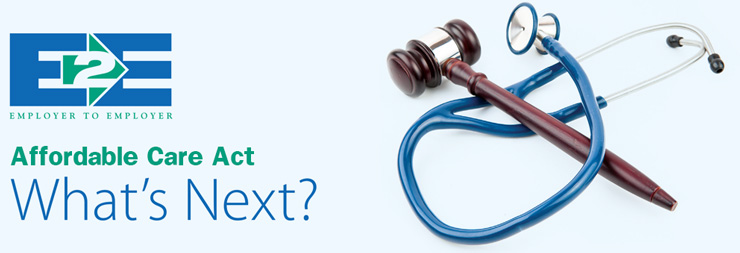
House Republicans Release Details of their ACA Replacement
The Affordable Care Act is still the law of the land…
BUT here are the changes that the House of Representatives just passed. Now it is up to the Senate …
Keeping you informed is an important part of what we do.From the Desk of Larry Grudzien, Attorney at Law
House Republicans Release Details of their ACA Replacement
MAY 5, 2017 – Yesterday, the House Republicans released a summary of their replacement to the Affordable Care Act. It is called the American Health Care Act (the “Act”).
Please find below a link to this section-by- section summary of the Act This official summary incorporates changes to an earlier version of the bill (the changes being popularly known as the MacArthur Amendment and the Upton Amendment).
https://benefitslink.com/src/legislation/AHCA-Section-by-Section-Summary.pdf
If you have any comments or questions regarding any of the above information, please do not hesitate to call me at (708) 717-9638 or e-mail me at larry@larrygrudzien.com.
Thank-You,
Larry Grudzien
Attorney-At-Law - August 24, 2016

Healthcare and the Small Business Owner
Healthcare and the Small Business Owner: Two Keys
Since Jan. 1, 2014, Americans have been required under federal law to purchase health insurance. Every employee of a small business in 2014 had to either maintain health insurance or pay a fine equivalent to 1 percent of his or her income, above the tax-filing threshold. In 2015 that penalty will jump to 2 percent of adjusted gross income. Open enrollment runs from Nov. 15 through Feb. 15 and is the time during which health insurance companies and HMOs are required by law to accept applicants without regard to health history. So how does this new healthcare landscape affect small business owners? There are two main things small business owners should know.
1. Businesses with fewer than 50 full-time employees are not required to offer health insurance.
However, any small business with 50 to 99 full-time employees will have until 2016 to begin offering health insurance to 95 percent of their full-time employees or pay a fine. These businesses must still carefully track employee’s hours and report information to the IRS beginning in 2015. The timeline is accelerated for business with 100 or more full-time equivalent employees. These businesses must offer affordable health insurance to at least 70 percent of their full-time employees beginning in 2015 or pay a fine. That number increases to 95 percent in 2016.
2. There is no one size fits all for offering health insurance to employees.
Because each employer’s circumstances are different, owners should explore all options available—from providing group health plans to contributing defined dollar amounts to their employees monthly.

For small business not offering group health plans, Unland Insurance has developed the Smart Choices™ Marketplace. The Smart Choices™ Marketplace is a health insurance exchange where individuals can compare plans, select and apply for health insurance in a simple, stress free and intuitive online hub. This new health insurance exchange offers plenty of choices without overwhelming shoppers, and can help your employees find the right health insurance in as little as 12 minutes. Furthermore, because it’s not affiliated with any specific carrier, employees will be able to choose between well-known national and regional health insurance companies, as well as insurance plans on the public exchange.
Time is running out for employees to select their 2015 health insurance plan. Contact us today, or visit the Smart Choices Marketplace.
- August 24, 2016

Are you fully prepared for new ACA form requirements?
There’s a big new change this year that may take many people by surprise.
Changes associated with the Affordable Care Act mean that most taxpayers will receive unfamiliar tax forms this year: either form 1095-A, 1095-B or 1095-C.
Confused by the difference?
- Form 1095-A is a form sent by the Health Insurance Marketplace to individuals who enrolled in coverage there. The deadline for the Marketplace to complete that form is Feb. 1, and anyone who expecting to receive this form should wait to file their 2015 income taxes until they receive this form from the Marketplace.
- Form 1095-B is a form sent by health insurance providers to the individuals they cover. The deadline to provide this form has been extended to March 31. Individual taxpayers will generally be able to file their returns as they normally would.
- Form 1095-C is a form sent by certain employers, especially employers that offer “self-insured coverage.” The deadline to provide this form has been extended to March 31. Individual taxpayers will generally be able to file their returns as they normally would.
Do you need further information about the ACA and the new 1095 forms, or do you need help providing the 1095 to your employees?
Contact your Unland agent or account manager for assistance.
Do you need help explaining the 1095 to your employees?
Because this form is new, many employees will not be expecting to receive it and may not understand its importance. Unland has a sample letter you can customize for your employees.
- August 24, 2016

Featured Communications Digest for the Week
Workers’ Compensation Audit Checklist
This document provides a list of important items that business owners should do before, during and after a workers’ compensation audit. Download Here.
Educating Employees on Voluntary Benefits
Offering voluntary benefits is a great way to enhance your benefits package, differentiate from competitors and increase employee satisfaction—all with little impact on your budget. But while employers may choose to offer numerous types of voluntary benefits that can deliver convenience and value for employees, many employees do not understand the advantages of these voluntary benefit options or are unclear how they work. Educate your employees on the advantages of these voluntary benefits so that you both reap the rewards.
Demonstrate the Value
When compared to employer-sponsored benefits, many employees may fail to see the value of voluntary benefits that they must personally finance. For example, one perk to voluntary benefits is that purchasing insurance through an employer group is often cheaper than buying individually, yet research shows that few employees are aware of this. When promoting your voluntary benefit options, discuss the benefits of having coverage, the risks of going without, and emphasize the convenience and value of purchasing through the company and paying through payroll deductions.
Coverage Education
It is important that employees fully understand their policy so that a misunderstanding does not lead to resentment toward the employer. For instance, if a consumer does not completely understand the nuances of property-casualty insurance and believes herself to be covered, it will come as a shock and possibly with misdirected frustration in the event of a major loss.
When offering any benefit option, employer-paid or voluntary, you should be sure your employees understand exactly how the coverage works. Here are a few ways to make sure your employees are sufficiently educated about their benefits:
- Invite current employees to the monthly or quarterly benefits meetings provided for newly hired individuals.
- Many voluntary benefits providers are willing to send a representative to discuss their coverage with employees.
- While most benefits administrators don’t have time to meet individually with employees, consider scheduling small-group meetings with a few employees who have questions.
- Enhance your existing benefits communication program with social media. Social media provides a convenient and effective way to reach out to your employees with educational information, tips and reminders.
Employer Advantage
In addition to boosting participation in your voluntary benefits programs, providing this meaningful education can position you as a valuable source of knowledge and strengthen employee satisfaction and loyalty to your company.
Talk to your The Unland Companies representative to learn more about available social media and employee benefit communication resources.
2017 Cyber Risk Survey
Cyber attacks are becoming more common and more sophisticated, making cyber insurance a necessity. The 2017 Cyber Risk Survey provides a look at the current state of cyber coverage as well as the common exposures that businesses face. Click here to download.
8 Ways to Improve Your Culture
1. Recognize and reward valuable employee contributions. According to Deloitte, the top 20 percent of companies with a recognition-based culture have a 31 percent lower turnover rate. Fifty percent of workers surveyed by CareerBuilder believe that recognition is a factor that drives retention. To effectively implement a rewards-rich work environment, be sure to do the following:
- Identify specific behaviors and/or results aligned with your company’s values. Recognize those behaviors as frequently as possible.
- Make it easy for everyone at your company to recognize and reward co-workers’ behaviors. Often, peer-to-peer recognition is the most effective way to infuse recognition into your culture.
2. Encourage employee autonomy. It’s no secret that micromanaging your employees rarely produces favorable outcomes. Trusting your employees to manage their responsibilities on their own is not as simple as it sounds, though. Some simple, yet effective ways to inspire employee autonomy include the following:
- Establishing autonomous work groups
- Reining in bosses or co-workers who tend to hover over others
- Creating decision-making opportunities
3. Incorporate flexibility into your organization. Workplace flexibility can improve morale and reduce turnover. In fact, 51 percent of workers surveyed by CareerBuilder believe that a flexible schedule is a factor that significantly drives retention. Workplace flexibility programs are up to the organization’s discretion, but common ways flexibility is demonstrated include the following:
- Telecommuting (work from home) opportunities
- Flexible scheduling opportunities
- Paid time off (PTO) policies
4. Provide regular and timely feedback. Once-a-year feedback is a thing of the past. Younger generations thrive in environments where they know exactly how they are doing. Continuous, meaningful feedback provides employees with the tools they need to improve and grow. Opportunities to provide feedback outside of performance reviews could include the following:
- Monthly or semi-monthly check-ins between a supervisor and employee
- Peer-to-peer weekly check-ins
- Mentoring programs
5. Embrace workplace transparency. Trust is the foundation of a great company culture. Transparency can improve employees’ trust of upper management, give employees insight into a company’s operations and future, and improve cross-departmental collaboration. One way to improve your organization’s transparency is to share both the successes and challenges your organization and its employees face with everyone.
Another way to improve the transparency in your organization is to implement modern communication and collaboration tools. These tools make it easy for your employees to connect with one another and share crucial information. Listed below are popular tools used by other companies for chat and collaboration, video conferencing and project management purposes.
· Chat and collaboration
o Yammer
o HipChat
o Google Apps for Business
· Video conferencing
o Skype
o Google Hangout
· Project management
o Jira
o Trello
6. Promote strong professional co-worker relationships. According to the Society for Personality and Social Psychology, when individuals identify with and are invested in professional relationships with their colleagues, workplace productivity increases, employee morale increases and burnout levels decrease. However, building strong relationships takes time and effort. To help your employees, consider the following suggestions:
- Encourage collaboration and peer-to-peer work.
- Create “collision points” in your office. Collision points include areas like a communal coffee station or cafeteria.
- Host events. No matter how small (think: team happy hour) or large (think: corporate outing), employer-sponsored events are a great way for employees to interact with peers that they normally would not on an average day.
7. Create a mentoring program. Providing employees with professional development opportunities is a low-cost retention tool and a simple way to improve employee engagement and your company culture. A mentor is an individual in the workplace who shares his or her knowledge and expertise to help another employee grow professionally. Some companies use group mentoring, third-party mentoring or reverse mentoring, while others use peer mentoring, flash mentoring or one-to-one pair mentoring.
Mentoring programs provide benefits to all parties involved. Benefits include the following:
- Skill development. Mentors teach mentees the skills and qualities necessary for success. Mentoring provides mentors with the opportunity to develop their communication and leadership skills.
- Improved networking and teamwork. Mentoring allows employees to build a professional relationship over a period of time and teaches them about the value of networking. This also instills a sense of cooperation and teamwork at your company.
8. Improve your “soft” benefits offerings. There are a variety of employer-sponsored programs that encourage employee engagement, increase employee morale and attract new talent. Workplace flexibility is a highly effective benefits offering. Other top benefits to offer are listed below.
· Wellness incentives
o Subsidize gym memberships.
o Provide healthier food and beverage choices.
o Sponsor company sports teams.
· Trendy, new voluntary benefits
o Identity theft protection
o Student loan repayment programs
o Financial counseling services
o Pet insurance
o Discount programs
· Child care benefits
o On-site child care
· Fringe benefits
o Company-provided beverages and food
A great company culture attracts the best workers, increases retention and improves employee performance. These eight suggestions can positively impact your existing or new company culture.
- August 24, 2016

Strong Leadership, Changing Roles
Strong Leadership, Changing Roles
Effective January 1, 2016, The Unland Companies continues to build upon its strong leadership, with some of the senior management changing roles. Although duties may have expanded or changed slightly with some variation in titles, the shifts will be seamless for both customers and employees.
Afton Booth, CIC, CSRM, has become Chairman of the Board. The former President, Afton has been with The Unland Companies for over 35 years in various capacities, including sales, sales management, Vice President and President. Afton is continuing his long-term client relationships, while developing new business opportunities, mentoring existing agents and reaching out to the marketplace for acquisition possibilities that will assist with our non-organic growth plans. Afton is accessible in both the Pekin and East Peoria offices.
Patrick Taphorn, CIC, CSRM, has become President. A 25-year employee and the former Vice President, Pat has excelled in insurance sales and management. His experience and proven accomplishments with the Unland sales force and other senior management equips him for this leadership position. Pat continues to oversee the growth and success that The Unland Companies has experienced over the last 75 years, while taking on some of the administrative tasks previously handled by Afton Booth.
Bill Shock, CBC, continues as Executive Vice President, but takes on more administrative duties while helping to ensure Pat’s shift is a smooth one. Bill joined forces with The Unland Companies in July of 1989, but also owned and operated The Shock Agency prior to that time. Bill continues his oversight of the Personal Lines Division and Benefits Division for the agency, including assisting and guiding current and future clients toward Affordable Health Insurance products during this challenging era of Healthcare Reform.
Nate Rugaard, CIC, has become Vice President. Nate has been with the agency since 2013 and has demonstrated a very high level of success in enhancing his technical knowledge of industry policies and risk management while developing a solid client base in which to impart that expertise. Nate will take over Pat’s responsibilities, wherein he will oversee the existing sales force and develop new talent, while monitoring the overall production for the agency.
“The Unland Companies has been a long-time insurance partner in Central Illinois over the last 75 years. Our employees are exceptional in what they do for our clients, and this service will not change. The shifts in titles and subsequent duties assigned those individuals will position the company very well for further growth, enhancing both our commercial and personal product expertise while expanding our geographic reach. This natural succession will assure that The Unland Companies remains a leader in the insurance industry here in Central Illinois,” Pat shared. “It’s an honor to continue the great work Afton has already begun, and I look forward to working even more closely with Bill, who continues to play a key role in the company’s growth. We are fortunate to have such respected leaders who have selflessly contributed to the company’s vision, along with dedicated, professional employees who have helped to create the superior service The Unland Companies provides to our many clients.”
An employee-owned company, The Unland Companies is a full-service, independent insurance agency providing broad personal and commercial insurance coverage, human resource services and financial services at an affordable cost, backed by superior service. For additional information, contact us to speak to a representative.
- August 24, 2016

Affordable Care Act
Healthcare has seen many changes over the decades – none more significant than the Affordable Care Act (ACA). Unfortunately, the ACA hasn’t gone off without a hitch, least of all for small business owners.
How is the Affordable Care Act affecting small business owners?
Since its creation, new tax penalties have been brought into action by the ACA in an effort to enforce compliance. However, these penalties are still largely unknown and greatly misunderstood, even by small business tax advisors. This poses a serious problem for small business owners seeking to be compliant with new laws when they file their 2014/2015 federal income tax returns. Even more unfortunately, several insurance firms are even taking advantage of the situation, marketing non-compliant solutions and products through online media, resulting in more unnecessary penalties for small business owners.
Why are there so many penalties during this transition?
While it’s a safe conclusion that the Department of Labor and the Internal Revenue Service have failed to effectively communicate the details of new ACA laws, the IRS believes that enforcing tax penalties is the best way to increase communication and compliance.
What happens if I unknowingly fail to comply?
While the tax penalties are generally severe for compliance failure, the law contains provisions for small businesses that do so unintentionally. The first tax penalties will be addressed in spring 2015 as business owners begin to file their 2014 returns.
What are the most common ACA compliance failures?
Among the most common compliance errors are:
- Reimbursing expenses paid out-of-pocket when the employee is not on employer group health insurance – this is an error rumored to affect more than a million small businesses.
- Using non-qualifying “skinny insurance” or “mini-med” insurance – This type of insurance will eliminate one excise tax penalty but not the other. This point only applies to businesses with over 50 employees. This type of insurance eliminates one type of excise tax penalty but not the other type of penalty.
- Expecting repeal of ACA or significant future changes – small businesses can’t rely on the news and opinions to run a business.
- Paying employees for or reimbursing individual health insurance – rarely should an employer have connection to individual insurance purchased through an exchange or direct from an insurance company.
- Not maintaining written documentation of health plans – employees are required to provide some health plan documents and notifications in writing for employees, and employers should maintain of their delivery.
Are there any resources to assist in compliance?
Fortunately, small business compliance is as simple as following a checklist. Download the ACA Compliance Checklist and use it as you file your return. As long as you can check off each item, you should be penalty free in 2015.
More questions about ACA compliance? Contact Bill Schock at bshock@unland.com, and find out how your small business can be compliant in 2015.
- August 24, 2016

New Local Health Plan for Small Businesses
New Local Health Plan for Small Businesses
On January 1, 2015, Pekin Hospital and Pekin Insurance® formed a partnership to create a local health plan to serve the health care needs of their employees. This plan is now available to all local businesses with less than 100 employees!
Why a local health plan?
Pekin Hospital and Progressive Health Network have over 300 credentialed physicians and specialists and can provide more than 80% of all necessary health care services.
Pekin Hospital is an award-winning community hospital.
Pekin Insurance is a highly rated health insurance provider ranking in the top 15% of Life and Health insurance companies nationwide based on premiums written and rated at A- (Excellent) by A.M. Best.
The goal—create a health plan that:
Delivers excellent value to employees by reducing out-of-pocket expenses through lower deductibles and copays (and meets all Affordable Care Act requirements).
Provides greater access to both primary care providers as well as specialists.
Offers the combined management expertise of medical professionals through Pekin Hospital and insurance professionals through Pekin Insurance.
How does the plan work?
The plan offers access to providers based upon a three (3) tiered platform:
Tier 1 – Pekin Hospital and Progressive Health Network—This tier offers the lowest deductibles, copays, and overall out-of-pocket.
Tier 2 – Unity Point Health Methodist—Services provided at this level are still paid using the lowest deductibles and copays as long as the service is NOT available from a tier 1 provider.
Tier 3 – Out-of-Network—Services provided via this tier will receive the highest deductibles, copays, and overall out-of-pocket expenses.
For more information on the plan or to inquire about an insurance quote, please contact Jennifer Gray, Network Coordinator at Pekin Hospital, at 309-353-0444 or jgray@pekinhospital.com. Jennifer will be happy to answer any questions you may have and to put you in touch with a local Pekin Insurance agency.
This plan is a win—for your business, your employees, your budget, and your community!
- August 24, 2016

Affordable Care Act – What’s Next?
If you missed our E2E seminar – “Affordable Care Act – What’s Next?” – be sure to watch the videos of our speakers:
Erik Christian, Principal Consultant, HR Fit
HR Best Practice and Compliance Changes
How to Manage and Implement Changes for Your WorkplaceErik Christian, Principal Consultant, HR Fit, has a wealth of experience working with private, public and non-profit employers on improving their core HR functions.
James Slotnick, JD, AVP, Advanced Markets and Broker Education, Sun Life Financial
What changes are likely?
How might it affect employers?
When might we expect the changes to be announced?Other thoughts pursuant to national health care and employer sponsored benefits James Slotnick, JD, AVP, Advanced Markets and Broker Education, Sun Life Financial, has been helping employee benefit brokers, financial advisors, and the end consumer understand the ever-changing insurance industry for more than a decade.
Mike Reier, CEO, Benovate Holdings
Mike Reier, CEO, Benovate Holdings, brought his 25 years of experience as an entrepreneurial, sales, and technology sector leader to us over a working lunch. Mike works with more than 130 Reier Group clients as a change agent, helping organizations effectively develop, assess and deploy marketing and sales solutions to help drive revenue growth.
Larry Grudzien, JD, LLM, Benefit Attorney
PPACA’s current and future points of guidance and compliance
Reporting and planning opportunities
Wellness and self-funding planning opportunities
State Insurance Exchanges – Future?
Private Insurance Exchanges – Future?
Community Based Rating – Will it go away?Larry Grudzien, JD, LLM, Benefit Attorney, is an attorney practicing exclusively in the field of employee benefits. He has experience in dealing with qualified plans, health and welfare, fringe benefits and executive compensation areas.
Bob Thomas, Vice President, Resourcing Edge
The PEO Solution
Bob Thomas has been with Resourcing Edge for three years and serves as the Vice President of Resourcing Edge and in that capacity has oversight of the Benefits Department and Strategic Partnerships with Agencies and Brokers. Resourcing Edge is a full service provider of Payroll, Employee Benefits, and HR solutions.
- August 23, 2016

Employer Reporting of Health Coverage
Employer Reporting of Health Coverage—Code Sections 6055 & 6056
The Affordable Care Act (ACA) created new reporting requirements under Internal Revenue Code (Code) Sections 6055 and 6056. Under these new reporting rules, certain employers must provide information to the IRS about the health plan coverage they offer (or do not offer) to their employees. The additional reporting is intended to promote transparency with respect to health plan coverage and costs. It will also provide the government with information to administer other ACA mandates, such as the large employer shared responsibility penalty and the individual mandate.
Overview
Type of Reporting
Affected Employers
Required Information
Effective Date
Code §6055—Reporting of health coverage by health insurance issuers and sponsors of self-insured plans Employers with self-insured health plans Information on each individual provided with coverage (helps the IRS administer the ACA’s individual mandate) Delayed until 2015
The first returns will be due in 2016 for coverage provided in 2015
Code §6056—Applicable large employer (ALE) health coverage reporting Applicable large employers (those with at least 50 full-time employees, including full-time equivalents) Terms and conditions of health plan coverage offered to full-time employees (helps the IRS administer the ACA’s employer shared responsibility penalty) Guidance
On March 5, 2014, the Internal Revenue Service (IRS) released two final rules on these reporting requirements, which apply for calendar years beginning after Dec. 31, 2014. This date reflects a one-year delay provided in IRS Notice 2013-45. However, the IRS is encouraging voluntary compliance for 2014. The IRS also released Q&As on Section 6055 and Q&As on Section 6056, which were updated in May 2015. In addition, the IRS released a separate set of Q&As on Employer Reporting using Form 1094-C and Form 1095-C, on May 28, 2015.
On Feb. 8, 2015, the IRS released final versions of forms and instructions that employers will use to report under Sections 6055 and 6056 for 2014. These forms are not required to be filed for 2014, but reporting entities may voluntarily file them in 2015 for 2014 coverage.
On Sept. 17, 2015, the IRS released the following final 2015 versions of the forms and instructions that employers will use to report under Sections 6055 and 6056. On the same day, the IRS issued Notice 2015-68 to provide additional guidance for purposes of Section 6055 reporting.
- Form 1094-B and Form 1095-B (and related instructions) will be used by entities reporting under Section 6055, including sponsors of self-insured group health plans that are not reporting as ALEs.
- Form 1094-C and Form 1095-C (and related instructions) will be used by ALEs that are reporting under Section 6056, and for combined reporting by ALEs that sponsor self-insured plans required to report under both Sections 6055 and 6056.
The 2015 final forms remained unchanged from the 2015 draft versions. The 2015 final instructions were also largely unchanged from the 2015 draft versions, but provide clarifications on some questions. The final instructions also contain the following key provisions:
- Extensions of time to file returns with the IRS and furnish statements to individuals (finalized from draft versions);
- A process to obtain waivers from the electronic filing requirement (finalized from draft versions); and
- Relief from separate Section 6055 reporting for many health reimbursement arrangements (HRAs) (clarified from prior guidance and draft versions).
Also, on June 29, 2015, President Obama signed the Trade Preferences Extension Act of 2015 into law, which increases the penalties for failure to file correct information returns or provide individual statements under either Section 6055 or Section 6056. These changes are effective for information returns and individual statements required to be filed or provided after Dec. 31, 2015.
Filing Requirements
Under both Sections 6055 and 6056, each reporting entity will be required to file all of the following with the IRS:
- A separate statement for each individual who is provided minimum essential coverage (MEC) (for ALEs, this includes only full-time employees); and
- A single transmittal form for all of the returns filed for a given calendar year.
Under Code Section 6055, reporting entities will generally file Forms 1094-B (a transmittal) and 1095-B (an information return). Under Code Section 6056, entities will file Forms 1094-C (a transmittal) and 1095-C (an information return) for each full-time employee for any month. Entities that are reporting under both Sections 6055 and 6056 will file using a combined reporting method, using Form 1094-C and Form 1095-C.
ALEs that sponsor self-insured plans
ALEs that sponsor insured plans
Non-ALEs that sponsor self-insured plans
Non-ALEs that sponsor insured plans
Complete: Form 1094-C
Both sections of Form 1095-C
Complete: Form 1094-C
The section of Form 1095-C addressing the information under Section 6056
File: Form 1094-B
Form 1095-B
These employers are not required to report under either Section 6055 or Section 6056.
To report: (1) Information under Section 6055 about health coverage provided; and
(2) Information under Section 6056 about offers of health coverage.
To satisfy the Section 6056 reporting requirements. These employers are not required to report under Section 6055. To satisfy the Section 6055 reporting requirements. These employers are not required to report under Section 6056. Deadlines for Filing with the IRS and Furnishing Statements to Individuals
The Code Sections 6055 and 6056 reporting requirements were set to take effect in 2014. However, on July 2, 2013, the Treasury announced that employers will have an additional year to comply with these health plan reporting requirements. Thus, the Code Sections 6055 and 6056 reporting requirements become effective in 2015. The first returns will be due in 2016 for coverage provided in 2015.
On July 9, 2013, the IRS issued Notice 2013-45 to provide transition relief for 2014 for Code Sections 6055 and 6056. Under the transition relief, employers are encouraged to voluntarily comply with the reporting requirements for 2014 (that is, by filing and furnishing Section 6056 returns and statements in early 2015). However, compliance is optional for 2014 and no penalties will be applied for failing to comply.
Deadlines for Filing with the IRS
Forms must be filed with the IRS annually, no later than Feb. 28 (March 31, if filed electronically) of the year following the calendar year to which the return relates. Due to the one-year delay, the first returns required to be filed are for the 2015 calendar year, and must be filed no later than Feb. 29, 2016 (Feb. 28, 2016, being a Sunday), or March 31, 2016, if filed electronically.
Reporting entities may receive an automatic 30-day extension of time to file with the IRS by completing and filing Form 8809, Application for Extension of Time To File Information Returns, by the due date of the returns. The form may be submitted on paper, or through the FIRE System either as a fill-in form or an electronic file. No signature or explanation is required for the extension.
Under certain hardship conditions, employers may also apply for an additional 30-day extension. See the instructions for Form 8809 for more information.
Deadlines for Furnishing to Individuals
Each reporting entity will also be required to furnish statements annually to individuals who are provided MEC (for ALEs, this includes only full-time employees) on or before Jan. 31 of the year immediately following the calendar year to which the statements relate. This means that the first statements (the statements for 2015) must be furnished no later than Feb. 1, 2016 (Jan. 31, 2016, being a Sunday). Extensions may be available in certain circumstances.
The final rules do not allow an alternate filing date for employers with non-calendar year plans. Although employers may collect information on a plan year basis, employees will need to receive their individual statements early in the year in order to have the requisite information to correctly and completely file their income tax returns for that year.
However, reporting entities may request an extension of time to furnish the statements to recipients by sending a letter to Internal Revenue Service, Information Returns Branch, Attn: Extension of Time Coordinator, 240 Murall Drive, Mail Stop 4360, Kearneysville, WV 25430. The letter must include:
- The filer’s name, TIN and address;
- The type of return;
- A statement that extension request is for providing statements to recipients;
- A reason for delay; and
- The signature of the filer or authorized agent.
A request must be postmarked by the date on which the statements are due to the recipients. If the request for an extension is approved, providers will generally be granted a maximum of 30 extra days to furnish the recipient statements.
Manner of Filing and Furnishing
Any reporting entity that is required to file at least 250 returns under Section 6055 or Section 6056 must file electronically. The 250-or-more requirement applies separately to each type of return and separately to each type of corrected return. Entities filing fewer than 250 returns during the calendar year may choose to file in paper form, but are permitted (and encouraged) to file electronically.
Individual statements may also be furnished electronically if certain notice, consent and hardware and software requirements are met (similar to the process currently in place for the electronic furnishing of employee Forms W-2). The consent must specifically identify each form; an employee’s consent to receive a Form W-2 electronically may not be considered a consent to also receive the employee statement under Sections 6056 or 6056 electronically. It is not sufficient for an entity to simply post the information on a website accessible to the individual (similar to the current process for furnishing SBCs), or to provide the information only upon request.
Electronic filing will be done using the ACA Information Returns (AIR) Program. Pub. 5165, Guide for Electronically Filing ACA Information Returns for Software Developers and Transmitters (Processing Year 2015) provides very detailed technical information regarding standards for software developers and transmitters that plan to facilitate this electronic reporting for calendar year 2015 through the AIR System. To develop software for use with the AIR system, software developers, transmitters and issuers (providers filing their own Forms 1094-B and 1095-B) should use the guidelines provided in Pub. 5165 along with the Extensible Markup Language (XML) Schemas published on IRS.gov.
More information on the AIR Program is available on the IRS website. The AIR System is expected to be available for production in the fall of 2015.
Waiver of the Electronic Reporting Requirement
The 2015 instructions include a waiver from the requirement to file returns electronically. To receive a waiver, reporting entities must submit Form 8508, Request for Waiver From Filing Information Returns Electronically, at least 45 days before the due date of the returns. Reporting entities cannot apply for a waiver for more than one tax year at a time, and must reapply at the appropriate time for each year in which a waiver is required. Any approved waivers should be kept for the reporting entity’s records only. A copy of an approved waiver should not be sent to the service center where paper returns are filed.
If a waiver for original returns is approved, any corrections for the same types of returns will be covered under the waiver. However, if original returns are submitted electronically, but the reporting entity wants to submit corrections on paper, a waiver must be approved for the corrections if the reporting entity must file 250 or more corrections.
Without an approved waiver, a reporting entity that is required to file electronically but fails to do so may be subject to a penalty of up to $250 per return, unless it can establish reasonable cause. However, reporting entities can file up to 250 returns on paper; those returns will not be subject to a penalty for failure to file electronically.
Applicable Large Employer Health Coverage Reporting (Code § 6056)
Code Section 6056 requires applicable large employers (ALEs) subject to the ACA’s employer shared responsibility rules to file information returns with the IRS and provide statements to their full-time employees about the health insurance coverage the employer offered. The IRS will use the information provided on the information return to administer the ACA’s employer shared responsibility rules, which impose penalties on ALEs that do not offer affordable, minimum value coverage to their full-time employees and dependents.
The ACA’s employer penalties were set to take effect on Jan. 1, 2014, but they have been delayed until 2015. The IRS and the ALE’s employees will use the information provided as part of the determination of whether an employee is eligible for a premium tax credit for coverage purchased through an Exchange under the ACA. On March 5, 2014, the IRS released a final rule on the Section 6056 reporting requirements, which finalizes proposed regulations issued on Sept. 5, 2013. Q&As on Section 6056 were also released in August 2014, and were updated in May 2015. A separate set of Q&As on using Form 1094-C and Form 1095-C were issued on May 28, 2015.
The IRS released final 2014 versions of the following forms, along with related instructions, that employers will use to report under Section 6056, as well as for combined reporting by ALEs who report under both Sections 6055 and 6056:
- Form 1094-C, Transmittal of Employer-Provided Health Insurance Offer and Coverage Information Return; and
- Form 1095-C, Employer-Provided Health Insurance Offer and Coverage.
These forms and instructions are 2014 versions only. These forms are not required to be filed for 2014, but reporting entities may voluntarily file them in 2015 for 2014 coverage.
On Sept. 17, 2015, the IRS released final 2015 versions of Forms 1094-C and 1095-C, along with related instructions. The 2015 final forms remained unchanged from the 2015 draft versions. The 2015 final instructions were also largely unchanged from the 2015 draft versions, but provide clarifications on some questions. The following minor changes were included in the 2015 draft (and subsequent final) versions of the Forms:
- Form 1095-C includes an additional field, titled “Plan Start Month.” This new field is optional for 2015, but will be required for 2016 and beyond. For 2015, ALEs can choose to: (1) Add this field and provide plan year information; (2) Add this field and enter “00”; or (3) Leave this new field out (thus using the 2014 format).
- Form 1095-C includes a “Continuation Sheet” that filers will use if they need to report coverage information for more than six individuals.
- Form 1094-C moved Line 19 (regarding the authoritative transmittal) to be included in Part I. Line 19 was previously included as the first line of Part II.
- Form 1094-C allows information to be entered in the “All 12 months” box in Part III, column (b): Full-Time Employee Count for ALE Member (this box is no longer grayed).
In addition, the IRS indicated that they intend to include two additional “Offer of Coverage” codes for 2016 and beyond. Although the “Offer of Coverage” codes will remain unchanged for 2015, the IRS plans to include these additional codes in 2016 and beyond that an employer would use, if applicable, to indicate that the employer’s offer of coverage to the spouse is a conditional offer.
Affected Employers
The Section 6056 reporting requirements apply to “applicable large employers” (ALEs) subject to the ACA’s employer shared responsibility rules. An ALE is an employer that employed an average of at least 50 full-time employees, including full-time equivalents (FTEs), on business days during the preceding calendar year. Full-time employees are those employed, on average, at least 30 hours of service per week. Whether an employee qualifies as a full-time employee is determined under either the look-back measurement method or the monthly measurement method, as described in the employer shared responsibility final regulations.
Section 6056 applies to all employers that are ALEs, regardless of whether coverage is offered to full-time employees, and regardless of the employer is a tax-exempt or government entity (including federal, state, local and Indian tribal governments). However, only ALEs with full-time employees are subject to the Section 6056 requirements (and only with respect to their full-time employees). Thus, ALEs without any full-time employees are not subject to the Section 6056 reporting requirements.
Controlled Group Rules
For purposes of the Section 6056 reporting requirements, related employers are treated as a single employer for determining employer size if they meet certain IRS criteria. Thus, all persons treated as a single employer under Code Sections 414(b), (c), (m) or (o) are combined and treated as a single employer for purposes of determining whether or not the employer has at least 50 full-time employees (including FTEs) and together will be an ALE (called an Aggregated ALE Group). When the combined total of full-time employees (including FTEs) meets the threshold, each separate company (or ALE member) is subject to the Section 6056 reporting requirements, even if any particular company individually does not employ enough employees to meet the 50-full-time-employee threshold.
However, each ALE (and each member of a group of related companies that constitute an ALE) is responsible for its own reporting obligations. For purposes of the information reporting requirements under Section 6056, each ALE member must file an information return with the IRS and furnish a statement to its full-time employees, using its own employer identification number (EIN).
Reporting for Medium-sized ALEs
The employer shared responsibility final regulations included transition relief delaying compliance for medium-sized ALEs for one year, until 2016. Medium-sized ALEs are those with at least 50 full-time employees (including full-time equivalents), but fewer than 100 full-time employees (including full-time equivalents).
ALEs eligible for this transition relief will still report under Section 6056 for 2015.
As part of the transition relief from the employer shared responsibility rules for medium-sized ALEs, the ALE must certify by checking a box on its Section 6056 transmittal form (Form 1094-C) for calendar year 2015 (that is, for the Section 6056 transmittal form that will be filed in 2016) that it meets the following eligibility conditions:
- The ALE employs a limited workforce of at least 50 full-time employees (including full-time equivalents), but fewer than 100 full-time employees (including full-time equivalents) on business days during 2014;
- Between Feb. 9, 2014, and Dec. 31, 2014, the ALE does not reduce the size of its workforce or the overall hours of service of its employees in order to satisfy the workforce size condition; and
- During the coverage maintenance period (that is, the period ending Dec. 31, 2015, or the last day of the plan year that begins in 2015), the ALE does not eliminate or materially reduce the health coverage, if any, it offered as of Feb. 9, 2014.
ALEs with non-calendar year plans will also certify with regard to their 2015 plan year, including:
- The months of their 2015 plan year that fall in calendar year 2015, on the Section 6056 transmittal form for 2015 (that is, the form that will be filed in 2016); and
- The months of their 2015 plan year that fall in calendar year 2016, on the Section 6056 transmittal form for 2016 (that is, the form that will be filed in 2017).
The IRS noted that the delay for medium-sized ALEs is solely for the employer for purposes of the employer shared responsibility rules, and does not affect the employee’s potential eligibility for the premium tax credit. Accordingly, regardless of whether the employer is eligible for this delay, the Form 1095-C for each full-time employee must accurately reflect the health coverage offered to that employee (if any) during that period, including, if applicable, the required employee contribution.
Thus, reporting for medium-sized ALEs is not a simplified method of reporting.
ALEs That Sponsor Self-Insured Plans
ALEs that sponsor self-insured group health plans also are required to report information under Section 6055 about the health coverage they provide. The IRS and individuals will use the information provided under Section 6055 to administer the ACA’s individual mandate.
These ALEs file with the IRS and furnish to employees the information required under both Sections 6055 and 6056 on a single form, using a combined reporting method. This combined reporting method is described in more detail below.
Excluded Employers
Employers that are not subject to the ACA’s employer shared responsibility rules are not required to report under Section 6056. Thus, employers that employed fewer than 50 full-time employees (including FTEs) during the prior year are not subject to the reporting requirements. However, any employer that sponsors a self-insured health plan is required to report under Section 6055, even if the employer has fewer than 50 full-time employees.
Reporting Required for All Full-time Employees
Under Section 6056, each ALE is required to report information about the health coverage, if any, offered to its full-time employees (and their dependents), including whether an offer of health coverage was (or was not) made. This requirement applies to all ALEs, regardless of whether they offered health coverage to all, none or some of their full-time employees. For each full-time employee, regardless of whether health coverage was offered to the employee, the ALE is required to file a return with the IRS and furnish a statement to the employee reporting:
- Whether an offer of health coverage was or was not made to the employee; and
- If an offer was made, the required information about the offer.
Therefore, even if an ALE does not offer coverage to any full-time employees, it must file returns with the IRS and furnish statements to each of its full-time employees to report information specifying that coverage was not offered.
An ALE is not required to file a Form 1095-C for an individual who, for all months of a calendar year, is either not an employee of the ALE or is in a limited non-assessment period (for example, an employee who was hired mid-year and then was in an initial measurement period that continued into the following year). However, for the months in which the employee was an employee of the ALE, he or she would be included in the total employee count reported on Form 1094-C. Also, if the employee enrolled in self-insured employer-sponsored coverage during the limited non-assessment period, the ALE must file a Form 1095-C for the employee to report coverage information for the year.
Information Required to Be Reported on the IRS Return
The ALE’s return filed with the IRS must include the following information:
- The ALE’s name, address and employer identification number (EIN);
- The name and telephone number of the ALE’s contact person;
- A certification of whether the ALE offered to its full-time employees (and their dependents) the opportunity to enroll in minimum essential coverage (MEC) under an eligible employer-sponsored plan, by calendar month;
- The months during the calendar year for which MEC under the plan was available;
- Each full-time employee’s share of the lowest cost monthly premium for self-only coverage providing minimum value offered to that employee under an eligible employer-sponsored plan, by calendar month;
- The number of full-time employees for each month during the calendar year;The name, address (including country code) and Social Security number (SSN) or other taxpayer identification number (TIN) of each full-time employee during the calendar year and the months (if any) during which the employee was covered under the eligible employer-sponsored plan during the calendar year; and
- Any other information required by the IRS.
Most employer-sponsored health plans will qualify as MEC. The ACA broadly defines MEC to include both insured and self-insured group health plans, as well as plans with grandfathered status under the ACA. However, MEC does not include specialized coverage, such as coverage only for vision care or dental care, workers’ compensation, disability policies or coverage only for a specific disease or condition.
Each ALE will also have to report the name, address and EIN of any third party reporting on behalf of the ALE and whether the ALE is a member of an Aggregated ALE Group. The final regulations do not require employers to report whether they expect to be an ALE the following year. Some of the information will be provided through the use of indicator codes, rather than detailed explanations or summaries. If multiple codes apply with respect to a full-time employee for a particular calendar month, the reporting format will accommodate the necessary codes.
Information Required to Be Reported on the Employee Statement
An ALE generally must furnish to each full-time employee a written statement showing the ALE’s name, address and EIN, and the information required to be shown on the Section 6056 return with respect to the full-time employee (and his or her spouse and dependents).
Employers may truncate the TIN or SSN of an employee (or any family member of the employee receiving coverage) on any Form 1095-C statements furnished to employees, by showing only the last four digits of the TIN or SSN and replacing the first five digits with asterisks or Xs. Truncation is not allowed on forms filed with the IRS. In addition, an employer’s EIN may not be truncated on any forms filed with the IRS or provided to individuals.
Methods of Reporting
The final rule provides:
- A general method that all ALEs may use for filing forms with the IRS and furnishing statements to full-time employees; and
- Two alternative reporting methods for eligible ALEs.
If an ALE cannot use an alternative reporting method for certain employees, the ALE must use the general method for those employees. In any case, the alternative reporting methods are optional, so that an employer may choose to report for all of its full-time employees using the general method even if an alternative reporting method is available.
General Reporting Method
As a general method, each ALE may satisfy the requirement to file a Section 6056 return with the IRS by filing:
- A transmittal on Form 1094-C for all of the returns filed for a given calendar year; and
- A separate employee statement on Form 1095-C for each full-time employee.
Substitute forms may be used, as long as they include all of the required information and comply with IRS procedures or other applicable guidance. Entities using substitute forms instead of the official IRS versions may develop substitute forms themselves or buy them from a private printer. Publication 5223, General Rules & Specifications for Substitute ACA Forms 1094-B, 1095-B, 1094-C, and 1095-C and Certain Other Information, explains the requirements for the format and content of substitute statements to recipients. Only forms that conform to the official form and the specifications in Publication 5223 are acceptable for filing with the IRS. Employers may not request special consideration.
An ALE that maintains a self-insured plan also uses Form 1095-C to satisfy the reporting requirements under Section 6055. The Form 1095-C has separate sections to allow ALEs that sponsor self-insured plans to combine reporting to satisfy both the Section 6055 and 6056 reporting requirements, as applicable, on a single return. More information on combined reporting is available in the “Combined Reporting” section below.
The Section 6056 employee statement may be made by furnishing a copy of Form 1095-C for that full-time employee (or another form the IRS designates) or a substitute employee statement for that full-time employee (as long as it includes all of the required information and complies with IRS procedures or other applicable guidance). The employee statement is not required to include a copy of the transmittal form (Form 1094-C).
Alternative Methods
The final rule provides two alternative methods of reporting under Section 6056 that are intended to minimize the cost and administrative tasks for employers. In certain situations, the alternative reporting methods may allow employers to provide less detailed information than under the general method. The two alternative reporting methods are:
- Reporting Based on Certification of Qualifying Offers (the Qualifying Offer Method); and
- Option to Report Without Separate Identification of Full-Time Employees if Certain Conditions Related to Offers of Coverage Are Satisfied (the 98 Percent Offer Method).
In addition, transition relief is available under the Qualifying Offer Method for 2015.
According to the IRS, in some circumstances, only some of the information required under the general method is necessary. Accordingly, the alternative reporting methods identify specific groups of employees for whom simplified alternative reporting would provide sufficient information. If an ALE is not eligible to use an alternative method of reporting with respect to one or more full-time employees, the ALE must use the general method of reporting for those employees. In addition, the alternative methods of reporting are all optional. An employer is not required to use any alternative reporting method, even if it is eligible, and may instead report the more detailed information under the general method of reporting.
Combined Reporting
The final rules under Sections 6055 and 6056 provide for combined reporting for employers that are subject to both reporting provisions (generally, ALEs that sponsor self-insured group health plans). To allow these ALEs to satisfy both reporting requirements on a single return, Form 1095-C has separate sections for reporting under Section 6055 and for reporting under Section 6056. More information on combined reporting is available in the “Combined Reporting” section below.
Reporting of Health Coverage for Issuers and Self-insured Plans (Code § 6055)
The ACA requires every health insurance issuer, sponsor of a self-insured health plan, government agency that administers government-sponsored health insurance programs and any other entity that provides minimum essential coverage (MEC) to file an annual return with the IRS reporting information for each individual who is provided with this coverage. Related statements must also be provided to individuals.
The IRS will use the information from the returns to implement the ACA’s individual mandate (that is, the requirement that individuals obtain acceptable health insurance coverage for themselves and their family members or pay a penalty). The ACA’s individual mandate became effective in 2014.
On March 5, 2014, the IRS released a final rule on the Section 6055 reporting requirements. This rule finalizes proposed regulations issued on Sept. 5, 2013. Q&As on Section 6055 were also released in August 2014, and were updated in May 2015.
The IRS released final 2014 versions of the following forms, along with related instructions, that employers will use to report under Section 6055:
- Form 1094-B, Transmittal of Health Coverage Information Returns; and
- Form 1095-B, Health Coverage.
These forms and instructions are 2014 versions only. These forms are not required to be filed for 2014, but reporting entities may voluntarily file them in 2015 for 2014 coverage.
On Sept. 17, 2015, the IRS released final 2015 versions of Forms 1094-B and 1095-B, along with related instructions. The 2015 final forms remained unchanged from the 2015 draft versions. The 2015 final instructions were also largely unchanged from the 2015 draft versions, but provide clarifications on some questions. The 2015 draft and final Form 1095-B also include a “Continuation Sheet” that filers will use if they need to report coverage information for more than six individuals.
Minimum Essential Coverage
Under the Section 6055 reporting requirements, every person that provides MEC to an individual during a calendar year must report on the health coverage provided. MEC includes the following:
- Eligible employer-sponsored coverage, including self-insured plans, COBRA coverage and retiree coverage;
- Coverage purchased in the individual market (including a qualified health plan offered by an Exchange);
- Medicare Part A coverage and Medicare Advantage plans;
- Most Medicaid coverage;
- Children’s Health Insurance Program (CHIP) coverage;
- Certain types of veterans health coverage administered by the Veterans Administration;
- Most types of TRICARE coverage;
- Coverage provided to Peace Corps volunteers;
- Coverage under the Nonappropriated Fund Health Benefit Program;
- Refugee Medical Assistance supported by the Administration for Children and Families;
- Self-funded health coverage offered to students by universities for plan or policy years that begin on or before Dec. 31, 2014 (for later years, sponsors of these programs may apply to HHS to be recognized as MEC);
- State high-risk pools for plan or policy years that begin on or before Dec. 31, 2014 (for later years, sponsors of these program may apply to HHS to be recognized as MEC); and
- Other coverage recognized by HHS as MEC.
Section 6055 reporting is not required for coverage that is not MEC. This includes coverage that qualifies as “excepted benefits,” such as stand-alone vision care or dental care, workers’ compensation and accident or disability policies. Thus, no reporting is required for health savings accounts (HSAs), coverage at on-site medical clinics or for Medicare Part B. However, Medicare Part A qualifies as MEC and is subject to reporting. Note that health flexible spending accounts (health FSAs) must satisfy certain requirements to qualify as excepted benefits. Beginning in 2014, health FSAs that do not qualify as excepted benefits will generally be prohibited under the ACA.
In addition, Section 6055 reporting is not required for arrangements that provide benefits in addition or as a supplement to MEC. The final regulations clarify that MEC is considered “supplemental coverage” not subject to reporting if it supplements a primary plan of the same plan sponsor or government-sponsored coverage (such as Medicare). Thus, providers are not required to report the following MEC that is supplemental to other MEC:
- Coverage that supplements a government-sponsored program, such as Medicare or TRICARE supplemental coverage; or
- Coverage of an individual in more than one plan or program provided by the same plan sponsor (the plan sponsor is required to report only one type of minimum essential coverage).
According to regulations, examples of supplemental coverage to which this rule may apply (and therefore do not require separate Section 6055 reporting) include health reimbursement arrangements (HRAs) and wellness programs that are an element of other MEC (such as wellness programs offering reduced premiums or cost-sharing under a group health plan).
Although the 2015 draft instructions indicated that separate Section 6055 reporting may be required for some HRAs, the 2015 final instructions include important clarifications on this issue, resolving the question in favor of employers in many cases:
- An employer with a self-insured major medical plan and an HRA is required to report coverage under only one of the arrangements.
- An employer with an insured major medical plan and an HRA is not required to report HRA coverage if the individual is eligible for the HRA because he or she enrolled in the insured major medical plan.
However, an employer with an HRA must report the HRA coverage for any individual who is not enrolled in the employer’s major medical plan (for example, if the individual is enrolled in a group health plan of another employer, such as spousal coverage).
Entities Subject to Section 6055 Reporting
Under the Section 6055 reporting requirements, every person that provides MEC to an individual during a calendar year must report on the health coverage provided. Reporting entities include:
Health insurance issuers
Self-insured plan sponsors
Government-sponsored programs
Other entities that provide MEC
To ensure complete and accurate reporting, Section 6055 reporting is required for all covered individuals. Reporting entities may use third parties to facilitate filing returns and furnishing statements to comply with Section 6055 reporting requirements. However, these arrangements do not transfer the potential liability for failure to report. In contrast, a government employer that maintains a self-insured group health plan or arrangement may designate (in writing) another related governmental unit, agency or instrumentality as the person responsible for Section 6055 reporting, called a designated government entity (DGE).
Health Insurance Issuers
Health insurance issuers are responsible for Section 6055 reporting for all insured coverage except:
- Coverage under certain government-sponsored programs (such as Medicaid and Medicare) that provide coverage through a health insurance issuer; and
- Coverage under QHPs through the individual market Exchange.
To avoid collecting duplicate or unnecessary information, issuers are not required to submit Section 6055 information returns for QHP coverage through an individual Exchange. The Exchange will provide the necessary information to the IRS and the individual. However, issuers must report on QHPs in the small group market enrolled in through the Small Business Health Options Program (SHOP), because Exchanges will not be reporting information on these plans.
The IRS also issued Notice 2015-68 on Sept. 17, 2015, to indicate that it plans to issue proposed regulations related to Section 6055 reporting. These proposed regulations are expected to require health insurance issuers to report coverage in catastrophic health insurance plans that were enrolled in through an Exchange. Thus, beginning with coverage in 2016 (filing in 2017), health insurance issuers and carriers will report coverage in catastrophic health plans enrolled in through the Marketplace. For coverage in 2015 (filing in 2016), health insurance issuers and carriers are encouraged to report on coverage in catastrophic health plans.
Self-insured Plan Sponsors
The plan sponsor is responsible for Section 6055 reporting for a self-insured group health plan. In general, the plan sponsor is the entity that establishes or maintains the plan.
- The employer is the plan sponsor for a plan established or maintained by a single employer.
- Each participating employer is the plan sponsor for a plan established or maintained by more than one employer (other than a multiple employer welfare arrangement).
- For a multiemployer plan, the plan sponsor is the association, committee, joint board of trustees or other group of representatives who establish or maintain the plan.
Type of Coverage
Plan Sponsor
A self-insured group health plan maintained by a single employer The employer
A plan maintained by more than one employer that is not a multiemployer plan (as defined in ERISA) Each participating employer
A multiemployer plan (as defined in ERISA) The association, committee, joint board of trustees or other group of representatives of the parties who establish or maintain the plan
A plan maintained solely by an employee organization The employee organization
Any plan for which a plan sponsor is not identified above The person designated by plan terms or, if no person is designated, each entity that maintains the plan
For purposes of identifying the employer, the Code Section 414 employer aggregation rules do not apply. Thus:
- A self-insured group health plan or arrangement covering employees of related companies is treated as sponsored by more than one employer; and
- Each employer is required to report for its employees.
However, one member of the group may assist the other members by filing returns and furnishing statements on behalf of all members.
Most employers that sponsor self-insured group health plans are ALEs required to report under both Section 6056 and Section 6055. ALEs apply the rules under Section 6056 for identifying the reporting entities in a controlled group. Employers in controlled groups that are not ALEs, and reporting entities (such as issuers) that are not reporting as employers may:
- Report under Section 6055 as separate entities; or
- Choose one entity that may report for the group.
Government-sponsored Programs
Governmental units that provide coverage under a government-sponsored program must also report under Section 6055. For a government-sponsored program, the entity responsible for reporting under Section 6055 is as follows:
Type of Coverage
Who Must Report
Medicaid and CHIP coverage The state agency that administers the program
Medicare, TRICARE, benefits administered by the Department of Veterans Affairs and benefits for Peace Corps volunteers The executive department or agency of the governmental unit that provides the coverage
Health insurance coverage under a government-sponsored program (such as Medicaid, CHIP or Medicare) obtained through an issuer The executive department or agency of the governmental unit that provides the coverage (and not the issuer)
The Nonappropriated Fund Health Benefits Program The Secretary of Defense may designate the Department of Defense components that must report
Required Filings
In general, a reporting entity that is reporting under Section 6055 as health insurance issuers or carriers, sponsors of self-insured group health plans that are not reporting as ALEs, sponsors of multiemployer plans and providers of government-sponsored coverage will report using Form 1094-B and Form 1095-B.
However, a reporting entity that is reporting under Section 6055 as an ALE will file under a combined reporting method, using Form 1094-C and Form 1095-C. As part of this combined reporting method, Form 1095-C will be used by ALEs to satisfy the Section 6055 and 6056 reporting requirements, as applicable.
Substitute statements that comply with applicable requirements may be used, as long as the required information is included. Entities using substitute forms instead of the official IRS versions may develop substitute forms themselves or buy them from a private printer. Currently in draft form, Publication 5223, General Rules & Specifications for Substitute ACA Forms 1094-B, 1095-B, 1094-C, and 1095-C and Certain Other Information, explains the requirements for the format and content of substitute statements to recipients.
Only forms that conform to the official form and the specifications in Publication 5223 are acceptable for filing with the IRS. Reporting entities may not request special consideration
Written statements must also be provided to each responsible individual identified on the IRS return. A “responsible individual” is the person who (based on a relationship to the covered individuals, the primary name on the coverage or some other circumstances) should receive the statement. Generally, the statement recipient should be the taxpayer (tax filer) who would be liable for the individual mandate penalty for the covered individuals, if that person is known. A statement recipient may be:
- A parent, if only minor children are covered individuals
- A primary subscriber, for insured coverage;
- An employee or former employee, in the case of employer-sponsored coverage;
- A uniformed services sponsor, for TRICARE; or
- Another individual who should receive the statement.
Statements may, but are not required to, be provided to any other individual who is not the responsible individual. Individual statements may be made by furnishing to the responsible individual a copy of the IRS return (or a substitute statement that includes the required information).
Information Required to Be Reported
Section 6055 requires the reporting of several data elements that are not required by taxpayers for preparing their tax returns or by the IRS for tax administration. The return must include the following information:
- The name, address and EIN of the reporting entity;
- The name, address and TIN of the primary insured and each other individual covered under the policy or plan;
- For each covered individual, the months for which, for at least one day, the individual was enrolled in coverage and entitled to receive benefits; and
- Any other information required by the IRS.
In addition, if coverage is through an employer’s group health plan, the return must contain the following information:
- The name, address and EIN of the employer sponsoring the plan;
- Whether the coverage is a QHP enrolled in through the SHOP, and the SHOP’s unique identifier; and
- Any other information the IRS may require.
The individual statement must show:
- The phone number for the reporting entity’s designated contact person and policy number, if any; and
- The information required to be shown on the Section 6055 return for the responsible individual and each covered individual listed on the return.
Requirement to Report the SSN or TIN
Under Section 6055, reporting entities are required to report the SSN or other TIN for each covered individual. According to the IRS, reporting of TINs for all covered individuals is necessary to verify an individual’s coverage without the need to contact the individual.
However, if reporting entities are unable to obtain an SSN or TIN after making a reasonable effort to do so, the covered individual’s date of birth may be reported in lieu of an SSN or TIN. In this case, a reporting entity will not be subject to a penalty if it demonstrates that it properly solicits the SSN or TIN, but does not receive it. Under these rules, the reporting entity must make:
- An initial solicitation at the time the relationship with the payee is established. However, the reporting entity is not required to make this initial solicitation if it already has the payee’s SSN and uses that SSN for all relationships with the payee.
- If the reporting entity does not receive the SSN, the first annual solicitation is generally required by Dec. 31 of the year in which the relationship with the payee begins (Jan. 31 of the following year, if the relationship begins in December).
- Generally, if the SSN is still not provided, a second solicitation is required by Dec. 31 of the following year.
If an SSN or TIN is still not provided, the reporting entity need not continue to solicit it. In addition, if the responsible individual is not enrolled in the coverage, reporting entities may, but are not required to, report the responsible individual’s SSN or TIN.
Reporting entities may truncate the covered individual’s SSN or TIN on any statements furnished to individuals, by showing only the last four digits of the SSN or TIN, and replacing the first five digits with asterisks (*) or X’s. However, truncation of the employer’s EIN is not allowed on any forms filed with the IRS or provided to individuals.
Combined Reporting
In an effort to minimize burden and streamline the reporting process, while minimizing the need for employers and the IRS to build multiple systems to accommodate multiple forms, the final regulations allow all ALEs to use a single combined form for reporting the information required under both Section 6055 and Section 6056.
Under this combined reporting method, Form 1095-C will be used by ALEs to satisfy the Section 6055 and 6056 reporting requirements, as applicable.
- An ALE that sponsors a self-insured plan will complete both Sections of the combined Form 1095-C to report the information required under both Sections 6055 and 6056. Therefore, these ALEs will be able to use a single form to report information regarding whether an employee was covered.
- An ALE that provides insured coverage will also report on Form 1095-C, but will complete only the Section of Form 1095-C related to Section 6056.
Section 6055 reporting entities that are not ALEs or are not reporting in their capacity as employers (such as health insurance issuers, self-insured multiemployer plans and providers of government-sponsored coverage) will report under Section 6055 on Form 1095-B.
ALEs will also be providing only a single employee statement (with the Section 6056 information and, with respect to employers with a self-insured group health plan, Section 6055 information). Employers are permitted to mail to an employee in the same mailing one or more of the required information returns, such as the combined Section 6055 and Section 6056 employee statement and the Form W-2.
Reporting for Nonemployees Enrolled in Self-insured Coverage
The final instructions for Forms 1094-C and 1095-C include a new option for ALEs reporting information for nonemployees (such as nonemployee directors, retirees or nonemployee COBRA beneficiaries). This new option allows employers to report employer-sponsored self-insured health coverage for nonemployees (and their family members) using either:
- Forms 1094-B and 1095-B; or
- Form 1095-C, Part III (note, though, that the Form 1095-C may only be used if the individual identified on Line 1 has a SSN).
This option applies only for ALEs offering self-insured health coverage for any individual who enrolled in the coverage for one or more calendar months of the year, but was not an employee for any calendar month of the year, such as:
- A nonemployee director;
- A retired employee who retired in a previous year;
- A terminated employee receiving COBRA coverage who terminated employment during a previous year; and
- A nonemployee COBRA beneficiary.
A nonemployee does not include an individual who obtained coverage through the employee’s enrollment, such as a spouse or dependent obtaining coverage when an employee elects family coverage. Under this new option, ALEs may report enrollment for these individuals using either:
- Forms 1094-B and 1095-B; or
- Form 1095-C, Part III (note, though, that the Form 1095-C may only be used if the individual identified on Line 1 has a SSN).
If the Form 1095-C is used with respect to an individual who was not an employee for any month of the calendar year, Part II must also be completed by using Code 1G on Line 14 in the “All 12 Months” box (or the box for each month of the calendar year).
In the case of a nonemployee who enrolls in the coverage under a self-insured health plan, all family members who are covered individuals due to the individual’s enrollment must be included on the same Form 1095-B or Form 1095-C as the individual who is offered, and enrolls in, the coverage.
Penalties
A reporting entity that fails to comply with the Section 6055 or Section 6056 reporting requirements may be subject to the general reporting penalties for:
- Failure to file correct information returns (under Code Section 6721); and
- Failure to furnish correct payee statements (under Code Section 6722).
However, penalties may be waived if the failure is due to reasonable cause and not to willful neglect. Penalties may be reduced if the reporting entity corrects the failure within a certain period of time. Also, lower annual maximums apply for entities that have average annual gross receipts of up to $5 million for the three most recent taxable years.
On June 29, 2015, President Obama signed the Trade Preferences Extension Act of 2015 into law, which increased the penalties for failure to file correct information returns or provide individual statements under either Section 6055 or Section 6056. These changes are effective for information returns and individual statements required to be filed or provided after Dec. 31, 2015.
The increased penalty amounts are as follows:
Penalty Type
Per Violation
Annual Maximum
Annual Maximum for Employers with ≤$5 Million in Gross Receipts
Old Amount
New Amount
Old Amount
New Amount
Old Amount
New Amount
General $100
$250
$1.5 million
$3 million
$500,000
$1 million
Corrected within 30 days $30
$50
$250,000
$500,000
$75,000
$175,000
Corrected after 30 days, but before August 1 $60
$100
$500,000
$1.5 million
$200,000
$500,000
Intentional disregard $250*
$500*
None
N/A
*For failures due to intentional disregard of the filing requirement, the penalty will be equal to the greater of either the listed penalty amount or 10 percent of the aggregate amount of the items required to be reported correctly.
Short-term Relief from Penalties
The final regulations also include short term relief from penalties to allow additional time to develop appropriate procedures for data collection and compliance with these new reporting requirements. For returns and statements filed and furnished in 2016 to report offers of coverage in 2015, the IRS will not impose penalties on reporting entities that can show they made good faith efforts to comply with the information reporting requirements.
This relief is provided only for incorrect or incomplete information reported on the return or statement, including SSNs, TINs or dates of birth. No relief is provided for reporting entities that do not make good faith efforts to comply with these regulations or that fail to timely file an information return or statement.
More Information
Please contact The Unland Companies for more information on the Section 6055 and Section 6056 reporting requirements.

